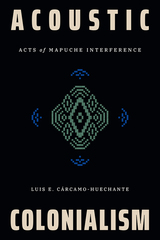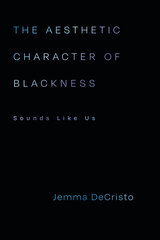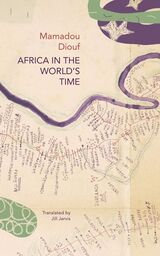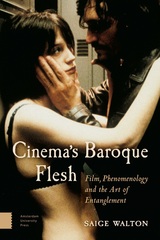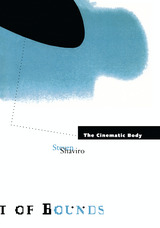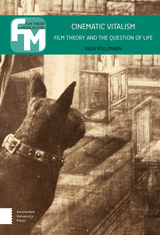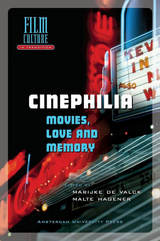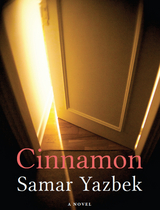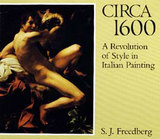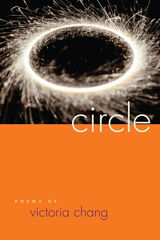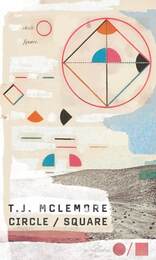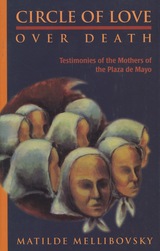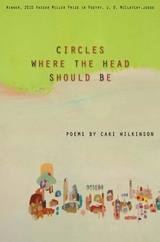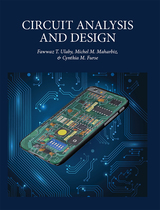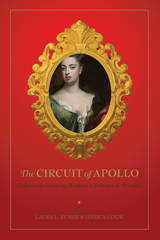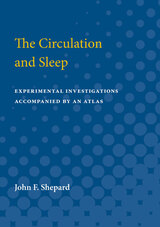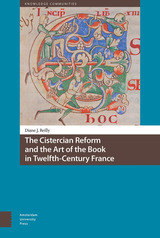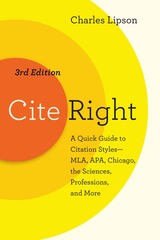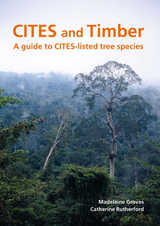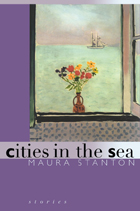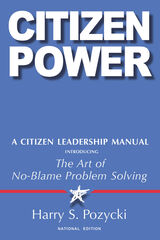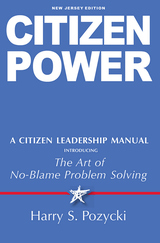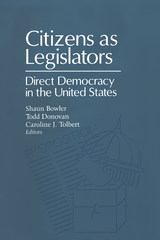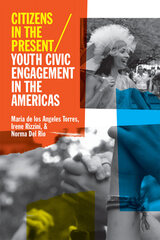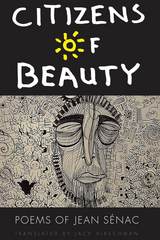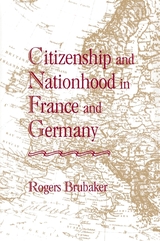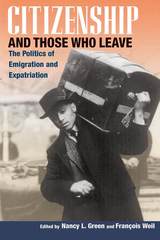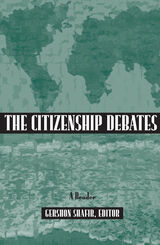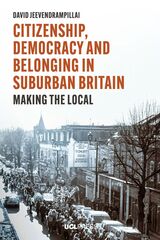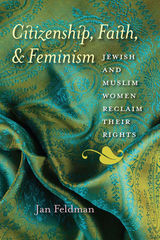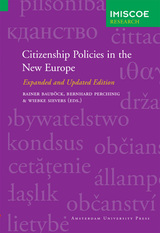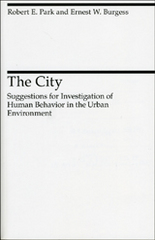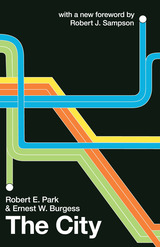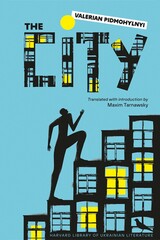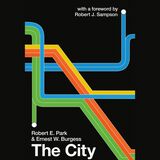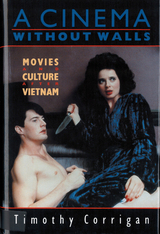 A Cinema Without Walls: Movies and Culture after Vietnam
Corrigan, Timothy
Rutgers University Press, 1991 "One of the sharpest and most productive analyses of our contemporaneity and the place of cinema within it and of our new historical relations as spectators to the imaginary universe on the movie screen. This is a study that will be of intense interest to film theorists and historians, cultural critics, mass media analysts, and anyone concerned with the complicated place of culture in our world today."--Dana Polan, English and Film Studies, University of Pittsburgh
How have modern advertising techniques, the widespread use of VCRs, conglomerate takeovers of studios and film archives, cable TV, and media coverage of the Vietnam war changed the ways we watch movies? And how, in turn, have those different habits and patterns of viewing changed the ways in which films address their viewers? Drawing on a wide variety of American and European films and on many theoretical models, Timothy Corrigan investigates what he calls "a cinema without walls," taking a close look at particular films in order to see how we watch them differently in the post-Vietnam era. He examines cult audiences, narrative structure, genre films (road movies, in particular), and contemporary politics as they engage new models of film making and viewing. He thus provides a rare, serious attempt to deal with contemporary movies. Corrigan discusses filmmakers from a variety of backgrounds and cultures, including Martin Scorsese, Raoul Ruiz, Michael Cimino, Alexander Kluge, Francis Ford Coppola, Stephen Frears, and Wim Wenders. He offers detailed analyses of films such as Platoon; Full Metal Jacket; 9-1/2 Weeks; The Singing Detective; Choose Me; After Hours; Badlands; The King of Comedy; Paris, Texas; and My Beautiful Laundrette. Orchestrating this diversity, Corrigan provides a critical basis for making sense of contemporary film culture and its major achievements.
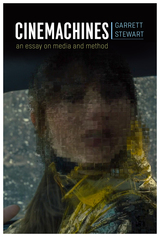 Cinemachines: An Essay on Media and Method
Garrett Stewart
University of Chicago Press, 2020 The hero stands on stage in high-definition 3-D while doubled on a crude pixel screen in Billy Lynn’s Long Halftime Walk. Alien ships leave Earth by dissolving at the conclusion of Arrival. An illusory death spiral in Vertigo transitions abruptly to a studio set, jolting the spectator. These are a few of the startling visual moments that Garrett Stewart examines in Cinemachines, a compelling, powerful, and witty book about the cultural and mechanical apparatuses that underlie modern cinema.
Engaging in fresh ways with revelatory special effects in the history of cinematic storytelling—from Buster Keaton’s breaching of the film screen in Sherlock Jr. to the pixel disintegration of a remotely projected hologram in Blade Runner 2049—Stewart’s book puts unprecedented emphasis on technique in moving image narrative. Complicating and revising the discourse on historical screen processes, Cinemachines will be crucial reading for anyone interested in the evolution of the movies from a celluloid to a digital medium.
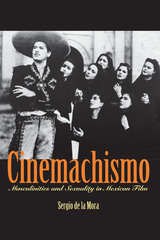 Cinemachismo: Masculinities and Sexuality in Mexican Film
By Sergio de la Mora
University of Texas Press, 2006 After the modern Mexican state came into being following the Revolution of 1910, hyper-masculine machismo came to be a defining characteristic of "mexicanidad," or Mexican national identity. Virile men (pelados and charros), virtuous prostitutes as mother figures, and minstrel-like gay men were held out as desired and/or abject models not only in governmental rhetoric and propaganda, but also in literature and popular culture, particularly in the cinema. Indeed, cinema provided an especially effective staging ground for the construction of a gendered and sexualized national identity. In this book, Sergio de la Mora offers the first extended analysis of how Mexican cinema has represented masculinities and sexualities and their relationship to national identity from 1950 to 2004. He focuses on three traditional genres (the revolutionary melodrama, the cabaretera [dancehall] prostitution melodrama, and the musical comedy "buddy movie") and one subgenre (the fichera brothel-cabaret comedy) of classic and contemporary cinema. By concentrating on the changing conventions of these genres, de la Mora reveals how Mexican films have both supported and subverted traditional heterosexual norms of Mexican national identity. In particular, his analyses of Mexican cinematic icons Pedro Infante and Gael García Bernal and of Arturo Ripstein's cult film El lugar sin límites illuminate cinema's role in fostering distinct figurations of masculinity, queer spectatorship, and gay male representations. De la Mora completes this exciting interdisciplinary study with an in-depth look at how the Mexican state brought about structural changes in the film industry between 1989 and 1994 through the work of the Mexican Film Institute (IMCINE), paving the way for a renaissance in the national cinema.
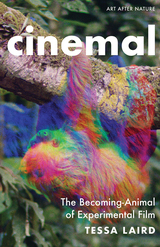 Cinemal: The Becoming-Animal of Experimental Film
Tessa Laird
University of Minnesota Press, 2025 A foray through the wilds where experimental films and animals collide
Like the flash of a tropical bird’s iridescent wing, cinema can be furtive and intensely beautiful—and it can leave a viewer craving more. Cinemal is Tessa Laird’s passionate inquiry into the ways that films mimic the majesty, mystery, and movements of animals,her field notes from countless hair-raising encounters with films in their natural habitat. Part of a growing focus on nonhuman animals in film, Cinemal ventures to the “furry underbelly” of global experimental film practice, focusing on films from New Zealand, Australia, and South America. Laird examines how animals are depicted in film and analyzes the various animal qualities of cinema, like scratching and sniffing, vibrant colors, and voices (barking, howling, or echolocation). Burrowing into the work of filmmakers such as Arthur and Corinne Cantrill, Sriwhana Spong, and Ana Vaz, Laird’s energetic prose embodies the films she discusses, seamlessly combining personal anecdotes with art theory and philosophy to spread a wide sensory buffet. Lively and optimistic, Laird uses cinematic animal tropes to encourage readers to rethink what it means to be human. She argues that, in a time of ecological collapse, such an impulse is a necessary means of imagining other, healthier ways of being in this world. Connecting us with the more-than-human, Cinemal lures us toward the beastly becomings of film and, ultimately, our own animal natures. Retail e-book files for this title are screen-reader friendly.
 Cinema’s Alchemist: The Films of Péter Forgács
Bill Nichols
University of Minnesota Press, 2011 Péter Forgács, based in Budapest, is best known for his award-winning films built on home movies from the 1930s to the 1960s that document ordinary lives soon to intersect with offscreen historical events. Cinema’s Alchemist offers a sustained exploration of the imagination and skill with which Forgács reshapes such film footage, originally intended for private and personal viewing, into extraordinary films dedicated to remembering the past in ways that matter for our future. Contributors: Whitney Davis, U of California, Berkeley; László F. Földényi, U of Theatre, Film and Television, Budapest; Marsha Kinder, U of Southern California; Tamás Korányi; Scott MacDonald, Hamilton College; Tyrus Miller, U of California, Santa Cruz; Roger Odin, U of Paris III Sorbonne–Nouvelle; Catherine Portuges, U of Massachusetts Amherst; Michael S. Roth, Wesleyan U; Kaja Silverman, U of Pennsylvania; Ernst van Alphen, Leiden U, the Netherlands; Malin Wahlberg, Stockholm U.
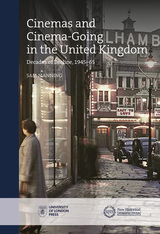 Cinemas and Cinema-Going in the United Kingdom: Decades of Decline, 1945–1965
Sam Manning
University of London Press, 2020 Cinema-going was the most popular commercial leisure activity in the United Kingdom during the first half of the twentieth century, with attendance growing significantly during World War II and peaking in 1946 with 1.6 billion recorded admissions. Though “going to the pictures” remained a popular pastime for the remainder of the forties, the transition from war to peacetime altered citizens’ leisure habits. During the fifties, a range of factors led to rapid declines in attendance, and by 1965, admissions had plummeted to 327 million.
Cinema attendance fell in all regions, but the speed, nature, and extent of this decline varied widely across the United Kingdom. By presenting detailed case studies of two similarly-sized industrial cities, Belfast and Sheffield, this book adds nuance and detail to the discussion of regional variations in film exhibition and audience habits. Using a wide range of sources, such as oral testimony, box-office data, newspapers, and trade journals, Cinemas and Cinema-Going in the United Kingdom conveys the diverse and ever-changing nature of the cinema industry.
Cinema's Baroque Flesh: Film, Phenomenology and the Art of Entanglement
Saige Walton
Amsterdam University Press, 2016 In Cinema's Baroque Flesh, Saige Walton draws on the philosophy of Maurice Merleau-Ponty to argue for a distinct aesthetic category of film and a unique cinema of the senses: baroque cinema. Combining media archaeological work with art history, phenomenology, and film studies, the book offers close analyses of a range of historic baroque artworks and films, including Caché, Strange Days, the films of Buster Keaton, and many more. Walton pursues previously unexplored connections between film, the baroque, and the body, opening up new avenues of embodied film theory that can make room for structure, signification, and thought, as well as the aesthetics of sensation.
 Cinema's Bodily Illusions: Flying, Floating, and Hallucinating
Scott C. Richmond
University of Minnesota Press, 2016 Do contemporary big-budget blockbuster films like Gravity move something in us that is fundamentally the same as what avant-garde and experimental films have done for more than a century? In a powerful challenge to mainstream film theory, Cinema’s Bodily Illusions demonstrates that this is the case. Scott C. Richmond bridges genres and periods by focusing, most palpably, on cinema’s power to evoke illusions: feeling like you’re flying through space, experiencing 3D without glasses, or even hallucinating. He argues that cinema is, first and foremost, a technology to modulate perception. He presents a theory of cinema as a proprioceptive technology: cinema becomes art by modulating viewers’ embodied sense of space. It works primarily not at the level of the intellect but at the level of the body. Richmond develops his theory through examples of direct perceptual illusion in cinema: hallucinatory flicker phenomena in Tony Conrad’s The Flicker, eerie depth effects in Marcel Duchamp’s Anémic Cinéma, the illusion of bodily movement through onscreen space in Stanley Kubrick’s 2001, Godfrey Reggio’s Koyaanisqatsi, and Alfonso Cuarón’s Gravity. In doing so he combines insights from Maurice Merleau-Ponty’s phenomenology of perception and James J. Gibson’s ecological approach to perception. The result is his distinctive ecological phenomenology, which allows us to refocus on the cinema’s perceptual, rather than representational, power. Arguing against modernist habits of mind in film theory and aesthetics, and the attendant proclamations of cinema’s death or irrelevance, Richmond demonstrates that cinema’s proprioceptive aesthetics make it an urgent site of contemporary inquiry.
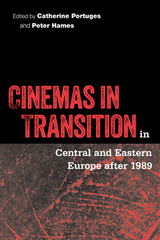 Cinemas in Transition in Central and Eastern Europe after 1989
Catherine Portuges
Temple University Press, 2013 The cinemas of Eastern and Central Europe have been moving away from earlier Cold War perspectives and iconographies toward identifications more closely linked to a redefined Europe. Cinemas in Transition in Central and Eastern Europe after 1989 studies the shifts in the dynamics between film production, exhibition, and reception in Eastern bloc countries as they moved from state-sponsored systems toward the free market.
The contributors and editors of this exciting volume examine the interrelations between thematic, aesthetic, and infrastructural changes; the globalization of the international cinema marketplace; and the problems and promises arising from the privatization of national cinemas.
Cinemas in Transition in Central and Eastern Europe after 1989 also addresses the strategies employed for preserving national cinemas and cultures through an analysis of films from the Czech and Slovak republics, the former German Democratic Republic, Hungary, Poland, Romania, Ukraine, and the former Yugoslavia. The study provides a picture of Eastern European cinema at a critical juncture as well as its connections to the emergent world of transnational media.
Contributors include Barton Byg, Alexandra Foamente, Andrew Horton, Dina Iordanova, Ewa Mazierska, Bohdan Y. Nebesio, and Bogdan Stefanescu,
 Cinemas of Bisexual Transgression
Jacob Engelberg
Duke University Press, 2026 In Cinemas of Bisexual Transgression, Jacob Engelberg makes the case for radically recalibrating queer film studies, taking as a starting point those cinematic figures who resist categorization within the gay-straight binary. Engelberg’s engagement with bisexual transgression on film illuminates the mutability and instability of sexuality, and of sociocultural structures more broadly by resisting the censure of images as politically harmful as well as the celebration of transgression as inherently subversive. Instead, Engelberg understands bisexual transgression as a process whereby sociocultural rules are made knowable by being contested. From 1970s vampire films to 1990s erotic thrillers, from lesbian imaginings of female bisexuality to European art cinema’s reckonings with HIV/AIDS, bisexual figures on film embody anxieties around the precarity of binary sexuality while revealing the contingencies of sexuality’s cinematic signification. Revivifying the underexploited contributions of bisexual theory, Cinemas of Bisexual Transgression proposes a new mode of film theorization and analysis that examines the rich space between and beyond dominant categories of sexual organization, where sexual unpredictability, the allure of the forbidden, and the precarity of sexual signification are illuminated.
 Cinemas of the Other: A Personal Journey with Film-Makers from Central Asia
Gönül Dönmez-Colin
Intellect Books, 2012 Updated collections of recent interviews with filmmakers whose works represent trends in the film industries of Central Asia and the Middle East, these two new geospecific editions expand upon the earlier volume Cinemas of the Other: A Personal Journey with Film-Makers from the Middle East and Central Asia. Following an introduction delineating the histories of the film industries of the countries that make up the Middle East and Central Asia—including Iran, Turkey, and the Central Asian republics of Kazakhstan, Kyrgyzstan, Tajikstan, Turkmenistan, and Uzbekistan—both books contain interviews stretching over a decade, which position the filmmakers and their creative concerns within the social or political context of their respective countries. The striking variety of approaches toward each interview creates a rich diversity of tone and opens the door to a better understanding of images of “otherness” in film. In addition to transcripts of the interviews, each chapter also includes stills from important films discussed, biographical information about the filmmakers, and filmographies of their works. Gönül Dönmez-Colin offers in these expanded editions a carefully researched and richly detailed firsthand account of the developments and trends in these regional film industries that is sure to be appreciated by film scholars and researchers of the Middle East and Central Asia.
 Cinemas of the Other: A Personal Journey with Film-Makers from Iran and Turkey
Gönül Dönmez-Colin
Intellect Books, 2012 Updated collections of recent interviews with filmmakers whose works represent trends in the film industries of Central Asia and the Middle East, these two new geospecific editions expand upon the earlier volume Cinemas of the Other: A Personal Journey with Film-Makers from the Middle East and Central Asia. Following an introduction delineating the histories of the film industries of the countries that make up the Middle East and Central Asia—including Iran, Turkey, and the Central Asian republics of Kazakhstan, Kyrgyzstan, Tajikstan, Turkmenistan, and Uzbekistan—both books contain interviews stretching over a decade, which position the filmmakers and their creative concerns within the social or political context of their respective countries. The striking variety of approaches toward each interview creates a rich diversity of tone and opens the door to a better understanding of images of “otherness” in film. In addition to transcripts of the interviews, each chapter also includes stills from important films discussed, biographical information about the filmmakers, and filmographies of their works. Gönül Dönmez-Colin offers in these expanded editions a carefully researched and richly detailed firsthand account of the developments and trends in these regional film industries that is sure to be appreciated by film scholars and researchers of the Middle East and Central Asia.
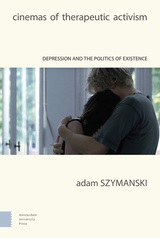 Cinemas of Therapeutic Activism: Depression and the Politics of Existence
Adam Szymanski
Amsterdam University Press, 2020 The hegemonic meaning of depression as a universal mental illness embodied by an individualized subject is propped up by psychiatry’s clinical gaze. Cinemas of Therapeutic Activism turns to the work of contemporary filmmakers who express a shared concern for mental health under global capitalism to explore how else depression can be perceived. In taking their critical visions as intercessors for thought, Adam Szymanski proposes a thoroughly relational understanding of depression attentive to eventful, collective and contingent qualities of subjectivity. What emerges is a melancholy aesthetics attuned to the existential contours and political stakes of health.
Cinemas of Therapeutic Activism adventurously builds affinities across the lines of national, linguistic and cultural difference. The films of Angela Schanelec, Kelly Reichardt, Apichatpong Weerasethakul and Kanakan Balintagos are grouped together for the first time, constituting a polystylistic common front of artist-physicians who live, work, and create on the belief that life can be more liveable.
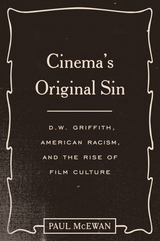 Cinema's Original Sin: D.W. Griffith, American Racism, and the Rise of Film Culture
Paul McEwan
University of Texas Press, 2022 For over a century, cinephiles and film scholars have had to grapple with an ugly artifact that sits at the beginnings of film history. D. W. Griffith’s profoundly racist epic, The Birth of a Nation, inspired controversy and protest at its 1915 release and was defended as both a true history of Reconstruction (although it was based on fiction) and a new achievement in cinematic art. Paul McEwan examines the long and shifting history of its reception, revealing how the film became not just a cinematic landmark but also an influential force in American aesthetics and intellectual life. In every decade since 1915, filmmakers, museums, academics, programmers, and film fans have had to figure out how to deal with this troublesome object, and their choices have profoundly influenced both film culture and the notion that films can be works of art. Some critics tried to set aside the film’s racism and concentrate on the form, while others tried to relegate that racism safely to the past. McEwan argues that from the earliest film retrospectives in the 1920s to the rise of remix culture in the present day, controversies about this film and its meaning have profoundly shaped our understandings of film, race, and art.
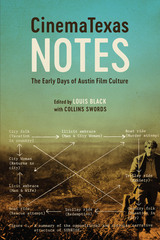 CinemaTexas Notes: The Early Days of Austin Film Culture
Edited by Louis Black, with Collins Swords
University of Texas Press, 2018 Austin’s thriving film culture, renowned for international events such as SXSW and the Austin Film Festival, extends back to the early 1970s when students in the Department of Radio-Television-Film at the University of Texas at Austin ran a film programming unit that screened movies for students and the public. Dubbed CinemaTexas, the program offered viewers a wide variety of films—old and new, mainstream, classic, and cult—at a time when finding and watching films after their first run was very difficult and prohibitively expensive. For each film, RTF graduate students wrote program notes that included production details, a sampling of critical reactions, and an original essay that placed the film and its director within context and explained the movie’s historical significance. Over time, CinemaTexas Program Notes became more ambitious and were distributed around the world, including to luminaries such as film critic Pauline Kael. This anthology gathers a sampling of CinemaTexas Program Notes, organized into four sections: “USA Film History,” “Hollywood Auteurs,” “Cinema-Fist: Renegade Talents,” and “America’s Shadow Cinema.” Many of the note writers have become prominent film studies scholars, as well as leading figures in the film, TV, music, and video game industries. As a collection, CinemaTexas Notes strongly contradicts the notion of an effortlessly formed American film canon, showing instead how local film cultures—whether in Austin, New York, or Europe—have forwarded the development of film studies as a discipline.
Cinematic Body
Steven Shaviro
University of Minnesota Press, 1993 In The Cinematic Body, Steven Shaviro proposes a radical new approach to film viewing. Moving between Jerry Lewis and Andy Warhol, between Fassbinder’s gay sex icons and George Romero’s flesh-eating zombies, The Cinematic Body cuts across disciplinary boundaries and seeks to engage new currents in critical thought. Shaviro radically critiques the Lacanian model currently popular in film theory and film studies, arguing against that model’s obsessive emphasis on the phallus, castration anxiety, sadistic master, ideology, and the structure of the signifier. In this groundbreaking volume, Shaviro effectively communicates a sense of the inescapable ambivalence and intensities of contemporary culture, ultimately affirming a thoroughly postmodern sensibility.
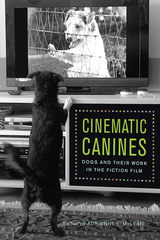 Cinematic Canines: Dogs and Their Work in the Fiction Film
McLean, Adrienne L
Rutgers University Press, 2014 Dogs have been part of motion pictures since the movies began. They have been featured onscreen in various capacities, from any number of “man’s best friends” (Rin Tin Tin, Asta, Toto, Lassie, Benji, Uggie, and many, many more) to the psychotic Cujo. The contributors to Cinematic Canines take a close look at Hollywood films and beyond in order to show that the popularity of dogs on the screen cannot be separated from their increasing presence in our lives over the past century.
The representation and visualization of dogs in cinema, as of other animals, has influenced our understanding of what dogs “should” do and be, for us and with us. Adrienne L. McLean expertly shepherds these original essays into a coherent look at “real” dogs in live-action narrative films, from the stars and featured players to the character and supporting actors to those pooches that assumed bit parts or performed as extras. Who were those dogs, how were they trained, what were they made to do, how did they participate as characters in a fictional universe? These are a just a few of the many questions that she and the outstanding group of scholars in this book have addressed.
Often dogs are anthropomorphized in movies in ways that enable them to reason, sympathize, understand and even talk; and our shaping of dogs into furry humans has had profound effects on the lives of dogs off the screen. Certain breeds of dog have risen in popularity following their appearance in commercial film, often to the detriment of the dogs themselves, who rarely correspond to their idealized screen versions. In essence, the contributors in Cinematic Canines help us think about and understand the meanings of the many canines that appear in the movies and, in turn, we want to know more about those dogs due in no small part to the power of the movies themselves.
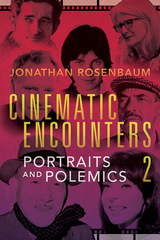 Cinematic Encounters 2: Portraits and Polemics
Jonathan Rosenbaum
University of Illinois Press, 2019 Eschewing the idea of film reviewer-as-solitary-expert, Jonathan Rosenbaum continues to advance his belief that a critic's ideal role is to mediate and facilitate our public discussion of cinema. Portraits and Polemics presents debate as an important form of cinematic encounter whether one argues with filmmakers themselves, on behalf of their work, or with one's self. Rosenbaum takes on filmmakers like Chantal Akerman, Richard Linklater, Manoel De Oliveira, Mark Rappaport, Elaine May, and Béla Tarr. He also engages, implicitly and explicitly, with other writers, arguing with Pauline Kael—and Wikipedia—over Jacques Demy, with the Hollywood Reporter and Variety reviewers of Jarmusch’s The Limits of Control, with David Thomson about James L. Brooks, and with many American and English film critics about misrepresented figures from Jerry Lewis to Yasujiro Ozu to Orson Welles. Throughout, Rosenbaum mines insights, pursues pet notions, and invites readers to join the fray.
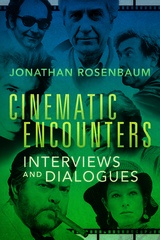 Cinematic Encounters: Interviews and Dialogues
Jonathan Rosenbaum
University of Illinois Press, 2018 Godard. Fuller. Rivette. Endfield. Tarr. In his celebrated career as a film critic, Jonathan Rosenbaum has undertaken wide-ranging dialogues with many of the most daring and important auteurs of our time. Cinematic Encounters collects more than forty years of interviews that embrace Rosenbaum's vision of film criticism as a collaboration involving multiple voices. Rosenbaum accompanies Orson Welles on a journey back to Heart of Darkness, the unmade film meant to be Welles's Hollywood debut. Jacques Tati addresses the primacy of décor and soundtrack in his comedic masterpiece PlayTime, while Jim Jarmusch explains the influence of real and Hollywoodized Native Americans in Dead Man. By arranging the chapters chronologically, Rosenbaum invites readers to pursue thematic threads as if the discussions were dialogues between separate interviews. The result is a rare gathering of filmmakers trading thoughts on art and process, on great works and false starts, and on actors and intimate moments.
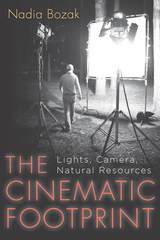 The Cinematic Footprint: Lights, Camera, Natural Resources
Bozak, Nadia
Rutgers University Press, 2011 Film is often used to represent the natural landscape and, increasingly, to communicate environmentalist messages. Yet behind even today’s “green” movies are ecologically unsustainable production, distribution, and consumption processes. Noting how seemingly immaterial moving images are supported by highly durable resource-dependent infrastructures, The Cinematic Footprint traces the history of how the “hydrocarbon imagination” has been central to the development of film as a medium. Nadia Bozak’s innovative fusion of film studies and environmental studies makes provocative connections between the disappearance of material resources and the emergence of digital media—with examples ranging from early cinema to Dziga Vertov’s prescient eye, from Chris Marker’s analog experiments to the digital work of Agnès Varda, James Benning, and Zacharias Kunuk. Combining an analysis of cinema technology with a sensitive consideration of film aesthetics, The Cinematic Footprint offers a new perspective on moving images and the natural resources that sustain them.
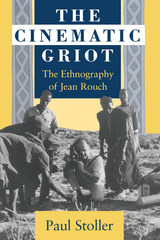 The Cinematic Griot: The Ethnography of Jean Rouch
Paul Stoller
University of Chicago Press, 1992 The most prolific ethnographic filmmaker in the world, a pioneer of cinéma vérité and one of the earliest ethnographers of African societies, Jean Rouch (1917-) remains a controversial and often misunderstood figure in histories of anthropology and film. By examining Rouch's neglected ethnographic writings, Paul Stoller seeks to clarify the filmmaker's true place in anthropology.
A brief account of Rouch's background, revealing the ethnographic foundations and intellectual assumptions underlying his fieldwork among the Songhay of Niger in the 1940s and 1950s, sets the stage for his emergence as a cinematic griot, a peripatetic bard who "recites" the story of a people through provocative imagery. Against this backdrop, Stoller considers Rouch's writings on Songhay history, myth, magic and possession, migration, and social change. By analyzing in depth some of Rouch's most important films and assessing Rouch's ethnography in terms of his own expertise in Songhay culture, Stoller demonstrates the inner connection between these two modes of representation.
Stoller, who has done more fieldwork among the Songhay than anyone other than Rouch himself, here gives the first full account of Rouch the griot, whose own story scintillates with important implications for anthropology, ethnography, African studies, and film.
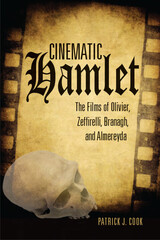 Cinematic Hamlet: The Films of Olivier, Zeffirelli, Branagh, and Almereyda
Patrick J. Cook
Ohio University Press, 2011 Hamlet has inspired four outstanding film adaptations that continue to delight a wide and varied audience and to offer provocative new interpretations of Shakespeare’s most popular play. Cinematic Hamlet contains the first scene-by-scene analysis of the methods used by Laurence Olivier, Franco Zeffirelli, Kenneth Branagh, and Michael Almereyda to translate Hamlet into highly distinctive and remarkably effective films. Applying recent developments in neuroscience and psychology, Patrick J. Cook argues that film is a medium deploying an abundance of devices whose task it is to direct attention away from the film’s viewing processes and toward the object represented. Through careful analysis of each film’s devices, he explores the ways in which four brilliant directors rework the play into a radically different medium, engaging the viewer through powerful instinctive drives and creating audiovisual vehicles that support and complement Shakespeare’s words and story. Cinematic Hamlet will prove to be indispensable for anyone wishing to understand how these films rework Shakespeare into the powerful medium of film.
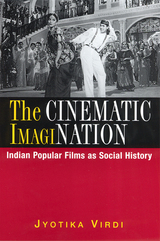 The Cinematic ImagiNation: Indian Popular Films as Social History
Virdi, Jyotika
Rutgers University Press, 2003 "This book makes an important contribution to the field of Asian film criticism, Indian film history, cultural studies, and gender studies. The Cinematic ImagiNation provides readers with valuable insight into the relationships between nation-building, gender, sexuality, the family, and popular cinema, using post-Independence India as a case study."
--Gina Marchetti, author of Romance and the "Yellow Peril": Race, Sex, and Discursive Strategies in Hollywood Fiction
India produces more films than any other country in the world, and these works are avidly consumed by non-Western cultures in Africa, Eastern Europe, the Middle East, and by the Indian communities in Australia, Britain, the Caribbean Islands, and North America. Jyotika Virdi focuses on how this dominant medium configures the "nation" in post-Independence Hindi cinema. She scrutinizes approximately thirty films that have appeared since 1950 and demonstrates how concepts of the nation form the center of this cinema's moral universe. As a kind of storytelling, Indian cinema provides a fascinating account of social history and cultural politics, with the family deployed as a symbol of the nation. Virdi demonstrates how the portrayal of the nation as a mythical community in Hindi films collapses under the weight of its own contradictions--irreconcilable differences that encompass gender, sexuality, family, class, and religious communities. Through these film narratives, the author traces transactions among the various constituencies that struggle, accommodate, coexist uneasily, or reconstitute each other over time, and, in the process, reveal the topography of postcolonial culture.
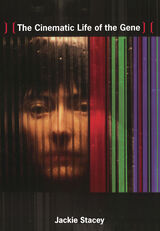 The Cinematic Life of the Gene
Jackie Stacey
Duke University Press, 2010 What might the cinema tell us about how and why the prospect of cloning disturbs our most profound ideas about gender, sexuality, difference, and the body? In The Cinematic Life of the Gene, the pioneering feminist film theorist Jackie Stacey argues that as a cultural technology of imitation, cinema is uniquely situated to help us theorize “the genetic imaginary,” the constellation of fantasies that genetic engineering provokes. Since the mid-1990s there has been remarkable innovation in genetic engineering and a proliferation of films structured by anxieties about the changing meanings of biological and cultural reproduction. Bringing analyses of several of these films into dialogue with contemporary cultural theory, Stacey demonstrates how the cinema animates the tropes and enacts the fears at the heart of our genetic imaginary. She engages with film theory; queer theories of desire, embodiment, and kinship; psychoanalytic theories of subject formation; and debates about the reproducibility of the image and the shift from analog to digital technologies. Stacey examines the body-horror movies Alien: Resurrection and Species in light of Jean Baudrillard’s apocalyptic proclamations about cloning and “the hell of the same,” and she considers the art-house thrillers Gattaca and Code 46 in relation to ideas about imitation, including feminist theories of masquerade, postcolonial conceptualizations of mimicry, and queer notions of impersonation. Turning to Teknolust and Genetic Admiration, independent films by feminist directors, she extends Walter Benjamin’s theory of aura to draw an analogy between the replication of biological information and the reproducibility of the art object. Stacey suggests new ways to think about those who are not what they appear to be, the problem of determining identity in a world of artificiality, and the loss of singularity amid unchecked replication.
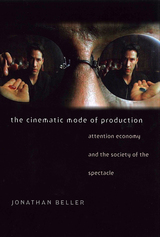 The Cinematic Mode of Production: Attention Economy and the Society of the Spectacle
Jonathan Beller
Dartmouth College Press, 2006 “Cinema brings the industrial revolution to the eye,” writes Jonathan Beller, “and engages spectators in increasingly dematerialized processes of social production.” In his groundbreaking critical study, cinema is the paradigmatic example of how the act of looking has been construed by capital as “productive labor.” Through an examination of cinema over the course of the twentieth century, Beller establishes on both theoretical and historical grounds the process of the emergent capitalization of perception. This process, he says, underpins the current global economy. By exploring a set of films made since the late 1920s, Beller argues that, through cinema, capital first posits and then presupposes looking as a value-productive activity. He argues that cinema, as the first crystallization of a new order of media, is itself an abstraction of assembly-line processes, and that the contemporary image is a politico-economic interface between the body and capitalized social machinery. Where factory workers first performed sequenced physical operations on moving objects in order to produce a commodity, in the cinema, spectators perform sequenced visual operations on moving montage fragments to produce an image. Beller develops his argument by highlighting various innovations and film texts of the past century. These innovations include concepts and practices from the revolutionary Soviet cinema, behaviorism, Taylorism, psychoanalysis, and contemporary Hollywood film. He thus develops an analysis of what amounts to the global industrialization of perception that today informs not only the specific social functions of new media, but also sustains a violent and hierarchical global society.
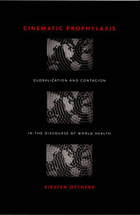 Cinematic Prophylaxis: Globalization and Contagion in the Discourse of World Health
Kirsten Ostherr
Duke University Press, 2005 A timely contribution to the fields of film history, visual cultures, and globalization studies, Cinematic Prophylaxis provides essential historical information about how the representation of biological contagion has affected understandings of the origins and vectors of disease. Kirsten Ostherr tracks visual representations of the contamination of bodies across a range of media, including 1940s public health films; entertainment films such as 1950s alien invasion movies and the 1995 blockbuster Outbreak; television programs in the 1980s, during the early years of the aids epidemic; and the cyber-virus plagued Internet. In so doing, she charts the changes—and the alarming continuities—in popular understandings of the connection between pathologized bodies and the global spread of disease. Ostherr presents the first in-depth analysis of the public health films produced between World War II and the 1960s that popularized the ideals of world health and taught viewers to imagine the presence of invisible contaminants all around them. She considers not only the content of specific films but also their techniques for making invisible contaminants visible. By identifying the central aesthetic strategies in films produced by the World Health Organization, the Centers for Disease Control, and other institutions, she reveals how ideas about racial impurity and sexual degeneracy underlay messages ostensibly about world health. Situating these films in relation to those that preceded and followed them, Ostherr shows how, during the postwar era, ideas about contagion were explicitly connected to the global circulation of bodies. While postwar public health films embraced the ideals of world health, they invoked a distinct and deeply anxious mode of representing the spread of disease across national borders.
The Cinematic Sublime: Negative Pleasures, Structuring Absences
Edited by Nathan Carroll
Intellect Books, 2020 An anthology that applies the concept of the sublime to cinema.
This interdisciplinary volume bridges the disciplines of aesthetics and film studies through an exploration of the cinematic sublime. The works collected here, written by contemporary film scholars and philosophers, apply sublime aesthetics to various film topics and case studies, ranging from early cinema and classical Hollywood to avant-garde film and contemporary digital cinema. Original and wide-ranging, The Cinematic Sublime offers new and exciting insights into how cinema engages with traditional historical and aesthetic discourse, and it will prove a useful resource for both post-graduate students and established scholars interested in the interrelations between film and philosophy.
 Cinematic Uses of the Past
Marcia Landy
University of Minnesota Press, 1996 Cinematic Uses of the Past was first published in 1996. Minnesota Archive Editions uses digital technology to make long-unavailable books once again accessible, and are published unaltered from the original University of Minnesota Press editions. From the first, cinema has sustained a romance with the past. The nature of this attachment, and what it reveals about our culture, is the subject of Marcia Landy's book. Cinematic Uses of the Past looks at British, American, Italian, and African films for what they can tell us about popular history and our cultural investment in certain images of the past. Landy peruses six different moments in the history of cinema, employing the theories of Nietzsche and Gramsci. Her reading of these films explores their investments in history and memory in relation to ideas of nation, sexuality, gender, and race. Among the films she discusses are A Fistful of Dynamite, The Scarlet Empress, Dance with a Stranger, Holocaust, Schindler's List, Le camp de Thiaroye, Guelwaar, The Leopard, and Veronika Voss. A thoroughly compelling reading of these emblematic films, Cinematic Uses of the Past is also a revealing interpretation of popular history, exposing the fragmentary, tentative, and invested nature of cultural memory. Marcia Landy is professor of literature and film studies at the University of Pittsburgh. She is the author of several books, including Film, Politics, and Gramsci (Minnesota, 1995).
Cinematic Vitalism: Film Theory and the Question of Life
Inga Pollmann
Amsterdam University Press, 2018 This book argues that there are constitutive links between early twentieth-century German and French film theory and practice, on the one hand, and vitalist conceptions of life in biology and philosophy, on the other. By considering classical film-theoretical texts and their filmic objects in the light of vitalist ideas percolating in scientific and philosophical texts of the time, Cinematic Vitalism reveals the formation of a modernist, experimental and cinematic strand of vitalism in and around the movie theater. The book focuses on the key concepts including rhythm, environment, mood, and development to show how the cinematic vitalism articulated by film theorists and filmmakers maps out connections among human beings, milieus, and technologies that continue to structure our understanding of film.
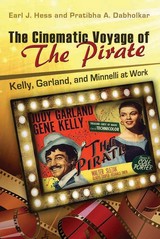 The Cinematic Voyage of THE PIRATE: Kelly, Garland, and Minnelli at Work
Earl J. Hess and Pratibha A. Dabholkar
University of Missouri Press, 2014 During Metro-Goldwyn-Mayer’s glory days, the studio’s famous Arthur Freed Unit made an extraordinary string of dazzling musicals. One of its very best was The Pirate. Based on a successful 1942 Broadway production, the film was directed by Vincente Minnelli and starred Gene Kelly and Judy Garland. It showcased some of the brightest work of these three gifted moviemakers and entranced many critics and viewers with exotic set décor and costumes, brilliant Technicolor application, stunning dance routines, and a clever plot about an actor who pretends to be a famous pirate to win the love of a fanciful island girl. The Cinematic Voyage of The Pirate: Kelly, Garland, and Minnelli at Work follows the model of Hess and Dabholkar’s previous study of Singin’ in the Rain. Drawing on exhaustive research in archives, memoirs, interviews, and newspaper coverage, it takes the reader from the original conception of the story in the mind of a German playwright named Ludwig Fulda, through S. N. Behrman’s Broadway production starring Alfred Lunt and Lynn Fontanne, to the arduous task of crafting a suitable screenplay at MGM. Behind-the-scenes issues such as Garland’s personal problems during the making of the film and the shaping of the film by Minnelli and Kelly are among the many subjects detailed here. While the initial reception of The Pirate reinforced hopes for its success, many audiences did not understand the film’s tongue-in-cheek aspect, and some critical reviews were mixed. This shaded the perception of the film and its significance. As this careful study shows, The Pirate was a commercial and critical success despite some early misperceptions. The movie made a small profit for MGM, and the film grew in public appeal over time. The Pirate has been studied by film historians, gender studies scholars, and film studies professionals since it was released in 1948. The Cinematic Voyage of The Pirate contributes to a growing literature asserting the importance of single-film production history and the significance of the film musical in the golden age of Hollywood.
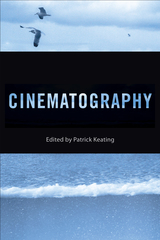 Cinematography
Keating, Patrick
Rutgers University Press, 2014 How does a film come to look the way it does? And what influence does the look of a film have on our reaction to it? The role of cinematography, as both a science and an art, is often forgotten in the chatter about acting, directing, and budgets. The successful cinematographer must have a keen creative eye, as well as expert knowledge about the constantly expanding array of new camera, film, and lighting technologies. Without these skills at a director’s disposal, most movies quickly fade from memory. Cinematography focuses on the highlights of this art and provides the first comprehensive overview of how the field has rapidly evolved, from the early silent film era to the digital imagery of today.
The essays in this volume introduce us to the visual conventions of the Hollywood style, explaining how these first arose and how they have subsequently been challenged by alternative aesthetics. In order to frame this fascinating history, the contributors employ a series of questions about technology (how did new technology shape cinematography?), authorship (can a cinematographer develop styles and themes over the course of a career?), and classicism (how should cinematographers use new technology in light of past practice?). Taking us from the hand-cranked cameras of the silent era to the digital devices used today, the collection of original essays explores how the art of cinematography has been influenced not only by technological advances, but also by trends in the movie industry, from the rise of big-budget blockbusters to the spread of indie films.
The book also reveals the people behind the camera, profiling numerous acclaimed cinematographers from James Wong Howe to Roger Deakins. Lavishly illustrated with over 50 indelible images from landmark films, Cinematography offers a provocative behind-the-scenes look at the profession and a stirring celebration of the art form. Anyone who reads this history will come away with a fresh eye for what appears on the screen because of what happens behind it.
 Cine-Mobility: Twentieth-Century Transformations in Korea’s Film and Transportation
Han Sang Kim
Harvard University Press, 2022 In 1916, a group of Korean farmers and their children gathered to watch a film depicting the enthronement of the Japanese emperor. For this screening, a unit of the colonial government’s news agency brought a projector and generator by train to their remote rural town. Before the formation of commercial moviegoing culture for colonial audiences in rural Korean towns, many films were sent to such towns and villages as propaganda. The colonial authorities, as well as later South Korean postcolonial state authorities, saw film as the most effective medium for disseminating their political messages. In Cine-Mobility, Han Sang Kim argues that the force of propaganda films in Korea was derived primarily not from their messages but from the new mobility of the viewing position.
From the first film shot in Korea in 1901 through early internet screen cultures in late 1990s South Korea, Cine-Mobility explores the association between cinematic media and transportation mobility, not only in diverse and discrete forms such as railroads, motorways, automobiles, automation, and digital technologies, but also in connection with the newly established rules and restrictions and the new culture of mobility, including changes in gender dynamics, that accompanied it.
Cine-Mobility: Twentieth-Century Transformations in Korea’s Film and Transportation
Han Sang Kim
Harvard University Press In Cine-Mobility, Han Sang Kim argues that the force of propaganda films in Korea were derived primarily from the new mobility afforded by transportation. Kim explores the association between cinematic media and transportation mobility, and its connection with the new culture of mobility, including changes in gender dynamics, that accompanied it.
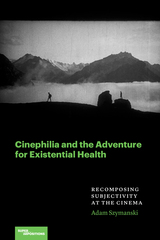 Cinephilia and the Adventure for Existential Health: Recomposing Subjectivity at the Cinema
Adam Szymanski
Northwestern University Press, 2025 Exploring how art cinema cultivates existential health through the films of Olivier Assayas
This book proposes that cinephilia can facilitate existential health, which makes palpable the potential for subjectivity to be recomposed through meaningful encounters with cinema. Adam Szymanskidraws on the ethos of psychoanalyst Félix Guattari and thinks with select films from director Olivier Assayas—including Clouds of Sils Maria and Personal Shopper—to theorize how the cinema can be invested with therapeutic value. Cinephilia and the Adventure for Existential Health engages the history of psychoanalytic film theory, excavates its long-standing concern with the production of spectatorial subjectivity, and challenges pathologizing understandings of cinema spectatorship couched in identification, fetishism, and voyeurism. By embracing the indeterminacy of the cinematic experience and the adventurous disposition of cinephilia, the book allies itself to the pursuit of collective health and challenges the logic of medical power.
Cinephilia: Movies, Love and Memory
Edited by Marijke de Valck and Malte Hagener
Amsterdam University Press, 2005 They obsess over the nuances of a Douglas Sirk or Ingmar Bergman film; they revel in books such as François Truffaut's Hitchcock; they happily subscribe to the Sundance Channel—they are the rare breed known as cinephiles. Though much has been made of the classic era of cinephilia from the 1950s to the 1970s, Cinephilia documents the latest generation of cinephiles and their use of new technologies. With the advent of home theaters, digital recording devices, online film communities, cinephiles today pursue their dedication to film outside of institutional settings. A radical new history of film culture, Cinephilia breaks new ground for students and scholars alike.
Cinnamon
Samar Yazbek
Haus Publishing, 2012 In the dark of night, Hanan al-Hashimi awakens from a nightmare, confused and shaken. Roaming the house in search of some reassurance, she is drawn towards the streak of light under her husband's bedroom door. Little does she know that the beckoning glow will turn her life on its head...
The CIO Challenge to the AFL: A History of the American Labor Movement, 1935–1941
Walter Galenson
Harvard University Press The period immediately preceding World War II was probably the most critical in the history of the American labor movement. Prior to 1936, the trade unions were weak, but by 1941 a fundamental change in power relationships enabled them to penetrate the strongholds of American industry—steel and automobiles.
The CIO Challenge to the AFL is a three-part study. It discusses the split in the American Federation of Labor and the formation of the Congress of Industrial Organizations; presents eighteen specific industry or union case studies, each an independent essay in economic history; and, finally, analyzes various general aspects of the labor movement.
Circa 1600: A Revolution of Style in Italian Painting
S. J. Freedberg
Harvard University Press, 1983 A distinguished art historian examines a radical change in style that occurred around 1600, a change that turned the whole course of Italian painting—and, through its influence, the painting of other European countries as well—from the Mannerism of the late sixteenth century to the grand achievements of the Baroque. The principal authors of the change were three artists of North Italian origin: Annibale Carracci, Caravaggio, and Ludovico Carracci. S. J. Freedberg defines the particular qualities of each artist’s work and traces the intellectual, visual, and technical evolution of their style.
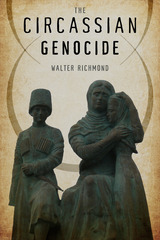 The Circassian Genocide
Richmond, Walter
Rutgers University Press, 2013 Circassia was a small independent nation on the northeastern shore of the Black Sea. For no reason other than ethnic hatred, over the course of hundreds of raids the Russians drove the Circassians from their homeland and deported them to the Ottoman Empire. At least 600,000 people lost their lives to massacre, starvation, and the elements while hundreds of thousands more were forced to leave their homeland. By 1864, three-fourths of the population was annihilated, and the Circassians had become one of the first stateless peoples in modern history.
Using rare archival materials, Walter Richmond chronicles the history of the war, describes in detail the final genocidal campaign, and follows the Circassians in diaspora through five generations as they struggle to survive and return home. He places the periods of acute genocide, 1821–1822 and 1863–1864, in the larger context of centuries of tension between the two nations and updates the story to the present day as the Circassian community works to gain international recognition of the genocide as the region prepares for the 2014 Winter Olympics in Sochi, the site of the Russians’ final victory.
Circle
Victoria Chang
Southern Illinois University Press, 2005 Taking its concept of concentricity from the eponymous Ralph Waldo Emerson essay, Circle, the first collection from Victoria Chang, adopts the shape as a trope for gender, family, and history. These lyrical, narrative, and hybrid poems trace the spiral trajectory of womanhood and growth and plot the progression of self as it ebbs away from and returns to its roots in an Asian American family and context. Locating human desire within the helixes of politics, society, and war, Chang skillfully draws arcs between T’ang Dynasty suicides and Alfred Hitchcock leading ladies, between the Hong Kong Flower Lounge and an all-you-can-eat Sunday brunch, the Rape of Nanking and civilian casualties in Iraq.
Circle / Square
T.J. Mclemore
Autumn House Press, 2020 Throughout Circle / Square, T. J. McLemore renders the language of physics and theoretical science into poetry to illuminate the mysterious ways we experience reality. Exploring the complex and at-times dense world of scientific language, MeLemore spins into verse the kind of material many poets might shy away from. Throughout the chapbook, the poet begins from theoretical physics and other realms of science to continue poetry’s endless search to define, explore, and represent the world truthfully through deep attention to language and form. Neutrinos, string theory, thermodynamics, and quantum entanglement become meditations and tools for self-examination as McLemore finds new ways to revel in and represent physical existence. Drawing from highly technical scientific materials, McLemore has crafted poems that are thoughtful, grounding, and expressively charged, leading readers through divine moments of wonder and contemplation.
 The Circle Dance of Time
John S. Dunne
University of Notre Dame Press, 2010
"There is nothing wiser than the circle," Rilke says in his Stories of God. John Dunne's new book explores the wisdom of the circle. He uses the metaphor of the circle dance, a folk dance in which the women form an inner circle, holding hands and moving clockwise; the men form an outer circle, moving counterclockwise. When the music stops the person opposite you is your partner for the next dance. Dunne interprets the circle as the great circle of life and light and love that comes from God and returns to God.
Dunne emphasizes the far point on the circle, farthest away from God, and uses that to discuss the difficulties of our secular age. In the individual life, the far point is a dark night of the soul. Yet Dunne sees that far point of loneliness and darkness as a point as well, marking the return to love and light. So the theme of the book is like the words of an old Bedouin to Lawrence of Arabia, "The love is from God, and of God, and towards God." The book concludes with the words of twenty-one "Circle Songs," composed by the author.
Circle of Love Over Death: The Story of the Mothers of the Plaza de Mayo
Matilde Mellibovsky
Northwestern University Press, 1996 In Circle of Love Over Death, Matilde Mellibovsky documents the testimonies of mothers whose children were stripped from them in Argentina during the turbulent 1970s. She not only describes the personal anguish of families over the torture, death or "disappearance" of their children, but also shows how the women gave emotional support to each other and the way in which, since 1976, they slowly but surely organized and built an international movement.
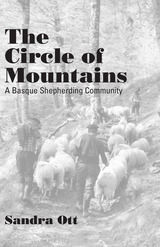 The Circle of Mountains: A Basque Shepherding Community
Sandra Ott
University of Nevada Press, 1993 Ott provides an excellent ethnography of a French Basque agrarian and sheepherding community. The commune of Sainte-Engrâce extends along a mountain valley in the southeastern corner of Soule, one of the three Basque provences in France. In The Circle of Mountains, Sandra Ott examines the importance of cooperation and reciprocity as the essential basis for the main institutions within this community. These French Basques visualize their community as a circle, and their vision of living in "the circle of mountians," rather than in a valley, reflects their perspective on the society in which they live. The first half of the book incorporates material on history, ecology and economy, and delves deeply into the domestic organization, kinship, and neighborliness of this Basque community. In the second half of the book, the author introduces the males' customary roles as shepherds and cheesemakers. Following a detailed commentary on these vocations, Ott suggests that these seemingly prosaic activities represent the male attempt at symbolic fulfillment of the female procreative and nurturing roles. In a new afterword, Ott discusses developments that have impacted life in the pastoral community of Sainte-Engrâce since the original publication of the book—including the acquisition of telephones and the construction of roads to nearly every home.The Circle of Mountains will be of interest not only to social anthropologists but also to those concerned with the Basque language and culture and to scholars and students of ethnology, international studies, and political science.
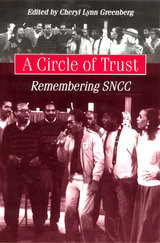 A Circle of Trust: Remembering SNCC
Greenberg, Cheryl L
Rutgers University Press, 1998 Activists and historians reflect together on the civil rights movement and its meanings, and on the Student Nonviolent Coordinating Committee's place in American history. "The reminiscences and reflections voiced at the SNCC reunion remind us of the remarkable vision and courageous dedication of the civil rights movement of the 1960s. Framed by Cheryl Greenberg's eloquent and probing introduction, the SNCC veterans' comments about the triumphs and limitations of their movement represent a major contribution to the historical literature on race and power in modern America." --Raymond Arsenault, University of South Florida On the occasion of the SNCC's 25th anniversary, more than 500 people gathered at Trinity College in Connecticut to both celebrate and critique its accomplishments. More than 40 SNCC members tell their stories and reflect on the contributions, limits and legacies of the movement in A Circle of Trust. Engaging in spirited debate with each other, with historians of the movement, and with contemporary political culture more broadly, these former and perpetual activists speak of their vision of a just society and what still remains to be done. With increasing racial tension and the continued debate over integration and separatism in America in the 1990s, the content of this conference is more relevant than ever. Cheryl Lynn Greenberg begins with an overview of SNCC and introduces each of the chapters of oral history. Participants explore the origins of SNCC, its early adoption of nonviolent protest, its ultimate renunciation of liberal integration and embrace of militant black radicalism, its refusal to repudiate far-left organizations, and controversies over the roles of women in SNCC and society at large. The result is a thoughtful, moving, sometimes acrimonious, sometimes celebratory account of one of the most significant civil rights organizations and its successes and failures.
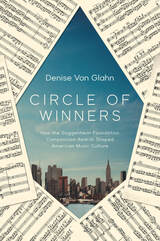 Circle of Winners: How the Guggenheim Foundation Composition Awards Shaped American Music Culture
Denise Von Glahn
University of Illinois Press, 2023 An essential high culture institution, the John Simon Guggenheim Memorial Foundation has both supported and molded American musical culture. Denise Von Glahn examines the Foundation and its immense influence from the organization’s prehistory and origins through the onset of World War II. Funded by the Guggenheim mining fortune, the Foundation took early shape from the efforts of Carroll Wilson, Frank Aydelotte, and Henry Allen Moe--three Rhodes Scholars who initially struggled to envision and implement the organization’s ambitious goals. Von Glahn also examines the career of the longtime musical advisor Thomas Whitney Surette while profiling early awardees Aaron Copland, Ruth Crawford Seeger, William Grant Still, Roger Sessions, George Antheil, and Carlos Chàvez. She examines the processes behind their selection, their values and aesthetics, and their relationships with the insiders and others who championed their work.
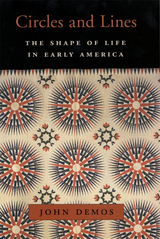 Circles and Lines: The Shape of Life in Early America
John Demos
Harvard University Press, 2004 In this intimate, engaging book, John Demos offers an illuminating portrait of how colonial Americans, from the first settlers to the postrevolutionary generation, viewed their life experiences. He also offers an invaluable inside look into the craft of a master social historian as he unearths--in sometimes unexpected places--fragments of evidence that help us probe the interior lives of people from the faraway past.
The earliest settlers lived in a traditional world of natural cycles that shaped their behavior: day and night; seasonal rhythms; the lunar cycle; the life cycle itself. Indeed, so basic were these elements that "almost no one felt a need to comment on them." Yet he finds cyclical patterns--in the seasonal foods they ate, in the spike in marriages following the autumn harvest. Witchcraft cases reveal the different emotional reactions to day versus night, as accidental mishaps in the light become fearful nighttime mysteries. During the transitional world of the American Revolution, people began to see their society in newer terms but seemed unable or unwilling to come to terms with that novelty. Americans became new, Demos points out, before they fully understood what it meant. Their cyclical frame of reference was coming unmoored, giving way to a linear world view in early nineteenth-century America that is neatly captured by Kentucky doctor Daniel Drake's description of the chronography of his life.
In his meditation on these three worlds, Demos brilliantly demonstrates how large historical forces are reflected in individual lives. With the imaginative insights and personable touch that we have come to expect from this fine chronicler of the human condition, Circles and Lines is vintage John Demos.
 Circle's Apprentice
Dan Beachy-Quick
Tupelo Press, 2011 Dan Beachy-Quick has produced six collections of solo or collaborative poetry and a unique prose companion to Moby Dick. In the process, this amazingly productive writer has become recognized as one of the nation’s most exciting dramatists of the mind in ferment, and of our urgent and ongoing connections with a tradition that extends back to the origins of literature.
After a series of book-length poems, Beachy-Quick’s new volume is as carefully structured as a suite of chamber music pieces, yet made of distinctly individual poems. Building upon the visceral and conceptual fascinations of Ralph Waldo Emerson’s essay, “Circles,” these poems trace patterned tensions to connections in existence on many levels, from molecular to millennial.
“Dan Beachy-Quick’s splendid new collection reveals the echoes between the measure of verse and the measure of time. If it is true, as Thoreau suggests, that the poem of creation is ongoing, this ambitious and prolific poet shows us that learning to listen for that music of daily life involves a lifetime. Circle’s Apprentice vividly reminds us that all our human life may be marked by ritual but is returned to us through song. ‘The minute gears mutely whir. / To put your ear / against it is to put your ear inside it.’”—Susan Howe
 Circles of Fantasy: Convention in the Plays of Chikamatsu
C. Andrew Gerstle
Harvard University Press, 1986 The vibrant merchant culture of Tokugawa Japan gave rise to many new forms of art, none more fascinating than the puppet theater, Jōruri, created chiefly by Chikamatsu Monzaemon, the foremost playwright of popular Japanese drama. In this analysis of Chikamatsu's artistry, Dr. Gerstle focuses on features hitherto neglected by Western scholars the musical structure of Jōruri, integral to the form, mood, and movement of the drama. For extensive translations from the various types of Chikamatsu's dramas, Gerstle supplies the musical notations, which illuminate the sophisticated conventions of this unique and timeless artistic form.
Chikamatsu's art, combining puppets, text, samisen music, and chanting/narration, encompasses three major types of drama--history, contemporary-life, and love-suicide plays--each with distinct structural features. Gerstle shows how the music of Jōruri, a mixture of the samisen and chanting/narration, supplements the texts and expresses a dramatized action or emotion through complex changes in pitch, tempo, and style of delivery.
Richly illustrated with woodblock prints, this is a fascinating study, which will be welcomed by scholars of Japanese culture, literature, and musicology.
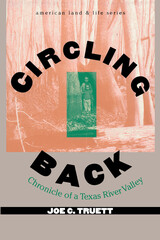 Circling Back: Chronicle of a Texas River Valley
Joe C. Truett
University of Iowa Press, 1996 “There was so much space.” These words epitomize ecologist Joe Truett's boyhood memories of the Angelina River valley in East Texas. Years and miles later, back home for the funeral of his grandfather, Truett began a long meditation on the world Corbett Graham had known and he himself had glimpsed, a now-vanished world where wild hogs and countless other animals rustled through the leaves, cows ate pinewoods grass instead of corn, oaks and hickories and longleaf pines were untouched by the corporate ax, and the river flowed freely. Truett's meditation resulted in this clear-sighted portrait of a place over time, its layers revealed by his love and care and curiosity.Truett celebrates his family's heritage and the unspoiled natural world of the Piney Woods without nostalgia. He recreates an older, simpler, more worthy age, but he knows that we have lost touch with it because we wanted to: he laments the loss but understands it. What makes his prose so moving and so redeeming is this precise combination of honesty and sorrow, overlaid by a quiet passion for both the natural and the human worlds.
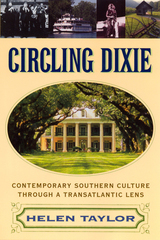 Circling Dixie: Contemporary Southern Culture through a Transatlantic Lens
Helen Taylor
Rutgers University Press, 2000 For Europeans looking across the Atlantic, American culture is often the site of desire, fascination, and envy. In Britain, the rich culture of the American South has made a particularly strong impact. Helen Taylor explores the ways in which contemporary Southern culture has been enthusiastically produced and reproduced in a British context.
Taylor examines some of the South's most significant cultural exports in discussions that range across literature, music, film, television, theater, advertising, and tourism to focus on how and why Southern themes and icons have become so deeply embedded in British cultural life. The enduring legacy of Margaret Mitchell's Gone With the Wind can be seen today in the popularity of sequels, revisions, and reworkings of the novel. The conversation between these cultures is further explored in British responses to Alex Haley's Roots, the British theater's special affection for Tennessee Williams's plays, and the marketing of New Orleans as a preferred destination for European tourists. The transformation of Southern culture--itself a hybrid of the European, African, and American--as it circulates back across the Atlantic suggests not only new views of the history, racial politics, music and art of both Britain and the American South, but also an enhanced understanding of the dynamic flow of culture itself.
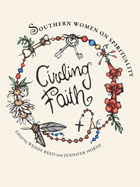 Circling Faith: Southern Women on Spirituality
Wendy Reed
University of Alabama Press, 2012 Circling Faith is a collection of essays by southern women that encompasses spirituality and the experience of winding through the religiously charged environment of the American South.
Mary Karr, in “Facing Altars,” describes how the consolation she found in poetry directed her to a similar solace in prayer. In “Chiaroscuro: Shimmer and Shadow,” Susan Cushman recounts how her dissatisfaction with a Presbyterian upbringing led her to hold her own worship services at home and eventually to join the Eastern Orthodox Church. “Magic” by Amy Blackmarr depicts a religious practice that occurs wholly outside of any formal setting—she recognizes places, such as a fishing shack in south Georgia, and things, such as crystal Cherokee earrings, as reminders that God exists everywhere and that a Great Comforter is always present. In “The Only Jews in Town,” Stella Suberman gives her account of growing up as a religious minority in Tennessee, connecting her story to a larger narrative of Eastern European Jews who moved away from the Northeast, often to found and run “Jew stores” in midwestern and southern towns. Alice Walker, in an interview with Valerie Reiss titled “Alice Walker Calls God ‘Mama,’” relates her dynamic relationship with her God, which includes meditation and yoga, and explains how she views the role of faith in her work, including her novel The Color Purple. These essays showcase the large spectrum of spirituality that abides in the South, as well as the equally large spectrum of individual women who hold these faiths.
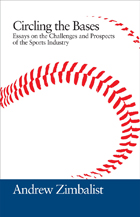 Circling the Bases: Essays on the Challenges and Prospects of the Sports Industry
Authored by Andrew Zimbalist
Temple University Press, 2010 In Circling the Bases, leading sports economist Andrew Zimbalist continues his discussion and analysis of the major issues and challenges confronting the sports industry in the second decade of the 21st century. Presenting a general overview of the sports business at both the college and professional levels, this volume places concerns such as the antitrust status of sports leagues, the stalled progress of gender equity in college sports, and the control of Performance Enhancing Drugs in historical context. Zimbalist also provides a deeper understanding of how sports have fared and changed with the sharpening financial crisis and 2009 economic downturn—from the morphing role of salary caps and revenue distribution and the rapid escalation of college coaches' compensation to the financing of sports facilities and the economic impact of hosting the Olympic Games. In Circling the Bases, Zimbalist continues to show how the business of sports is evolving and how the sports industry is becoming more closely linked with the corporate sector and thus more vulnerable to the vicissitudes of the U.S. and world economies. Zimbalist deftly shows how sports are facing the uncertainties of the future and what the implications are for sports fans, players, owners, and leagues.
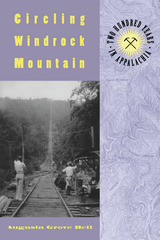 Circling Windrock Mountain: Two Hundred Years in Appalachia
Augusta Grove Bell
University of Tennessee Press, 1999 Around 1800, a Revolutionary War veteran named Micajah Frost came to the Cumberland Mountains of East Tennessee and cleared a portion of virgin forest in what is now Anderson County. Others followed, and eventually this small area was dotted with settlers. In the years since, those settlers and their descendants witnessed the strife of the Civil War, the rise of the coal-mining and logging industries, the coming of the railroad, and countless smaller upheavals. Drawn largely from the memories of long-time residents, this delightful book revisits two hundred years of history in the communities surrounding what was locally called Windrock Mountain.
The stories Augusta Bell recounts take us from Oliver Springs—which had its origins in the grist mill Moses Winters built in 1799 and which later became a “boom town” with a fashionable resort hotel—to places like New River Valley, Graves Gap, and Duncan Flats. She depicts the everyday lives of the mountain people as well as the extraordinary events that sometimes shattered those lives—such as the Coal Creek War of 1891–93, in which miners squared off against state militia, and the two mine explosions that came a few years later, sealing up 268 men deep inside the mountain. Bell also tells of happier times, as when the famous Windrock Mine opened above Oliver Springs in 1909.
Tapping a rich lode of folklore and oral tradition, along with other historical sources, Circling Windrock Mountain offers a view of Appalachian life that defies old stereotypes. Far from being static, the communities described here saw an amazing variety of changes to which they adapted with resilience and ingenuity.
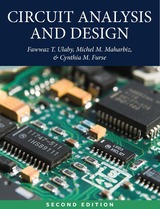 Circuit Analysis and Design
Fawwaz T. Ulaby, Michel M. Mahabiz, & Cynthia M. Furse
Michigan Publishing, 2018 [from the Preface] Circuit Analysis and Design aims to accomplish the four vital objectives of a foundational course in the majority of electrical and computer engineering curricula:
(1) It should introduce the fundamental principles of circuit analysis and equip the student with the skills necessary to analyze any planar, linear circuit, including those driven by dc or ac sources, or by more complicated waveforms such as pulses and exponentials.
(2) It should start the student on the journey of circuit design.
(3) It should guide the student into the seemingly magical world of domain transformations—such as the Laplace and Fourier transforms, not only as circuit analysis tools, but also as mathematical languages that are “spoken” by many fields of science and engineering.
(4) It should expand the student’s technical horizon by introducing him/her to some of the many allied fields of science and technology.
 Circuit Analysis and Design
Fawwaz Ulaby
Michigan Publishing, 2025 Welcome to Circuit Analysis and Design. As the foundational course in the majority of electrical and computer engineering curricula, an electric circuits course should serve four vital objectives:
(1) It should introduce the fundamental principles of circuit analysis and equip the student with the skills necessary to analyze any planar, linear circuit, including those driven by dc or ac sources, or by more complicated waveforms such as pulses and exponentials.
(2) It should start the student on the journey of circuit design.
(3) It should guide the student into the seemingly magical world of domain transformations—such as the Laplace and Fourier transforms, not only as circuit analysis tools, but also as mathematical languages that are “spoken” by many fields of science and engineering.
(4) It should expand the student’s technical horizon by introducing him/her to some of the many allied fields of science and technology.
This book aims to accomplish exactly those objectives. Among its distinctive features are:
Technology Briefs: The book contains 32 Technology Briefs, each providing an overview of a topic that every electrical and computer engineering professional should become familiar with. Electronic displays, data storage media, sensors and actuators, supercapacitors, and 3-D imaging are typical of the topics shared with the reader. The Briefs are presented at a technical level intended to introduce the student to how the concepts in the chapter are applied in real-world applications and to interest the reader in pursuing the subject further on his/her own. Technology Briefs cover applications in circuits, medicine, the physical world, optics, signals and systems, and more.
Application Notes: Most chapters include a section focused on how certain devices or circuits might be used in practical applications. Examples include power supplies, CMOS inverters in computer processors, signal modulators, and several others.
Multisim and MathScript: Multisim is a SPICE circuit simulator available from National Instruments (see cad.eecs.umich.edu for details). Multisim is highlighted through many end-of-chapter demonstrations. The student is strongly encouraged to take advantage of this rich resource. The Math-Script software can perform matrix inversion and many other calculations, much like the MathWorks, Inc. MATLAB® software.
 Circuit Modeling for Electromagnetic Compatibility
Ian B. Darney
The Institution of Engineering and Technology, 2013 Very simply, electromagnetic interference (EMI) costs money, reduces profits, and generally wreaks havoc for circuit designers in all industries. This book shows how the analytic tools of circuit theory can be used to simulate the coupling of interference into, and out of, any signal link in the system being reviewed. The technique is simple, systematic and accurate. It enables the design of any equipment to be tailored to meet EMC requirements.Every electronic system consists of a number of functional modules interconnected by signal links and power supply lines. Electromagnetic interference can be coupled into and out of every conductor. A review of the construction of the wiring assemblies and the functions of the signals they carry will allow critical links to be identified. Circuit modeling can be used to simulate the electromagnetic coupling mechanism of each critical link, allowing its performance to be analyzed and compared with the formal requirements. Bench testing during the development of any product will allow any interference problem to be identified and corrected, long before the manufactured unit is subjected to formal testing. Key Features: A fully outlined, systematic and dramatically simplified process of designing equipment to meet EMC requirements; Focuses on simplifications which enable electrical engineers to singularly handle EMC problems; Helps minimize time-to-market of new products and reduces the need for costly and time-consuming modifications; Outlines how general purpose test equipment (oscilloscopes and signal generators) can be used to validate and refine any model; Discusses how to use Mathcad or MATLAB® to perform analysis and assessment.
The Circuit of Apollo: Eighteenth-Century Women’s Tributes to Women
Laura Runge
University of Delaware Press, 2019 Written by a combination of established scholars and new critics in the field, the essays collected in Circuit of Apollo attest to the vital practice of commemorating women’s artistic and personal relationships. In doing so, they illuminate the complexity of female friendships and honor as well as the robust creativity and intellectual work contributed by women to culture in the long eighteenth century. Women’s tributes to each other sometimes took the form of critical engagement or competition, but they always exposed the feminocentric networks of artistic, social, and material exchange women created and maintained both in and outside of London. This volume advocates for a new perspective for researching and teaching early modern women that is grounded in admiration.
Published by University of Delaware Press. Distributed worldwide by Rutgers University Press.
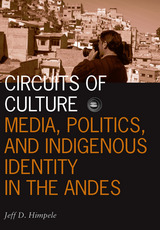 Circuits of Culture: Media, Politics, and Indigenous Identity in the Andes
Jeff D. Himpele
University of Minnesota Press, 2007 Set against the background of Bolivia’s prominent urban festival parades and the country’s recent appearance on the front lines of antiglobalization movements, Circuits of Culture is the first social analysis of Bolivian film and television, their circulation through the social and national landscape, and the emergence of the country’s indigenous video movement. At the heart of Jeff Himpele’s examination is an ethnography of the popular television program, The Open Tribunal of the People. The indigenous and underrepresented majorities in La Paz have used the talk show to publicize their social problems and seek medical and legal assistance from the show’s hosts and the political party they launched. Himpele studies the program in order to identify the possibilities of the mass media as a site for political discourse and as a means of social action. Charting as well the history of Bolivia’s media culture, Himpele perceptively investigates cinematic media as sites for understanding the modernization of Bolivia, its social movements, and the formation of indigenous identities, and in doing so provides a new framework for exploring the circulation of culture as a way of creating publics, political movements, and producing media. Jeff D. Himpele is associate director for the McGraw Center for Teaching and Learning at Princeton University. He is an anthropologist and documentary filmmaker; his films include the award-winning Incidents of Travel in Chichen Itza and Taypi Kala: Six Visions of Tiwanaku.
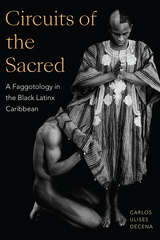 Circuits of the Sacred: A Faggotology in the Black Latinx Caribbean
Carlos Ulises Decena
Duke University Press, 2023 In Circuits of the Sacred Carlos Ulises Decena examines transnational black Latinx Caribbean immigrant queer life and spirit. Decena models what he calls a faggotology—the erotic in the divine as found in the disreputable and the excessive—as foundational to queer black critical and expressive praxis of the future. Drawing on theoretical analysis, memoir, creative writing, and ethnography of Santería/Lucumí in Santo Domingo, Havana, and New Jersey, Decena moves between languages, locations, pronouns, and genres to map the itineraries of blackness as a “circuit,” a multipronged and multisensorial field. A feminist pilgrimage and extended conversation with the dead, Decena’s study is a provocative work that transforms the academic monograph into a gathering of stories, theoretical innovation, and expressive praxis to channel voices, ancestors, deities, theorists, artists, and spirits from the vantage point of radical feminism and queer-of-color thinking.
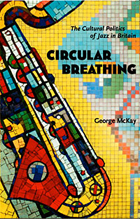 Circular Breathing: The Cultural Politics of Jazz in Britain
George McKay
Duke University Press, 2005 In Circular Breathing, George McKay, a leading chronicler of British countercultures, uncovers the often surprising ways that jazz has accompanied social change during a period of rapid transformation in Great Britain. Examining jazz from the founding of George Webb’s Dixielanders in 1943 through the burgeoning British bebop scene of the early 1950s, the Beaulieu Jazz Festivals of 1956–61, and the improvisational music making of the 1960s and 1970s, McKay reveals the connections of the music, its players, and its subcultures to black and antiracist activism, the Campaign for Nuclear Disarmament, feminism, and the New Left. In the process, he provides the first detailed cultural history of jazz in Britain. McKay explores the music in relation to issues of whiteness, blackness, and masculinity—all against a backdrop of shifting imperial identities, postcolonialism, and the Cold War. He considers objections to the music’s spread by the “anti-jazzers” alongside the ambivalence felt by many leftist musicians about playing an “all-American” musical form. At the same time, McKay highlights the extraordinary cultural mixing that has defined British jazz since the 1950s, as musicians from Britain’s former colonies—particularly from the Caribbean and South Africa—have transformed the genre. Circular Breathing is enriched by McKay’s original interviews with activists, musicians, and fans and by fascinating images, including works by the renowned English jazz photographer Val Wilmer. It is an invaluable look at not only the history of jazz but also the Left and race relations in Great Britain.
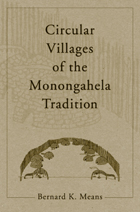 Circular Villages of the Monongahela Tradition
Bernard K. Means
University of Alabama Press, 2007 Between A.D. 1000 and 1635, the inhabitants of southwestern Pennsylvania and portions of adjacent states—known to archaeologists as the Monongahela Culture or Tradition—began to reside regularly in ring-shaped village settlements. These circular settlements consisted of dwellings around a central plaza. A cross-cultural and cross-temporal review of archaeological, ethnohistorical, and ethnographic cases demonstrates that this settlement form appeared repeatedly and independently worldwide, including throughout portions of the Eastern Woodlands, among the Plains Indians, and in Central and South America. Specific archaeological cases are drawn from Somerset County, Pennsylvania, that has the largest number of completely excavated Monongahela villages. Most of these villages, excavated in the 1930s as federal relief projects, were recently dated. Full analysis of the extensive excavations reveals not only the geometric architectural patterning of the villages, but enables an analysis of the social groupings, population estimates, and economic status of residents who inhabited the circular villages. Circular patterning can be revealed at less fully excavated archaeological sites. Focused test excavations can help confirm circular village plans without extensive and destructive excavations.
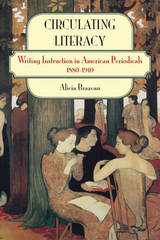 Circulating Literacy: Writing Instruction in American Periodicals, 1880-1910
Alicia Brazeau
Southern Illinois University Press, 2016 Near the dawn of the twentieth century, more than a million Americans had subscriptions to popular magazines, and many who did not subscribe read the periodicals. Far more men and women were learning advanced literacy through reading these magazines than by attending college. Yet this form of popular literacy has been relatively ignored by scholars, who have focused mainly on academic institutions and formal educational experiences. In Circulating Literacy: Writing Instruction in American Periodicals, 1880–1910, author Alicia Brazeau concentrates on the format, circulation, and function of popular and influential periodicals published between 1880 and 1910, including the farming magazines Michigan Farmer, Ohio Farmer, and Maine Farmer, which catered to rural residents, and two women’s magazines, Harper’s Bazar and the Ladies’ Home Journal, that catered to very different populations of women.
Brazeau establishes how these magazines shared a common strategy in the construction of literacy identities by connecting a specific identity with a particular set of reading and writing practices. She explores how farm journals were preoccupied with the value of literacy as a tool for shaping community; considers how the Journal and the Bazar deployed distinctly different illustrations of literacy values for women; shows how the Journal and editor Edward Bok cast women as consumers and sellers of literacy; and looks at the ways in which Bazar editors urged readers to adopt habits of reading and writing that emphasized communal relationships among women. In Circulating Literacy, Brazeau speaks to, and connects, the important topics of rural studies, gender, professionalization, and literacy sponsorship and identity, arguing for the value of the study of periodicals as literacy education tools.
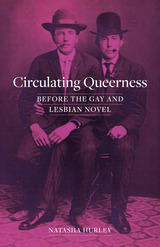 Circulating Queerness: Before the Gay and Lesbian Novel
Natasha Hurley
University of Minnesota Press, 2018 A new history of the queer novel shows its role in constructing gay and lesbian lives
The gay and lesbian novel has long been a distinct literary genre with its own awards, shelving categories, bookstore spaces, and book reviews. But very little has been said about the remarkable history of its emergence in American literature, particularly the ways in which the novel about homosexuality did not just reflect but actively produced queer life. Drawing on Mikhail Bakhtin’s insight that the history of society is connected to the history of language, author Natasha Hurley charts the messy, complex movement by which the queer novel produced the very frames that made it legible as a distinct literature and central to the imagination of queer worlds. Her vision of the queer novel's development revolves around the bold argument that literary circulation is the key ingredient that has made the gay and lesbian novel and its queer forebears available to its audiences. Challenging the narrative that the gay and lesbian novel came into view in response to the emergence of homosexuality as a concept, Hurley posits a much longer history of this novelistic genre. In so doing, she revises our understanding of the history of sexuality, as well as of the processes of producing new concepts and the evolution of new categories of language.
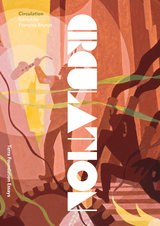 Circulation
Edited by François Brunet
Terra Foundation for American Art, 2017 As a category in art history, circulation is rooted in the contemporary context of Internet culture and the digital image. Yet circulation, as a broader concept for the movement of art across time and space in vastly different cultural and media contexts, has been a factor in the history of the arts in the United States since at least the eighteenth century.
The third volume in the Terra Foundation Essays series, Circulation brings together an international and interdisciplinary team of scholars, including Thierry Gervais, Tom Gunning, J. M. Mancini, Frank Mehring, and Hélène Valance, who map the multiple planes where artistic meaning has been produced by the circulation of art from the eighteenth century to the present. The book looks at both broad historical trends and the successes and failures of particular works of art from a wide variety of artists and styles. Together, the contributions significantly expand the conceptual and methodological terrain of scholarship on American art.
Circulation and Sleep: Experimental Investigations Accompanied by an Atlas
John F. Shepard
University of Michigan Press, 1914 A publication of the University of Michigan’s Science Series, this volume is a report of John F. Shepard’s scientific investigation into the activities of the circulation system during sleep. An accompanying appendix describes experiments concerning the effects of certain drugs upon the circulation.
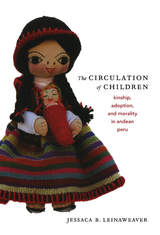 The Circulation of Children: Kinship, Adoption, and Morality in Andean Peru
Jessaca B. Leinaweaver
Duke University Press, 2008 In this vivid ethnography, Jessaca B. Leinaweaver explores “child circulation,” informal arrangements in which indigenous Andean children are sent by their parents to live in other households. At first glance, child circulation appears tantamount to child abandonment. When seen in that light, the practice is a violation of international norms regarding children’s rights, guidelines that the Peruvian state relies on in regulating legal adoptions. Leinaweaver demonstrates that such an understanding of the practice is simplistic and misleading. Her in-depth ethnographic analysis reveals child circulation to be a meaningful, pragmatic social practice for poor and indigenous Peruvians, a flexible system of kinship that has likely been part of Andean lives for centuries. Child circulation may be initiated because parents cannot care for their children, because a childless elder wants company, or because it gives a young person the opportunity to gain needed skills. Leinaweaver provides insight into the emotional and material factors that bring together and separate indigenous Andean families in the highland city of Ayacucho. She describes how child circulation is intimately linked to survival in the city, which has had to withstand colonialism, economic isolation, and the devastating civil war unleashed by the Shining Path. Leinaweaver examines the practice from the perspective of parents who send their children to live in other households, the adults who receive them, and the children themselves. She relates child circulation to international laws and norms regarding children’s rights, adoptions, and orphans, and to Peru’s history of racial conflict and violence. Given that history, Leinaweaver maintains that it is not surprising that child circulation, a practice associated with Peru’s impoverished indigenous community, is alternately ignored, tolerated, or condemned by the state.
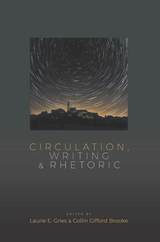 Circulation, Writing, and Rhetoric
Laurie Gries
Utah State University Press, 2018 While it has long been understood that the circulation of discourse, bodies, artifacts, and ideas plays an important constitutive force in our cultures and communities, circulation, as a concept and a phenomenon, has been underexamined in studies of rhetoric and writing. In an effort to give circulation its rhetorical due, Circulation, Writing, and Rhetoric introduces a wide range of studies that foreground circulation in both theory and practice. Contributors to the volume specifically explore the connections between circulation and public rhetorics, urban studies, feminist rhetorics, digital communication, new materialism, and digital research. Circulation is a cultural-rhetorical process that impacts various ecologies, communities, and subjectivities in an ever-increasing globally networked environment. As made evident in this collection, circulation occurs in all forms of discursive production, from academic arguments to neoliberal policies to graffiti to tweets and bitcoins. Even in the case of tombstones, borrowed text achieves only partial stability before it is recirculated and transformed again. This communicative process is even more evident in the digital realm, the underlying infrastructures of which we have yet to fully understand. As public spaces become more and more saturated with circulating texts and images and as networked relations come to the center of rhetorical focus, Circulation, Writing, and Rhetoric will be a vital interdisciplinary resource for approaching the contemporary dynamics of rhetoric and writing. Contributors: Aaron Beveridge, Casey Boyle, Jim Brown, Naomi Clark, Dànielle Nicole DeVoss, Rebecca Dingo, Sidney I. Dobrin, Jay Dolmage, Dustin Edwards, Jessica Enoch, Tarez Samra Graban, Byron Hawk, Gerald Jackson, Gesa E. Kirsch, Heather Lang, Sean Morey, Jenny Rice, Thomas Rickert, Jim Ridolfo, Nathaniel A. Rivers, Jacqueline Jones Royster, Donnie Johnson Sackey, Michele Simmons, Dale M. Smith, Patricia Sullivan, John Tinnell, Kathleen Blake Yancey
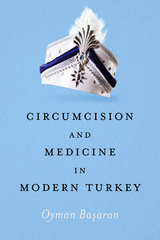 Circumcision and Medicine in Modern Turkey
Oyman Basaran
University of Texas Press, 2023 An investigation of how the expansion of modern medicine in Turkey transformed young boys’ experiences of circumcision.
In Turkey, circumcision is viewed as both a religious obligation and a rite of passage for young boys, as communities celebrate the ritual through gatherings, gifts, and special outfits. Yet the procedure is a potentially painful and traumatic ordeal. With the expansion of modern medicine, the social position of sünnetçi (male circumcisers) became subject to the institutional arrangements of Turkey’s evolving health care and welfare system. In the transition from traditional itinerant circumcisers to low-ranking health officers in the 1960s and hospital doctors in the 1990s, the medicalization of male circumcision has become entangled with state formation, market fetishism, and class inequalities. Based on Oyman Başaran’s extensive ethnographic and historical research, Circumcision and Medicine in Modern Turkey is a close examination of the socioreligious practice of circumcision in twenty-five cities and their outlying towns and villages in Turkey. By analyzing the changing subjectivity of medical actors who seek to alleviate suffering in male circumcision, Başaran offers a psychoanalytically informed alternate approach to the standard sociological arguments surrounding medicalization and male circumcision.
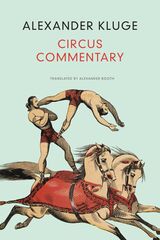 Circus Commentary
Alexander Kluge
Seagull Books, 2024 Alexander Kluge explores the madcap, multifaceted world of the circus through a global geopolitical lens.
The circus has fascinated Alexander Kluge ever since he was a child, and his devotion to it has been preserved throughout his cinematic output and his most recent literary work. In the circus, he finds both the shadow image of work and the epitome of human excellence, from love to war to revolution. As surfaces onto which utopias are projected, these elaborate performances offer a tangible representation of developments within civilization, with its nearly infinite possibilities and sometimes inevitable crashes—from the excited roar of the crowd to death on the floor of the ring.
In Circus Commentary, Kluge’s montage of modernities moves back and forth through time and space, expressing his unique mix of fictional and non-fictional reports, histories, and stories through semantic fields, images, and film sequences inserted in the book via QR codes. We encounter a broad panorama of perplexed artists and sophisticated surgeons cavorting alongside fighter pilots, sans-culottes drunk with dreams of omnipotence, and, most importantly, animals—to whose superhuman performances, this book creates a lasting memorial.
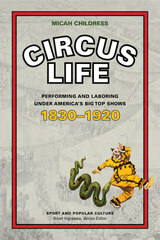 Circus Life: Performing and Laboring under America's Big Top Shows, 1830–1920
Micah D. Childress
University of Tennessee Press, 2018 The nineteenth century saw the American circus move from a reviled and rejected form of entertainment to the “Greatest Show on Earth.” Circus Life by Micah D. Childress looks at this transition from the perspective of the people who owned and worked in circuses and how they responded to the new incentives that rapid industrialization made possible.
The circus has long been a subject of fascination for many, as evidenced by the millions of Americans that have attended circus performances over many decades since 1870, when the circus established itself as a truly unique entertainment enterprise. Yet the few analyses of the circus that do exist have only examined the circus as its own closed microcosm—the “circus family.” Circus Life, on the other hand, places circus employees in the larger context of the history of US workers and corporate America. Focusing on the circus as a business-entertainment venture, Childress pushes the scholarship on circuses to new depths, examining the performers, managers, and laborers’ lives and how the circus evolved as it grew in popularity over time. Beginning with circuses in the antebellum era, Childress examines changes in circuses as gender balances shifted, industrialization influenced the nature of shows, and customers and crowds became increasingly more middle-class.
As a study in sport and social history, Childress’s account demonstrates how the itinerant nature of the circus drew specific types of workers and performers, and how the circus was internally in constant upheaval due to the changing profile of its patrons and a changing economy.
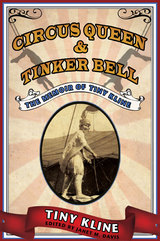 Circus Queen and Tinker Bell: The Memoir of Tiny Kline
Tiny Kline. Edited by Janet M. Davis
University of Illinois Press, 2008 This engaging memoir follows the life and career of circus performer Tiny Kline (1891-1964) from the burlesque house to the circus tent, and on to Disneyland and the silver screen. While working for the Ringling Bros. and Barnum & Bailey Circus, Kline became well known for her signature "slide for life" stunt, an "iron jaw" act in which she slid to the ground while dangling from trapeze rigging by her teeth. Kline renewed her spectacular acrobatics at the age of seventy when she played Tinker Bell in the "Fantasy in the Sky" fireworks show at Disneyland. In that same year, she also began writing her life story. Extensively annotated by Janet M. Davis, this memoir documents twentieth-century changes in popular amusements, while providing fresh insight into circus personalities such as John Ringling, acrobat Lillian Leitzel, and big cat trainer Mabel Stark, as well as mainstream entertainers like Florenz Ziegfeld, John Philip Sousa, and others. Kline also provides intimate details about the daily machinations at the circus, including fascinating accounts of its sexual politics, racial dynamics, risky nature, and labor relations.
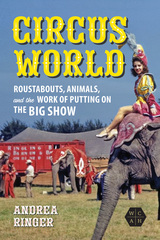 Circus World: Roustabouts, Animals, and the Work of Putting on the Big Show
Andrea Ringer
University of Illinois Press, 2024 From the 1870s to the 1960s, circuses crisscrossed the nation providing entertainment. A unique workforce of human and animal laborers from around the world put on the show. They also formed the backbone of a tented entertainment industry that raised new questions about what constituted work and who counted as a worker. Andrea Ringer examines the industry-wide circus world--the collection of shows that traveled by rail, wagon, steamboat, and car--and the traditional and nontraditional laborers who created it. Performers and their onstage labor played an integral part in the popularity of the circus. But behind the scenes, other laborers performed the endless menial tasks that kept the show on the road. Circus operators regulated employee behavior both inside and outside the tent even as the employees themselves blurred the line between leisure and labor until, in all parts of the show, the workers could not escape their work. Illuminating and vivid, Circus World delves into the gender, class, and even species concerns within an extinct way of life.
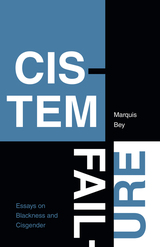 Cistem Failure: Essays on Blackness and Cisgender
Marquis Bey
Duke University Press, 2022 In Cistem Failure Marquis Bey meditates on the antagonistic relationship between blackness and cisgender. Bey asks, What does it mean to have a gender that “matches” one’s sex---that is, to be cisgender---when decades of feminist theory have destroyed the belief that there is some natural way to be a sex? Moving from the The Powerpuff Girls to the greeting “How ya mama’n’em?” to their own gender identity, Bey finds that cisgender is too flat as a category to hold the myriad ways that people who may or may not have undergone gender-affirmative interventions depart from gender alignment. At the same time, blackness, they contend, strikes at the heart of cisgender’s invariable coding as white: just as transness names a non-cis space, blackness implies a non-cis space. By showing how blackness opens up a way to subvert the hegemonic power of the gender binary, Bey makes a case for an antiracist gender abolition project that rejects cisgender as a regulatory apparatus.
The Cistercian Reform and the Art of the Book in Twelfth-Century France
Diane J. Reilly
Amsterdam University Press, 2018 This book is a study of the programmatic oral performance of the written word and its impact on art and text. Communal singing and reading of the Latin texts that formed the core of Christian ritual and belief consumed many hours of the Benedictine monk's day. These texts-read and sung out loud, memorized, and copied into manuscripts-were often illustrated by the very same monks who participated in the choir liturgy. The meaning of these illustrations sometimes only becomes clear when they are read in the context of the texts these monks heard read. The earliest manuscripts of Cîteaux, copied and illuminated at the same time that the new monastery's liturgy was being reformed, demonstrate the transformation of aural experience to visual and textual legacy.
Citadel Culture
Otto Karl Werckmeister
University of Chicago Press, 1991 "Citadel" evokes a rich mixture of associations—from images of urban centers of commerce and culture to war and the need to defend what is fortified within. Preserving its layered meanings, O. K. Werckmeister plucks the word from its usual moorings and employs it as a compelling metaphor in a brilliant retrospective of contemporary Western culture.
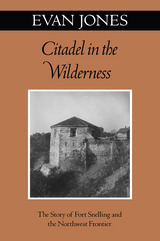 Citadel In The Wilderness: The Story of Fort Snelling and the Northwest Frontier
Evan Jones
University of Minnesota Press, 2001 The lively history of this frontier fort. History/Regional The lively history of this frontier fort, now back in print!In 1824 Colonel Josiah Snelling erected a stone fortress at the point where the Minnesota and Mississippi rivers merged, on territory secured by Lieutenant Zebulon Pike in a treaty with the Sioux chief Little Crow. Evan Jones describes the intriguing history of Fort Snelling, the Gibraltar of the West, its effect on the Native Americans of the region, and its role in the westward movement.“A story of bitter and complex rivalries. . . . With massive towers and walls capping a limestone cliff, [Fort Snelling] defied attack. But it influenced movements and events hundreds of miles away. The Sioux opposed the Chippewa, the North West Company contended with the Hudson’s Bay outfit, and Astor’s American Fur Company fought them both. . . . This book unfolds a forty-year struggle in the wilderness.” --New York Times Book Review“The author offers here a rollicking tale of high adventure and low shenanigans in and around Fort Snelling. As much the story of the Indians of the region as of the hardy Americans (famous and infamous) who walked inside this fort’s impressive walls, Citadel relays its message of courage and chicanery with a minimum of ‘undying prose’ but a maximum of straightforward and incisive storytelling.” --Library JournalEvan Jones (1915–1996) was born in Le Sueur, Minnesota. A writer of American history and cookbooks, he is the author of The Minnesota (also published in paperback by University of Minnesota Press), Trappers and Mountain Men, Epicurean Delight: The Life and Times of James Beard, and The L. L. Bean Book of New New England Cookery.ISBN 0-8166-3879-9 Paper £10.95 $14.95 256 Pages 23 black-and-white photos 5 3/8 x 8 1/2 MayFesler-Lampert Minnesota Heritage SeriesTranslation Inquiries: Penguin Putnam, Inc.
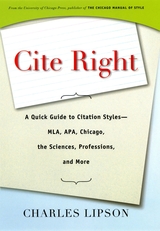 Cite Right: A Quick Guide to Citation Styles--MLA, APA, Chicago, the Sciences, Professions, and More
Charles Lipson
University of Chicago Press, 2006 In his bestselling guide, Doing Honest Work in College: How to Prepare Citations, Avoid Plagiarism, and Achieve Real Academic Success, veteran teacher Charles Lipson brought welcome clarity to the principles of academic honesty as well as to the often murky issues surrounding plagiarism in the digital age. Thousands of students have turned to Lipson for no-nonsense advice on how to cite sources properly—and avoid plagiarism—when writing their research papers. With his latest book, Cite Right, Lipson once again provides much-needed counsel in a concise and affordable handbook for students and researchers. Building on Doing Honest Work in College, Lipson’s new book offers a wealth of information on an even greater range of citation styles and details the intricacies of many additional kinds of sources.
Lipson’s introductory essay, “Why Cite,” explains the reasons it is so important to use citations—and to present them accurately—in research writing. In subsequent chapters, Lipson explains the main citation styles students and researchers are likely to encounter in their academic work: Chicago; MLA; APA; CSE (biological sciences); AMA (medical sciences); ACS (chemistry, mathematics, and computer science); physics, astrophysics, and astronomy; Bluebook and ALWD (law); and AAA (anthropology and ethnography). His discussions of these styles are presented simply and clearly with examples drawn from a wide range of source types crossing all disciplines, from the arts and humanities to science, law, and medicine.
Based on deep experience in the academic trenches, Cite Right is an accessible, one-stop resource—a must-have guide for students and researchers alike who need to prepare citations in any of the major disciplines and professional studies.
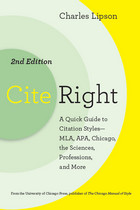 Cite Right, Second Edition: A Quick Guide to Citation Styles--MLA, APA, Chicago, the Sciences, Professions, and More
Charles Lipson
University of Chicago Press, 2011 Thousands of students have turned to veteran teacher Charles Lipson for no-nonsense advice on how to cite sources properly—and avoid plagiarism—when writing their research papers. This new edition of Cite Right, the popular overview of all major systems of citation, has been updated to reflect the most current versions of Chicago, MLA, APA, and other styles, and to discuss citation methods in the rapidly changing context of the Internet, digital publishing, and e-books. Best of all, it’s very easy to use.
Lipson first explains why it is so important to use citations—and to present them accurately—in research writing. He then outlines the main citation styles students and researchers are likely to encounter in their academic work: Chicago; MLA; APA; AAA (anthropology and ethnography); CSE (biological sciences); AMA (medical sciences); ACS (chemistry); physics, astrophysics, and astronomy;and mathematics, computer science, and engineering. New sections have been added on IEEE and ASCE styles, often used in engineering. Each style is presented simply and clearly with examples drawn from a wide range of source types crossing all disciplines, from the arts and humanities to the sciences and medicine. The second edition has also been updated to include a discussion of the merits and pitfalls of citation software, as well as new examples showing proper citation style for video blogs, instant messages, social networking sites, and other forms of digital media.
Based on deep experience in the academic trenches,this thoroughly revised edition is intended to appeal to anyone—student, professional, or academic—who needs an efficient, authoritative guide for citing sources across a wide range of disciplines.
Cite Right, Third Edition: A Quick Guide to Citation Styles--MLA, APA, Chicago, the Sciences, Professions, and More
Charles Lipson
University of Chicago Press, 2018 A compact, accessible guide to citations for any student
Cite Right is the perfect guide for anyone who needs to learn a new citation style or who needs an easy reference to Chicago, MLA, APA, AMA, and other styles. Each chapter serves as a quick guide that introduces the basics of a style, explains who might use it, and then presents an abundance of examples. This edition includes updates reflecting the most recent editions of The Chicago Manual of Style and the MLA Handbook. With this book, students and researchers can move smoothly among styles with the confidence they are getting it right.
CITES and Timber: A guide to CITES-listed tree species
Madeline Groves and Catherine Rutherford
Royal Botanic Gardens, Kew, 2015 This guide covers the main timber species regulated by the Convention on International Trade in Endangered Species (CITES). It provides information on the key issues regarding the implementation of the Convention for this important group of plants. Written for the non-expert, individual sections cover the species found in significant trade, with details on their distribution, uses, traded parts and derivatives, and scientific and common names.
Additional sections cover timber identification and measurement, guidance on CITES documentation and key resources.
Citibank, 1812-1970
Harold van B. Cleveland and Thomas F. Huertas
Harvard University Press, 1985
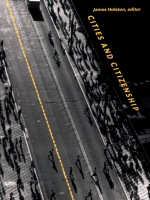 Cities and Citizenship
James Holston, ed.
Duke University Press, 1998 Cities and Citizenship is a prize-winning collection of essays that considers the importance of cities in the making of modern citizens. For most of the modern era the nation and not the city has been the principal domain of citizenship. This volume demonstrates, however, that cities are especially salient sites for examining the current renegotiations of citizenship, democracy, and national belonging. Just as relations between nations are changing in the current phase of global capitalism, so too are relations between nations and cities. Written by internationally prominent scholars, the essays in Cities and Citizenship propose that “place” remains fundamental to these changes and that cities are crucial places for the development of new alignments of local and global identity. Through case studies from Africa, Europe, Latin America, and North America, the volume shows how cities make manifest national and transnational realignments of citizenship and how they generate new possibilities for democratic politics that transform people as citizens. Previously published as a special issue of Public Culture that won the 1996 Best Single Issue of a Journal Award from the Professional/Scholarly Publishing Division of the Association of American Publishers, the collection showcases a photo essay by Cristiano Mascaro, as well as two new essays by James Holston and Thomas Bender. Cities and Citizenship will interest students and scholars of anthropology, geography, sociology, planning, and urban studies, as well as globalization and political science. Contributors. Arjun Appadurai, Etienne Balibar, Thomas Bender, Teresa P. R. Caldeira, Mamadou Diouf, Dilip Parameshwar Gaonkar, James Holston, Marco Jacquemet, Christopher Kamrath, Cristiano Mascaro, Saskia Sassen, Michael Watts, Michel Wieviorka
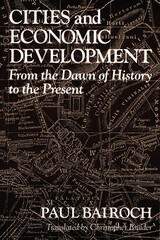 Cities and Economic Development: From the Dawn of History to the Present
Paul Bairoch
University of Chicago Press, 1988 When and how were cities born? Does urbanization foster innovation and economic development? What was the level of urbanization in traditional societies? Did the Industrial Revolution facilitate urbanization? Has the growth of cities in the Third World been a handicap or an asset to economic development?
In this revised translation of De Jéricho à Mexico, Paul Bairoch seeks the answers to these questions and provides a comprehensive study of the evolution of the city and its relation to economic life. Bairoch examines the development of cities from the dawn of urbanization (Jericho) to the explosive growth of the contemporary Third World city. In particular, he defines the roles of agriculture and industrialization in the rise of cities.
"A hefty history, from the Neolithic onward. It's ambitious in scope and rich in subject, detailing urbanization and, of course, the links between cities and economies. Scholarly, accessible, and significant."—Newsday
"This book offers a path-breaking synthesis of the vast literature on the history of urbanization."—John C. Brown, Journal of Economic Literature
"One leaves this volume with the feeling of positions intelligently argued and related to the existing state of theory and knowledge. One also has the pleasure of reading a book unusually well-written. It will long both be a standard and stimulate new thought on the central issue of urban and economic growth."—Thomas A. Reiner, Annals of the American Academy of Political and Social Science
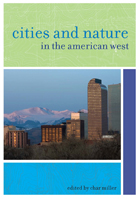 Cities and Nature in the American West
Char Miller
University of Nevada Press, 2010 In less than a century, the American West has transformed from a predominantly rural region to one where most people live in metropolitan centers. Cities and Nature in the American West offers provocative analyses of this transformation. Each essay explores the intersection of environmental, urban, and western history, providing a deeper understanding of the com- plex processes by which the urban West has shaped and been shaped by its sustaining environment. The book also considers how the West’s urban development has altered the human experience and perception of nature, from the administration and marketing of national parks to the consumer roots of popular environ- mentalism; the politics of land and water use; and the challenges of environmental inequities. A number of essays address the cultural role of wilderness, nature, and such activities as camping. Others examine the increasingly per- vasive power of the West’s urban areas and urbanites to redefine the very foundations and future of the American West.
Cities and the Health of the Public
Nicholas Freudenberg
Vanderbilt University Press, 2006 The essays commissioned for this book analyze the impact of city living on health, focusing primarily on conditions in the United States. With 16 chapters by 24 internationally recognized experts, the book introduces an ecological approach to the study of the health of urban populations.
This book assesses the primary determinants of well-being in cities, including the social and physical environments, diet, and health care and social services. The book includes chapters on the history of public health in cities, the impact of urban sprawl and urban renewal on health, and the challenges facing cities in the developing world. It also examines conditions such as infectious diseases, violence and disasters, and mental illness.
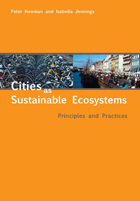 Cities as Sustainable Ecosystems: Principles and Practices
Peter Newman and Isabella Jennings
Island Press, 2008 Modern city dwellers are largely detached from the environmental effects of their daily lives. The sources of the water they drink, the food they eat, and the energy they consume are all but invisible, often coming from other continents, and their waste ends up in places beyond their city boundaries.
Cities as Sustainable Ecosystems shows how cities and their residents can begin to reintegrate into their bioregional environment, and how cities themselves can be planned with nature’s organizing principles in mind. Taking cues from living systems for sustainability strategies, Newman and Jennings reassess urban design by exploring flows of energy, materials, and information, along with the interactions between human and non-human parts of the system.
Drawing on examples from all corners of the world, the authors explore natural patterns and processes that cities can emulate in order to move toward sustainability. Some cities have adopted simple strategies such as harvesting rainwater, greening roofs, and producing renewable energy. Others have created biodiversity parks for endangered species, community gardens that support a connection to their foodshed, and pedestrian-friendly spaces that encourage walking and cycling.
A powerful model for urban redevelopment, Cities as Sustainable Ecosystems describes aspects of urban ecosystems from the visioning process to achieving economic security to fostering a sense of place.
 Cities Beyond Crisis: Race, Affect, and Urban Culture in Twenty-First-Century Iberia
Catalina Iannone
Vanderbilt University Press, 2025 This book is freely available in an open-access edition thanks to the generous support of The Ohio State University Libraries.
In Cities Beyond Crisis, Catalina Iannone studies the rapid evolution of Iberian urban centers in the years following the 2008 financial crisis, identifying how this event catalyzed a protracted period of unraveling and reorganization in the region. Arguing that the affects and effects of the crisis are best understood when embedded within local environments, Cities Beyond Crisis focuses on how textual, visual, and spatial interventions both drove and contested change in two racially diverse, historically marginalized neighborhoods in the capital cities of Spain and Portugal—Madrid’s Lavapiés and Lisbon’s Mouraria. Through a critical examination of the narratives shaping public perception of these spaces, whether promoting their development and consumption or challenging market-oriented trends, Iannone demonstrates how the stories that stakeholders across the ideological spectrum told about these districts illuminate enduring attachments and aspirations in each nation’s relationship to race. By approaching the study of space as a contested and contingent social product, this book takes an interdisciplinary approach, drawing from both humanistic and social science theories and practices to show how cultural production shapes and is shaped by the built environment.
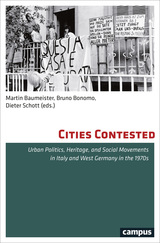 Cities Contested: Urban Politics, Heritage, and Social Movements in Italy and West Germany in the 1970s
Edited by Martin Baumeister, Bruno Bonomo, and Dieter Schott
Campus Verlag, 2017 Historians discuss the 1970s as an era of deep transformations and even structural rupture in Western societies. For the first time, Cities Contested engages in this debate from the perspective of comparative urban history, examining the struggles in and about urban space at a time when ideas about the “city” and concepts of urban planning were being reconsidered. This book discusses the structural rupture of the time by comparing case studies of Italian and Western German cities, analyzing central issues of urban politics, urban renewal and heritage, and urban protest and social movements. An original contribution to current debates on the transition from industrial modernity to post-Fordist societies as well as to urban history and the history of social movements, Cities Contested draws on the parallel histories of Italy and Germany to propose new questions and new avenues for investigation.
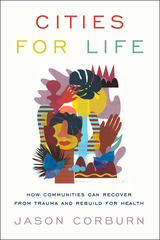 Cities for Life: How Communities Can Recover from Trauma and Rebuild for Health
Jason Corburn
Island Press, 2021 Environmental Design Research Association (EDRA) Place Book Award Winner (2022)
What if cities around the world actively worked to promote the health and healing of all of their residents? Cities contribute to the traumas that cause unhealthy stress, with segregated neighborhoods, insecure housing, few playgrounds, environmental pollution, and unsafe streets, particularly for the poor and residents who are Black, Indigenous, and People of Color.
Some cities around the world are already helping their communities heal by investing more in peacemaking and parks than in policing; focusing on community decision-making instead of data surveillance; changing regulations to permit more libraries than liquor stores; and building more affordable housing than highways. These cities are declaring racism a public health and climate change crisis, and taking the lead in generating equitable outcomes.
In Cities for Life, public health expert Jason Corburn shares lessons from three of these cities: Richmond, California; Medellín, Colombia; and Nairobi, Kenya. Corburn draws from his work with citizens, activists, and decision-makers in these cities over a ten-year period, as individuals and communities worked to heal from trauma—from gun violence, housing and food insecurity, and poverty. Corburn shows how any community can rebuild their social institutions, practices, and policies to be more focused on healing and health. This means not only centering those most traumatized in decision-making, Corburn explains, but confronting historically discriminatory, exclusionary, and racist urban institutions, and promoting healing-focused practices, place-making, and public policies.
Cities for Life is essential reading for urban planning, design, healthcare, and public health professionals as they work to reverse entrenched institutional practices through new policies, rules, norms, and laws that address their damage and promote health and healing.
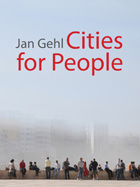 Cities for People
Jan Gehl
Island Press, 2009 For more than forty years Jan Gehl has helped to transform urban environments around the world based on his research into the ways people actually use—or could use—the spaces where they live and work. In this revolutionary book, Gehl presents his latest work creating (or recreating) cityscapes on a human scale. He clearly explains the methods and tools he uses to reconfigure unworkable cityscapes into the landscapes he believes they should be: cities for people.
Taking into account changing demographics and changing lifestyles, Gehl emphasizes four human issues that he sees as essential to successful city planning. He explains how to develop cities that are Lively, Safe, Sustainable, and Healthy. Focusing on these issues leads Gehl to think of even the largest city on a very small scale. For Gehl, the urban landscape must be considered through the five human senses and experienced at the speed of walking rather than at the speed of riding in a car or bus or train. This small-scale view, he argues, is too frequently neglected in contemporary projects.
In a final chapter, Gehl makes a plea for city planning on a human scale in the fast- growing cities of developing countries. A “Toolbox,” presenting key principles, overviews of methods, and keyword lists, concludes the book.
The book is extensively illustrated with over 700 photos and drawings of examples from Gehl’s work around the globe.
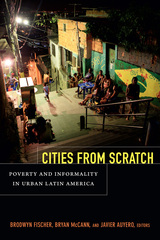 Cities From Scratch: Poverty and Informality in Urban Latin America
Brodwyn Fischer, Bryan McCann, Javier Auyero, eds.
Duke University Press, 2014 This collection of essays challenges long-entrenched ideas about the history, nature, and significance of the informal neighborhoods that house the vast majority of Latin America's urban poor. Until recently, scholars have mainly viewed these settlements through the prisms of crime and drug-related violence, modernization and development theories, populist or revolutionary politics, or debates about the cultures of poverty. Yet shantytowns have proven both more durable and more multifaceted than any of these perspectives foresaw. Far from being accidental offshoots of more dynamic economic and political developments, they are now a permanent and integral part of Latin America's urban societies, critical to struggles over democratization, economic transformation, identity politics, and the drug and arms trades. Integrating historical, cultural, and social scientific methodologies, this collection brings together recent research from across Latin America, from the informal neighborhoods of Rio de Janeiro and Mexico City, Managua and Buenos Aires. Amid alarmist exposés, Cities from Scratch intervenes by considering Latin American shantytowns at a new level of interdisciplinary complexity.
Contributors. Javier Auyero, Mariana Cavalcanti, Ratão Diniz, Emilio Duhau, Sujatha Fernandes, Brodwyn Fischer, Bryan McCann, Edward Murphy, Dennis Rodgers
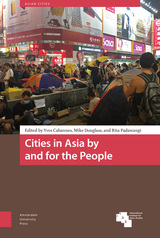 Cities in Asia by and for the People
Edited by Yves Cabannes, Mike Douglass, and Rita Padawangi
Amsterdam University Press, 2018 This book examines the active role of urban citizens in constructing alternative urban spaces as tangible resistance towards capitalist production of urban spaces that continue to encroach various neighborhoods, lanes, commons, public land and other spaces of community life and livelihoods. The collection of narratives presented here brings together research from ten different Asian cities and re-theorises the city from the perspective of ordinary people facing moments of crisis, contestations, and cooperative quests to create alternative spaces to those being produced under prevailing urban processes. The chapters accent the exercise of human agency through daily practices in the production of urban space and the intention is not one of creating a romantic or utopian vision of what a city "by and for the people" ought to be. Rather, it is to place people in the centre as mediators of city-making with discontents about current conditions and desires for a better life.
 Cities in Our Future
Edited by Robert Geddes; Foreword by Wally N'Dow; Introduction by Ellen Posner
Island Press, 1997 By the year 2000, half of humanity will live in urban areas. The problems of large-scale urbanization are profound, and coping with growth in the world's cities will be the most pressing challenge of the 21st century.In June 1996, the third in a series of United Nations sponsored conferences on global concerns was held: the Conference on Human Settlements, Habitat II. In preparation for that meeting, Robert Geddes, one of the nation's most respected and influential architects and urban designers, invited leading experts to New York to consider the experience of urban areas in Canada, Mexico, and the United States in order to develop concrete proposals for improving our built environment. Cities in Our Future presents and examines issues set forth at that gathering.Urban and regional planners, architects, urban designers, and other experts from across North America examine the impact of a city's growth and form on the ability of its citizens to achieve and maintain social equity and environmental health. Case studies of five North American metropolitan areas -- New York, Toronto, Cascadia (Vancouver, Seattle, Portland), Mexico City, and Los Angeles -- are presented, with in-depth analyses of their physical terrain, design, planning, and development. Contributors discuss problems the cities have experienced, how those problems have been handled, and strategies for avoiding or managing similar problems in the future. They consider historical and contemporary transformations of the cities as well as issues of environment, equity, sustainable development, governance, and civic design.In addition to the case studies, Cities in Our Future features a foreword by Dr. Wally N'Dow, secretary-general of the United Nations Centre for Human Settlements-Habitat II, that describes the global nature of urbanization problems; an insightful introduction by urban critic Ellen Posner that provides an overview of important issues facing urban areas in the twenty-first century; a broad examination of the concept of social equity by political philosopher Alan Ryan of Oxford University; and a concise description of environmental health issues by John Spengler of the Harvard School of Public Health. The distinguished contributors representing the five urban regions are Alan Artibise, Jonathan Barnett, Gardner Church, Ken Greenberg, Marilou McPhedran, Ann Vernez Moudon, Xavier Cortes Rocha, Ethan Seltzer, Richard Weinstein, and Robert Yaro.
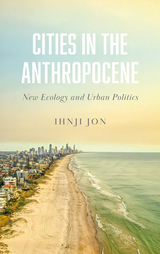 Cities in the Anthropocene: New Ecology and Urban Politics
Ihnji Jon
Pluto Press, 2021 Climate change is real, and extreme weather events are its physical manifestations. These extreme events affect how we live and work in cities, and subsequently the way we design, plan, and govern them. Taking action ‘for the environment’ is not only a moral imperative; instead, it is activated by our everyday experience in the city.
Based on the author’s site visits and interviews in Darwin (Australia), Tulsa (Oklahoma), Cleveland (Ohio), and Cape Town (South Africa), this book tells the story of how cities can lead a transformative pro-environment politics.
National governments often fail to make binding agreements that bring about radical actions for the environment. This book shows how cities, as local sites of mobilizing a collective, political agenda, can be frontiers for activating the kind of environmental politics that appreciates the role of ‘nature’ in the everyday functioning of our urban life.
 Cities in the Anthropocene: New Ecology and Urban Politics
Ihnji Jon
Pluto Press, 2021 Climate change is real, and extreme weather events are its physical manifestations. These extreme events affect how we live and work in cities, and subsequently the way we design, plan, and govern them. Taking action ‘for the environment’ is not only a moral imperative; instead, it is activated by our everyday experience in the city.
Based on the author’s site visits and interviews in Darwin (Australia), Tulsa (Oklahoma), Cleveland (Ohio), and Cape Town (South Africa), this book tells the story of how cities can lead a transformative pro-environment politics.
National governments often fail to make binding agreements that bring about radical actions for the environment. This book shows how cities, as local sites of mobilizing a collective, political agenda, can be frontiers for activating the kind of environmental politics that appreciates the role of ‘nature’ in the everyday functioning of our urban life.
Cities in the Sea
Maura Stanton
University of Michigan Press, 2003 In Cities in the Sea, Maura Stanton taps into the mysterious force of the fairy tale, with its fantastic images and magical narrative patterns. Her stories blur the boundaries between fairy tale and verité, and comment on the art of storytelling. A range of characters—from a business man to a pianist, from a county coroner to a hardware store clerk, from a Greek immigrant to a Danish artist—come to discover that the past is a ruined kingdom, lost forever, but still a place to visit in wish, dream, and memory. Throughout her stories, Stanton attempts to wrest a deeper pattern, full of humor and wonder, out of the disturbing events of contemporary life.
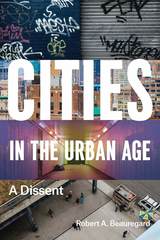 Cities in the Urban Age: A Dissent
Robert A. Beauregard
University of Chicago Press, 2018 We live in a self-proclaimed Urban Age, where we celebrate the city as the source of economic prosperity, a nurturer of social and cultural diversity, and a place primed for democracy. We proclaim the city as the fertile ground from which progress will arise. Without cities, we tell ourselves, human civilization would falter and decay. In Cities in the Urban Age, Robert A. Beauregard argues that this line of thinking is not only hyperbolic—it is too celebratory by half.
For Beauregard, the city is a cauldron for four haunting contradictions. First, cities are equally defined by both their wealth and their poverty. Second, cities are simultaneously environmentally destructive and yet promise sustainability. Third, cities encourage rule by political machines and oligarchies, even as they are essentially democratic and at least nominally open to all. And fourth, city life promotes tolerance among disparate groups, even as the friction among them often erupts into violence. Beauregard offers no simple solutions or proposed remedies for these contradictions; indeed, he doesn’t necessarily hold that they need to be resolved, since they are generative of city life. Without these four tensions, cities wouldn’t be cities. Rather, Beauregard argues that only by recognizing these ambiguities and contradictions can we even begin to understand our moral obligations, as well as the clearest paths toward equality, justice, and peace in urban settings.
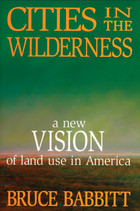 Cities in the Wilderness: A New Vision of Land Use in America
Bruce Babbitt
Island Press, 2005 In this brilliant, gracefully written, and important new book, former Secretary of the Interior and Governor of Arizona Bruce Babbitt brings fresh thought--and fresh air--to questions of how we can build a future we want to live in. We've all experienced America's changing natural landscape as the integrity of our forests, seacoasts, and river valleys succumbs to strip malls, new roads, and subdivisions. Too often, we assume that when land is developed it is forever lost to the natural world--or hope that a patchwork of local conservation strategies can somehow hold up against further large-scale development. In Cities in the Wilderness, Bruce Babbitt makes the case for why we need a national vision of land use. We may have a space program, he points out, but here at home we don't have an open-space policy that can balance the needs for human settlement and community with those for preservation of the natural world upon which life depends. Yet such a balance, the author demonstrates, is as remarkably achievable as it is necessary. This is no call for developing a new federal bureaucracy; Babbitt shows instead how much can be--and has been--done by making thoughtful and beneficial use of laws and institutions already in place. A hallmark of the book is the author's ability to match imaginative vision with practical understanding. Babbitt draws on his extensive experience to take us behind the scenes negotiating the Florida Everglades restoration project, the largest ever authorized by Congress. In California, we discover how the Endangered Species Act, still one of the most effective laws governing land use, has been employed to restore regional habitat. In the Midwest, we see how new World Trade Organization regulations might be used to help restore Iowa's farmlands and rivers. As a key architect of many environmental success stories, Babbitt reveals how broad restoration projects have thrived through federal- state partnership and how their principles can be extended to other parts of the country. Whether writing of land use as reflected in the Gettysburg battlefield, the movie Chinatown, or in presidential political strategy, Babbitt gives us fresh insight. In this inspiring and informative book, Babbitt sets his lens to panoramic--and offers a vision of land use as grand as the country's natural heritage.
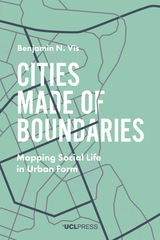 Cities Made of Boundaries: Mapping Social Life in Urban Form
Benjamin N. Vis
University College London, 2018 Cities Made of Boundaries presents the theoretical foundation and concepts for a new social scientific urban morphological mapping method, Boundary Line Type (BLT) mapping. Its vantage is a plea to establish a frame of reference for radically comparative urban studies positioned between geography and archaeology. Based in multidisciplinary social and spatial theory, a critical realist understanding of the boundaries that compose built space is operationalized by a mapping practice utilizing Geographical Information Systems (GIS).
Benjamin N. Vis gives a precise account of how BLT mapping can be applied to detailed historical, reconstructed, contemporary, and archaeological urban plans, exemplified by sixteenth to twenty-first-century Winchester and Classic Maya Chunchucmil. This account demonstrates how the functional and experiential difference between compact western and tropical dispersed cities can be explored.
The methodological development of Cities Made of Boundaries will appeal to readers interested in the comparative social analysis of built environments, and those seeking to expand the evidence-base of design options to structure urban life and development.
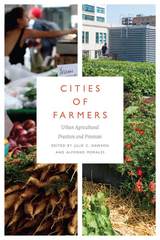 Cities of Farmers: Urban Agricultural Practices and Processes
Julie C. Dawson and Alfonso Morales
University of Iowa Press, 2016 Full-scale food production in cities: is it an impossibility? Or is it a panacea for all that ails urban communities? Today, it’s a reality, but many people still don’t know how much of an impact this emerging food system is having on cities and their residents. This book showcases the work of the farmers, activists, urban planners, and city officials in the United States and Canada who are advancing food production. They have realized that, when it’s done right, farming in cities can enhance the local ecology, foster cohesive communities, and improve the quality of life for urban residents.
Implementing urban agriculture often requires change in the physical, political, and social-organizational landscape. Beginning with a look at how and why city people grew their own food in the early twentieth century, the contributors to Cities of Farmers examine the role of local and regional regulations and politics, especially the creation of food policy councils, in making cities into fertile ground for farming. The authors describe how food is produced and distributed in cities via institutions as diverse as commercial farms, community gardens, farmers’ markets, and regional food hubs. Growing food in vacant lots and on rooftops affects labor, capital investment, and human capital formation, and as a result urban agriculture intersects with land values and efforts to build affordable housing. It also can contribute to cultural renewal and improved health.
This book enables readers to understand and contribute to their local food system, whether they are raising vegetables in a community garden, setting up a farmers’ market, or formulating regulations for farming and composting within city limits.
CONTRIBUTORS
Catherine Brinkley, Benjamin W. Chrisinger, Nevin Cohen, Michèle Companion, Lindsey Day-Farnsworth, Janine de la Salle, Luke Drake, Sheila Golden, Randel D. Hanson, Megan Horst, Nurgul Fitzgerald, Becca B. R. Jablonski, Laura Lawson, Kara Martin, Nathan McClintock, Alfonso Morales, Jayson Otto, Anne Pfeiffer, Anne Roubal, Todd M. Schmit, Erin Silva, Michael Simpson, Lauren Suerth, Dory Thrasher, Katinka Wijsman
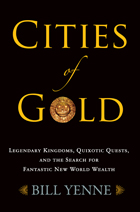 Cities of Gold: Legendary Kingdoms, Quixotic Quests, and Fantastic New World Wealth
Bill Yenne
Westholme Publishing, 2011 A History of Exploration for Real and Mythical Treasures in the Americas For half a millennium, stories of vast treasures—El Dorado, Manoa, the Seven Cities of Cibola, the Lost Dutchman Mine—have been part of the lore of the Americas. Long before the Europeans set foot in the New World, myths and rumors of fabulous wealth in distant lands, such as the kingdom of Prester John, were told and retold so often that they were assumed to be true. When Spanish explorers first made contact with the Aztec and Inca civilizations, they found cultures that were literally dripping with gold. This evidence made it easy to believe the native stories of even greater wealth just beyond the horizon. In these uncharted lands, dreamers sought their fortunes: Francisco de Coronado ranged over the North American plains in search of the elusive Quivira; Gonzalo Pizarro, brother of the Incan conqueror, and Lope Aguirre, the “Wrath of God,” were both part of ill-fated expeditions in search of El Dorado; and Leonard Clark walked out of the Amazon after World War II with gold and claimed he had found that fabled kingdom. In Cities of Gold: Legendary Kingdoms, Quixotic Quests, and Fantastic New World Wealth, Bill Yenne takes the reader from the rainforests and mountains of Peru, Paraguay, Brazil, and Guiana to the deserts and peaks of Mexico and the United States to tell the extraordinary, and often brutal story of how the search for mysterious New World riches fueled the exploration of an unknown hemisphere for hundreds of years. Even without finding the places they sought, during Spain’s “Siglo de Oro” in the sixteenth century, the Spanish plundered and mined thousands of tons of New World gold and silver and shipped it home where the reserves alone reached a staggering estimate of two trillion dollars. And it was not just the Spanish who were obsessed with gold: Sir Walter Raleigh made two government-backed voyages in search of Manoa, a golden city he was convinced was deep in Guiana. Discussing the many expeditions to find New World wealth and lost cities over a 500-year timeline, the author includes stories of lesser-known explorers and soldiers of fortune and their successes and failures. As he demonstrates, the desire for adventure and the insatiable lust for treasure motivated men and women in the past and continues to captivate fortune hunters today.
 Cities of the Interior
Anaïs Nin
Ohio University Press, 1996 Ladders to Fire, Children of the Albatross, The Four-Chambered Heart, A Spy in the House of Love, Seduction of the Minotaur. Haunting and hypnotic, these five novels by Anaïs Nin began in 1946 to appear in quiet succession. Though published separately over the next fifteen years, the five were conceived as a continuous experience—a continuous novel like Proust’s, real and flowing as a river. The full impact of Anaïs Nin’s genius is only to be found through reading the novels in context and in succession. They form a rich, luminous tapestry whose overall theme Nin has called “woman at war with herself.” Characters, symbols appear and reappear: now one, now another unfolding, gradually revealing, changing, struggling, growing, and Nin had forged an evocative language all her own for the telling. “The diary taught me that there were no neat ends to novels, no neat denouement, no neat synthesis,” she explains. “So I began an endless novel, a novel in which the climaxes consisted of discoveries in awareness, each step in awareness becoming a stage in the growth like the layers in trees.” Cities of the Interior fulfills a long–time desire on the part of readers, publisher, and Anaïs Nin herself to reunite the five novels in a single volume.
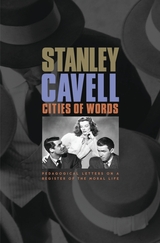 Cities of Words: Pedagogical Letters on a Register of the Moral Life
Stanley Cavell
Harvard University Press, 2004 Since Socrates and his circle first tried to frame the Just City in words, discussion of a perfect communal life--a life of justice, reflection, and mutual respect--has had to come to terms with the distance between that idea and reality. Measuring this distance step by practical step is the philosophical project that Stanley Cavell has pursued on his exploratory path. Situated at the intersection of two of his longstanding interests--Emersonian philosophy and the Hollywood comedy of remarriage--Cavell's new work marks a significant advance in this project. The book--which presents a course of lectures Cavell presented several times toward the end of his teaching career at Harvard--links masterpieces of moral philosophy and classic Hollywood comedies to fashion a new way of looking at our lives and learning to live with ourselves.
This book offers philosophy in the key of life. Beginning with a rereading of Emerson's "Self-Reliance," Cavell traces the idea of perfectionism through works by Plato, Aristotle, Locke, Kant, Mill, Nietzsche, and Rawls, and by such artists as Henry James, George Bernard Shaw, and Shakespeare. Cities of Words shows that this ever-evolving idea, brought to dramatic life in movies such as It Happened One Night, The Awful Truth, The Philadelphia Story, and The Lady Eve, has the power to reorient the perception of Western philosophy.
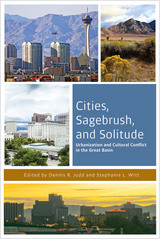 Cities, Sagebrush, and Solitude: Urbanization and Cultural Conflict in the Great Basin
Dennis R. Judd
University of Nevada Press, 2015 Cities, Sagebrush, and Solitude explores the transformation of the largest desert in North America, the Great Basin, into America’s last urban frontier. In recent decades Las Vegas, Reno, Salt Lake City, and Boise have become the anchors for sprawling metropolitan regions. This population explosion has been fueled by the maturing of Las Vegas as the nation’s entertainment capital, the rise of Reno as a magnet for multitudes of California expatriates, the development of Salt Lake City’s urban corridor along the Wasatch Range, and the growth of Boise’s celebrated high-tech economy and hip urban culture.
The blooming of cities in a fragile desert region poses a host of environmental challenges. The policies required to manage their impact, however, often collide with an entrenched political culture that has long resisted cooperative or governmental effort. The alchemical mixture of three ingredients--cities, aridity, and a libertarian political outlook--makes the Great Basin a compelling place to study. This book addresses a pressing question: are large cities ultimately sustainable in such a fragile environment?
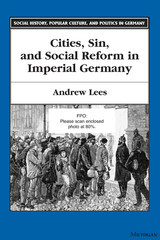 Cities, Sin, and Social Reform in Imperial Germany
Andrew Lees
University of Michigan Press, 2002 Cities, Sin, and Social Reform in Imperial Germany breaks new ground in the history of social thought and action in Imperial Germany, focusing on socially liberal efforts to counteract perceived problems in the area of moral behavior.
Thematically and methodologically wide-ranging and innovative, this volume considers a broad spectrum of responses not only to the supposed breakdown of social cohesion but also to specific forms of deviant behavior. It draws on large numbers of writings from the period by clergymen, jurists, medical doctors, educators, social workers, and others. This literature illuminates the histories not only of urbanization and cities but also of sexuality and Christianity, crime and criminology, leisure and education, youth and women, charity and social work, and the welfare state as well as local government.
Focusing on positive instead of escapist responses to the challenges that inhered in urban society, this work can be read as part of an ongoing reassessment of the German Empire that points away from the idea that Germans were traveling an antimodernist Sonderweg, or special path, that led inevitably to National Socialism and the Third Reich. Although intended primarily for scholars and students of modern Germany, this book should speak to a variety of readers, among them anyone who cares about the history of cities, deviant behavior, or social reform.
Andrew Lees is Professor of History, Rutgers University.
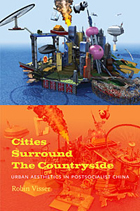 Cities Surround The Countryside: Urban Aesthetics in Postsocialist China
Robin Visser
Duke University Press, 2010 Denounced as parasitical under Chairman Mao and devalued by the norms of traditional Chinese ethics, the city now functions as a site of individual and collective identity in China. Cities envelop the countryside, not only geographically and demographically but also in terms of cultural impact. Robin Visser illuminates the cultural dynamics of three decades of radical urban development in China. Interpreting fiction, cinema, visual art, architecture, and urban design, she analyzes how the aesthetics of the urban environment have shaped the emotions and behavior of people and cultures, and how individual and collective images of and practices in the city have produced urban aesthetics. By relating the built environment to culture, Visser situates postsocialist Chinese urban aesthetics within local and global economic and intellectual trends. In the 1980s, writers, filmmakers, and artists began to probe the contradictions in China’s urbanization policies and rhetoric. Powerful neorealist fiction, cinema, documentaries, paintings, photographs, performances, and installations contrasted forms of glittering urban renewal with the government’s inattention to a livable urban infrastructure. Narratives and images depicting the melancholy urban subject came to illustrate ethical quandaries raised by urban life. Visser relates her analysis of this art to major transformations in urban planning under global neoliberalism, to the development of cultural studies in the Chinese academy, and to ways that specific cities, particularly Beijing and Shanghai, figure in the cultural imagination. Despite the environmental and cultural destruction caused by China’s neoliberal policies, Visser argues for the emergence of a new urban self-awareness, one that offers creative resolutions for the dilemmas of urbanism through new forms of intellectual engagement in society and nascent forms of civic governance.
 Citizen Bird: Scenes from Bird-Life in Plain English for Beginners, A Critical Edition
Mabel Osgood Wright
Rutgers University Press, 2025 In the late nineteenth century, American bird lovers faced a crisis. Bird species were becoming endangered or even extinct at an alarming rate, and old methods of hunting and collecting specimens accelerated the process. A new conservationist approach to birding was necessary, and it needed to be taught to the next generation of Americans. Thus 1897’s Citizen Bird, the first birding guide for children, was born. A tremendously influential text in the Progressive-era United States, it inspired in a generation of schoolchildren a love of wild birds and the desire to protect them.
Born of a collaboration between naturalist Mabel Osgood Wright, ornithologist Elliott Coues, and bird artist Louis Agassiz Fuertes, the book is vital to the history of birding and the broader study of nineteenth-century American culture and literature. This new edition of Citizen Bird preserves the original book’s 111 drawings and adds explanatory footnotes, supplemental historical material, and a new introduction. More than a century and a quarter after its original publication, Elizabeth Cherry and Meghan Freeman contextualize the book in the tradition and history of birding and discuss the roles of its authors and illustrator in birding history. A landmark text in the history of American conservationism, Citizen Bird is a timeless classic that will bring joy to birdwatchers of all ages.
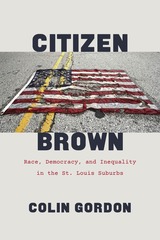 Citizen Brown: Race, Democracy, and Inequality in the St. Louis Suburbs
Colin Gordon
University of Chicago Press, 2019 The 2014 killing of Michael Brown in Ferguson, Missouri, ignited nationwide protests and brought widespread attention police brutality and institutional racism. But Ferguson was no aberration. As Colin Gordon shows in this urgent and timely book, the events in Ferguson exposed not only the deep racism of the local police department but also the ways in which decades of public policy effectively segregated people and curtailed citizenship not just in Ferguson but across the St. Louis suburbs. Citizen Brown uncovers half a century of private practices and public policies that resulted in bitter inequality and sustained segregation in Ferguson and beyond. Gordon shows how municipal and school district boundaries were pointedly drawn to contain or exclude African Americans and how local policies and services—especially policing, education, and urban renewal—were weaponized to maintain civic separation. He also makes it clear that the outcry that arose in Ferguson was no impulsive outburst but rather an explosion of pent-up rage against long-standing systems of segregation and inequality—of which a police force that viewed citizens not as subjects to serve and protect but as sources of revenue was only the most immediate example. Worse, Citizen Brown illustrates the fact that though the greater St. Louis area provides some extraordinarily clear examples of fraught racial dynamics, in this it is hardly alone among American cities and regions. Interactive maps and other companion resources to Citizen Brown are available at the book website.
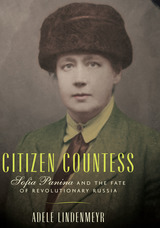 Citizen Countess: Sofia Panina and the Fate of Revolutionary Russia
Adele Lindenmeyr
University of Wisconsin Press, 2019 Countess Sofia Panina lived a remarkable life. Born into an aristocratic family in imperial Russia, she found her true calling in improving the lives of urban workers. Her passion for social service and reputation as the "Red Countess" led her to political prominence after the fall of the Romanovs. She became the first woman to hold a cabinet position and the first political prisoner tried by the Bolsheviks. The upheavals of the 1917 Revolution forced her to flee her beloved country, but instead of living a quiet life in exile she devoted the rest of her long life to humanitarian efforts on behalf of fellow refugees.
Based on Adele Lindenmeyr's detailed research in dozens of archival collections, Citizen Countess establishes Sofia Panina as an astute eyewitness to and passionate participant in the historical events that shaped her life. Her experiences shed light on the evolution of the European nobility, women's emancipation and political influence of the time, and the fate of Russian liberalism.
 Citizen Critics: Literary Public Spheres
Rosa A. Eberly
University of Illinois Press, 2000 The condition of our public discussions about literary and cultural works has much to say about the state of our democracy. Classrooms, newspapers, magazines, Internet forums, and many other places grant citizens a place to hold public discourses—and claim a voice on national artistic matters. Rosa A. Eberly looks at four censorship controversies where professionals asserted their authority to deny citizen critics a voice—and effectively removed discussion of literature from the public sphere. Eberly compares the outrage sparked by the publication of James Joyce's Ulysses and Henry Miller's Tropic of Cancer with the relative quiescence that greeted the much more violent and sexually explicit content of Bret Easton Ellis's American Psycho and Andrea Dworkin's Mercy. Through a close reading of letters to the editor, reviews, media coverage, and court cases, Eberly shows how literary critics and legal experts defused censorship debates—and undercut the authority of citizen critics—by shifting the focus from content to aesthetics and from social values to publicity.
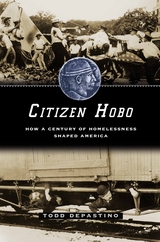 Citizen Hobo: How a Century of Homelessness Shaped America
Todd DePastino
University of Chicago Press, 2003 In the years following the Civil War, a veritable army of homeless men swept across America's "wageworkers' frontier" and forged a beguiling and bedeviling counterculture known as "hobohemia." Celebrating unfettered masculinity and jealously guarding the American road as the preserve of white manhood, hoboes took command of downtown districts and swaggered onto center stage of the new urban culture. Less obviously, perhaps, they also staked their own claims on the American polity, claims that would in fact transform the very entitlements of American citizenship.
In this eye-opening work of American history, Todd DePastino tells the epic story of hobohemia's rise and fall, and crafts a stunning new interpretation of the "American century" in the process. Drawing on sources ranging from diaries, letters, and police reports to movies and memoirs, Citizen Hobo breathes life into the largely forgotten world of the road, but it also, crucially, shows how the hobo army so haunted the American body politic that it prompted the creation of an entirely new social order and political economy. DePastino shows how hoboes—with their reputation as dangers to civilization, sexual savages, and professional idlers—became a cultural and political force, influencing the creation of welfare state measures, the promotion of mass consumption, and the suburbanization of America. Citizen Hobo's sweeping retelling of American nationhood in light of enduring struggles over "home" does more than chart the change from "homelessness" to "houselessness." In its breadth and scope, the book offers nothing less than an essential new context for thinking about Americans' struggles against inequality and alienation.
 Citizen, Invert, Queer: Lesbianism and War in Early Twentieth-Century Britain
Deborah Cohler
University of Minnesota Press, 2010 In late nineteenth-century England, “mannish” women were considered socially deviant but not homosexual. A half-century later, such masculinity equaled lesbianism in the public imagination. How did this shift occur? Citizen, Invert, Queer illustrates that the equation of female masculinity with female homosexuality is a relatively recent phenomenon, a result of changes in national and racial as well as sexual discourses in early twentieth-century public culture. Incorporating cultural histories of prewar women’s suffrage debates, British sexology, women’s work on the home front during World War I, and discussions of interwar literary representations of female homosexuality, Deborah Cohler maps the emergence of lesbian representations in relation to the decline of empire and the rise of eugenics in England. Cohler integrates discussions of the histories of male and female same-sex erotics in her readings of New Woman, representations of male and female suffragists, wartime trials of pacifist novelists and seditious artists, and the interwar infamy of novels such as Radclyffe Hall’s The Well of Loneliness and Virginia Woolf’s Orlando. By examining the shifting intersections of nationalism and sexuality before, during, and after the Great War, this book illuminates profound transformations in our ideas about female homosexuality.
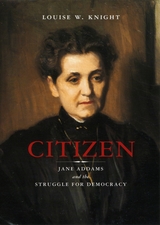 Citizen: Jane Addams and the Struggle for Democracy
Louise W. Knight
University of Chicago Press, 2005 Jane Addams was the first American woman to receive the Nobel Peace Prize. Now Citizen, Louise W. Knight's masterful biography, reveals Addams's early development as a political activist and social philosopher. In this book we observe a powerful mind grappling with the radical ideas of her age, most notably the ever-changing meanings of democracy.
Citizen covers the first half of Addams's life, from 1860 to 1899. Knight recounts how Addams, a child of a wealthy family in rural northern Illinois, longed for a life of larger purpose. She broadened her horizons through education, reading, and travel, and, after receiving an inheritance upon her father's death, moved to Chicago in 1889 to co-found Hull House, the city's first settlement house. Citizen shows vividly what the settlement house actually was—a neighborhood center for education and social gatherings—and describes how Addams learned of the abject working conditions in American factories, the unchecked power wielded by employers, the impact of corrupt local politics on city services, and the intolerable limits placed on women by their lack of voting rights. These experiences, Knight makes clear, transformed Addams. Always a believer in democracy as an abstraction, Addams came to understand that this national ideal was also a life philosophy and a mandate for civic activism by all.
As her story unfolds, Knight astutely captures the enigmatic Addams's compassionate personality as well as her flawed human side. Written in a strong narrative voice, Citizen is an insightful portrait of the formative years of a great American leader.
“Knight’s decision to focus on Addams’s early years is a stroke of genius. We know a great deal about Jane Addams the public figure. We know relatively little about how she made the transition from the 19th century to the 20th. In Knight’s book, Jane Addams comes to life. . . . Citizen is written neither to make money nor to gain academic tenure; it is a gift, meant to enlighten and improve. Jane Addams would have understood.”—Alan Wolfe, New York Times Book Review
“My only complaint about the book is that there wasn’t more of it. . . . Knight honors Addams as an American original.”—Kathleen Dalton, Chicago Tribune
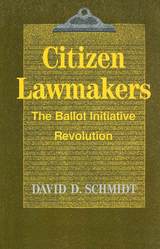 Citizen Lawmakers
David D. Schmidt
Temple University Press, 1991 "[B]oth an engrossing history and a guide showing how citizens can make their own laws directly, at the ballot box, when elected officials are unresponsive."
--Ralph Nader
After decades of disuse, a startling upsurge in the use of the Initiative and Referendum--law-making by citizen petition and popular vote--occurred in the 1970s and 1980s. In Citizen Lawmakers, David Schmidt tells the stories of the individual activists, such as Howard Jarvis and Ed Koupal, and the political groups that made this happen. While other studies have analyzed the statistics of the ballot initiative revolution, this book provides the personal, political, and historical contexts vital to understanding the causes and the tremendous impact of the trend toward ballot-box lawmaking over the last two decades. Schmidt demonstrates how "ordinary individuals, even in this age of monstrous bureaucracies and larger-than-life celebrities, can, and do, change this nation's laws to make government more accountable."
Although still neglected in contemporary political science texts, the initiative process has become the most dynamic, innovative arena of American politics. Between 1968 and 1982, the number of voter-initiated propositions on state ballots increased from 10 to 60, with issues moving from purely local to national movements, such as the Tax Revolt (heralded by California's Proposition 13 in 1978), "Motor Voter" initiatives started in Arizona and Colorado, Bottle Bills and non-smoking ordinances, and the Nuclear Weapons Freeze votes of 1982. As the editor of a nationwide newsletter on the subject and a participant in some of the initiative and referendum campaigns he describes, David Schmidt brings to the writing a wealth of first-hand detail.
After tracing the historical origins of the Initiative and Referendum, the book focuses on case studies of the most widespread ballot issues and the most prominent initiative campaign promoters in the 1970s and 1980s. Discussing recent efforts to put national initiative lawmaking rights into the federal Constitution, Schmidt makes a case for the ballot initiative process as an essential complement and corrective to the American system of lawmaking by elected representatives.
Citizen Lawmakers is also a handbook for activists. From his experiences in many states, Schmidt provides advice on gathering signatures, complying with state regulations, gaining media coverage, combating opponents' tactics, and raising money. This book concludes with appendixes that give a state-by-state capsule history of initiative use and voting results for each of the fifty states and include the results of the votes on propositions from the November 1988 election.
"As one of the nation's leading authorities on the referendum and initiative processes, David Schmidt has prepared a thoughtful, positive overview of one of the most significant electoral phenomena of our time."
--Edmund G. Brown, Jr., former Governor of California
"The definitive work on citizens and ballot initiatives.... This study offers citizen activists a manual on how to run a citizen campaign during the ballot initiative revolution and presents, in the appendixes, a comprehensive data on initiative voting in each of the states. The contribution to citizen activism and participatory democracy is the most significant characteristic of Schmidt's volume. The book is well written, well researched, and important. Strongly recommended for citizens interested in being counted once again in the American political system."
--Choice
"An important work that addresses a wide audience.... Unlike much of the work written on the subject, this book provides the reader with both the historical perspective and empirical data.... This work should be read by those interested in the political process."
--Perspectives on Political Science
"The book may convince some readers that ordinary people make better policy than politicians do."
--California Lawyer
"Important reading for those who aspire to influence public policy.... [Schmidt] is at his absolute best and the book is at its most invaluable when it focuses on how to effectively us I&R."
--Chicago Enterprise
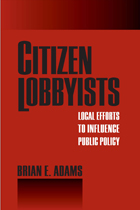 Citizen Lobbyists: Local Efforts to Influence Public Policy
Brian Adams
Temple University Press, 2006 Citizen Lobbyists explores how U.S. citizens participate in local government. Although many commentators have lamented the apathy of the American citizenry, Brian Adams focuses on what makes ordinary Americans become involved in and attempt to influence public policy issues that concern them. It connects theory and empirical data in a new and revealing way, providing both a thorough review of the relevant scholarly discussions and a detailed case study of citizen engagement in the politics of Santa Ana, a mid-sized Southern California city. After interviewing more than fifty residents, Adams found that they can be best described as "lobbyists" who identify issues of personal importance and then lobby their local government bodies. Through his research, he discovered that public meetings and social networks emerged as essential elements in citizens' efforts to influence local policy. By testing theory against reality, this work fills a void in our understanding of the actual participatory practices of "civically engaged" citizens.
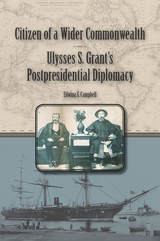 Citizen of a Wider Commonwealth: Ulysses S. Grant's Postpresidential Diplomacy
Edwina S. Campbell
Southern Illinois University Press, 2016 In 1877 former president Ulysses S. Grant, along with his family and friends, embarked on a two-year world tour that took him from Liverpool to Yokohama with stops throughout Europe and Asia. Biographies of Grant deal very briefly, if at all, with this tour and generally treat it as a pleasure trip filled with sightseeing, shopping, wining, and dining. Far from an extended vacation, however, Grant’s travels in fact constituted a diplomatic mission sanctioned by the U.S. government. In this revealing volume, Edwina S. Campbell chronicles Grant’s journey—the first diplomatic mission ever undertaken by a former U.S. president—and demonstrates how it marked a decided turning point in the role of the United States in world affairs.
Traveling commercially and on U.S. Navy warships, Grant visited ports of call throughout the British Empire, Europe, and Asia, including Britain, France, Egypt, the Ottoman Empire, Greece, Italy, the Netherlands, Germany, Scandinavia, Russia, Spain, Portugal, Gibraltar, Ireland, India, Singapore, Hong Kong, China, and Japan. Along the way, he met with monarchs, ministers, and average citizens, creating the model for the summitry and public diplomacy practiced by future American presidents and articulating concepts of national self-determination, international organization, and the peaceful settlement of international disputes decades before Elihu Root’s advocacy of binding international arbitration and Woodrow Wilson’s proposal for the League of Nations.
Campbell reveals Grant to be a skillful envoy who brought to his travels the deep interest in foreign policy issues he had shown during his administration. Grant confirmed the United States’ commitment to Anglo-American cooperation, demonstrated America’s interest in the territorial integrity of China, affirmed American faith in universal (male) suffrage as the basis for governmental legitimacy, and asserted the importance of an international order based on equality and justice for all states and their citizens. Grant’s efforts shaped not only John Hay’s Open Door policy in 1899–1900 but also the broader American approach to twentieth-century international relations. Throughout the trip, Julia Grant proved essential to the success of her husband’s mission, and Campbell tells how the couple impressed people around the world with an enduring image of an American president and first lady.
By illuminating the significance of Grant’s often overlooked postpresidential travels, Citizen of a Wider Commonwealth establishes the eighteenth president as a key diplomat whose work strongly influenced the direction of future U.S. foreign policy and contributes substantially to the study of American international relations.
 Citizen of Empire: Ethel Thomas Herold, an American in the Philippines
Theresa Kaminski
University of Tennessee Press, 2011
Ethel Thomas Herold (1896–1988) was an ordinary person caught up in extraordinary
circumstances—a woman whose sense of patriotic duty took her from small-town Wisconsin to the Philippines in 1922. There, with but a couple of brief interruptions, she would spend the next thirty-seven years, including three in a Japanese internment camp during World War II. In Citizen of Empire, Theresa Kaminski uses Ethel’s experiences of war and imperialism to explore a unique example of how those enormous forces helped shape Americans’ notions of citizenship and patriotism in the first half of the twentieth century.
As Kaminski’s absorbing narrative reveals, Ethel’s views of active patriotism began to form early on when her oldest brother became a schoolteacher in the Philippines in 1901 at the end of the Spanish-American War. After college and marriage, Ethel and her husband Elmer Herold went to the islands to teach in the public schools—a way, in her view, of spreading American ideals abroad. She quit teaching in 1927 to start a family but continued to support U.S. imperialism through her colonial household and club work. Her comfortable expatriate life fell apart, however, when the Japanese attacked the Philippines in 1941: the colonial elite were now powerless prisoners. After the war, wishing to help the people who had supported them during the occupation, Ethel and Elmer Herold stayed in the islands, but after Philippine independence came in 1946, they increasingly found themselves strangers in a place they had long called home. In 1959 the couple returned to Wisconsin, where Ethel remained politically active and saw the solution
to America’s Cold War problems in the conservative wing of the Republican Party.
Ethel Thomas Herold was a woman of forceful personality. Marked most notably by her strongly held views on patriotism and citizenship, her transpacific life offers a remarkable
instance of how the personal and political came together during the “American century.”
Theresa Kaminski is professor of history at the University of Wisconsin–Stevens Point and the author of Prisoners in Paradise: American Women in the Wartime South Pacific.
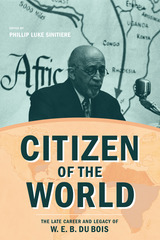 Citizen of the World: The Late Career and Legacy of W. E. B. Du Bois
Edited by Phillip Luke Sinitiere
Northwestern University Press, 2019 In his 1952 book In Battle for Peace, published when W. E. B. Du Bois was eighty-three years old, the brilliant black scholar announced that he was a “citizen of the world.” Citizen of the World chronicles selected chapters of Du Bois’s final three decades between the 1930s and 1960s. It maps his extraordinarily active and productive latter years to social, cultural, and political transformations across the globe.
From his birth in 1868 until his death in 1963, Du Bois sought the liberation of black people in the United States and across the world through intellectual and political labor. His tireless efforts documented and demonstrated connections between freedom for African-descended people abroad and black freedom at home.
In concert with growing scholarship on his twilight years, the essays in this volume assert the fundamental importance of considering Du Bois’s later decades not as a life in decline that descended into blind ideological allegiance to socialism and communism but as the life of a productive, generative intellectual who responded rationally, imaginatively, and radically to massive mid-century changes around the world, and who remained committed to freedom’s realization until his final hour.
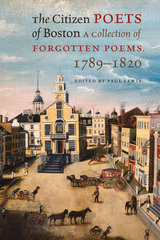 The Citizen Poets of Boston: A Collection of Forgotten Poems, 1789–1820
Edited by Paul Lewis
University Press of New England, 2016 Welcome to Boston in the early years of the republic. Prepare to journey by stagecoach with a young man moving to the “bustling city”; stop by a tavern for food, drink, and conversation; eavesdrop on clerks and customers in a dry-goods shop; get stuck in what might have been Boston’s first traffic jam; and enjoy arch comments about spouses, doctors, lawyers, politicians, and poets. As Paul Lewis and his students at Boston College reveal, regional vernacular poetry—largely overlooked or deemed of little or no artistic value—provides access to the culture and daily life of the city. Selected from over 4,500 poems published during the early national period, the works presented here, mostly anonymous, will carry you back to Old Boston to hear the voices of its long-forgotten citizen poets. A rich collection of lost poetry that will beguile locals and visitors alike.
Citizen Power: A Citizen Leadership Manual Introducing the Art of No-Blame Problem Solving
Harry S. Pozycki
Rutgers University Press, 2020 The Citizens Campaign, co-founded by the author and his wife, Caroline B. Pozycki, offers citizen leadership training and citizen leadership service opportunities for regular citizens. CITIZEN POWER gives all Americans the know how to become no-blame problem solvers and be part of what is emerging as a new model for a citizen driven national public service.
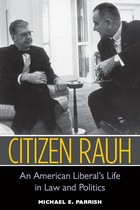 Citizen Rauh: An American Liberal's Life in Law and Politics
Michael E. Parrish
University of Michigan Press, 2011 "Joe Rauh was the type of lawyer who comes along maybe once in a generation---talented, politically astute, effective, and stubbornly devoted to principles, the type of person who not only could but did make a difference. He deserves a biography that explores not only his persona, but the America in which he lived and worked, and how he made a difference to so many people. Michael Parrish has given us just such a book, an exceedingly fine, well-written story that will make clear to another generation not only who Joe Rauh was, but why we as a nation will always need someone like him."
---Melvin I. Urofsky, Professor of Law and Public Policy, Virginia Commonwealth University "Michael Parrish has captured the life of this great civil libertarian in splendid fashion. His biography of this energetic New Deal liberal weaves effortlessly between public and private, friend and foe, victory and defeat. With Parrish as a sure guide, Citizen Rauh transports the reader through an American history that begins with Sacco and Vanzetti and ends as he battles CIA skullduggery in the 1980s. This biography should be on your shelf and in your heart."
---Nelson Lichtenstein, MacArthur Foundation Professor of History and Director of the Center for the Study of Work, Labor, and Democracy, University of California, Santa Barbara "Michael Parrish has fashioned a biography filled with Rauh's spirit, achievements, his losses, and above all, the importance of his presence. This is a wonderful account of a giant of late 20th century political and legal affairs."
---Stanley Kutler, E. Gordon Fox Professor Emeritus of American Institutions, History, and Law, University of Wisconsin, Madison Citizen Rauh tells the story of American lawyer Joseph L. Rauh Jr., who kept alive the ideals of New Deal liberalism and broadened those ideals to include a commitment to civil rights. Rauh's clients included Arthur Miller, Lillian Hellman, A. Philip Randolph, and the Mississippi Freedom Democratic Party. With good reason Freedom Rider John Lewis once called him "the blackest white man I ever knew." No lawyer in the post-1945 era did more to protect the economic interests of working-class Americans than Rauh, who fought for the unions as they struggled for legitimacy and against them when they betrayed their own members. No lawyer stood more courageously against repressive anticommunism during the 1950s or advanced the cause of racial justice more vigorously in the 1960s and 1970s. No lawyer did more to defend the constitutional vision of the Warren Court and resist the efforts of Richard Nixon and Ronald Reagan to undo its legacy. Throughout his life, Rauh continued to articulate a progressive vision of law and politics, ever confident that his brand of liberalism would become vital once again when the cycle of American politics took another turn. Michael E. Parrish is Distinguished Professor of History at the University of California, San Diego, where he has taught for forty years. A specialist in the legal and constitutional history of the United States, he has also taught at Nanjing University in the People's Republic of China, the University of Edinburgh, the University of Glasgow, and the University of Helsinki, where he was the Fulbright Bicentennial Professor of American Studies. Parrish is the author of five other books: Securities Regulation and the New Deal; Felix Frankfurter and His Times; Anxious Decades: America in Prosperity and Depression; The Hughes Court: Justices, Rulings, and Legacy; and The Supreme Court and Capital Punishment: Judging Death. His articles have appeared in the American Historical Review, the Historian, Diplomatic History, the Journal of the Supreme Court Historical Society, and the Yale Law Journal. Jacket design by Paula Newcomb Jacket photograph: Joseph L. Rauh Jr. with President Lyndon B. Johnson. Courtesy of the Estate of Olie W. Rauh.
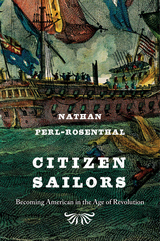 Citizen Sailors: Becoming American in the Age of Revolution
Nathan Perl-Rosenthal
Harvard University Press, 2015 In the decades after the United States formally declared its independence in 1776, Americans struggled to gain recognition of their new republic and their rights as citizens. None had to fight harder than the nation’s seamen, whose labor took them far from home and deep into the Atlantic world. Citizen Sailors tells the story of how their efforts to become American at sea in the midst of war and revolution created the first national, racially inclusive model of United States citizenship.
Nathan Perl-Rosenthal immerses us in sailors’ pursuit of safe passage through the ocean world during the turbulent age of revolution. Challenged by British press-gangs and French privateersmen, who considered them Britons and rejected their citizenship claims, American seamen demanded that the U.S. government take action to protect them. In response, federal leaders created a system of national identification documents for sailors and issued them to tens of thousands of mariners of all races—nearly a century before such credentials came into wider use.
Citizenship for American sailors was strikingly ahead of its time: it marked the federal government’s most extensive foray into defining the boundaries of national belonging until the Civil War era, and the government’s most explicit recognition of black Americans’ equal membership as well. This remarkable system succeeded in safeguarding seafarers, but it fell victim to rising racism and nativism after 1815. Not until the twentieth century would the United States again embrace such an inclusive vision of American nationhood.
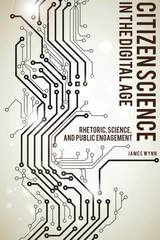 Citizen Science in the Digital Age: Rhetoric, Science, and Public Engagement
James Wynn
University of Alabama Press, 2016 A discussion of the benefits and pitfalls of citizen science—scientific undertakings that make use of public participation and crowd-sourced data collection
James Wynn’s timely investigation highlights scientific studies grounded in publicly gathered data and probes the rhetoric these studies employ. Many of these endeavors, such as the widely used SETI@home project, simply draw on the processing power of participants’ home computers; others, like the protein-folding game FoldIt, ask users to take a more active role in solving scientific problems. In Citizen Science in the Digital Age: Rhetoric, Science, and Public Engagement, Wynn analyzes the discourse that enables these scientific ventures, as well as the difficulties that arise in communication between scientists and lay people and the potential for misuse of publicly gathered data.
Wynn puzzles out the intricacies of these exciting new research developments by focusing on various case studies. He explores the Safecast project, which originated from crowd-sourced mapping for Fukushima radiation dispersal, arguing that evolving technologies enable public volunteers to make concrete, sound, science-based arguments. Additionally, he considers the potential use of citizen science as a method of increasing the public’s identification with the scientific community, and contemplates how more collaborative rhetoric might deepen these opportunities for interaction and alignment. Furthermore, he examines ways in which the lived experience of volunteers may be integrated with expert scientific knowledge, and also how this same personal involvement can be used to further policy agendas.
Precious few texts explore the intersection of rhetoric, science, and the Internet. Citizen Science in the Digital Age fills this gap, offering a clear, intelligent overview of the topic intended for rhetoric and communication scholars as well as practitioners and administrators in a number of science-based disciplines. With the expanded availability of once inaccessible technologies and computing power to laypeople, the practice of citizen science will only continue to grow. This study offers insight into how—given prudent application and the clear articulation of common goals—citizen science might strengthen the relationships between scientists and laypeople.
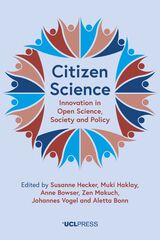 Citizen Science: Innovation in Open Science, Society and Policy
Edited by Susanne Hecker, Muki Haklay, Anne Bowser, Zen Makuch, Johannes Vogel, and Aletta Bonn
University College London, 2018 Citizen science, the active participation of the public in scientific research projects, is a rapidly expanding field in open science and open innovation. It provides an integrated model of public knowledge production and engagement with science. As a growing worldwide phenomenon, it is invigorated by evolving new technologies that connect people easily and effectively with the scientific community. Catalyzed by citizens’ wishes to be actively involved in scientific processes, as a result of recent societal trends, it also offers contributions to the rise in tertiary education. In addition, citizen science provides a valuable tool for citizens to play a more active role in sustainable development.
This book identifies and explains the role of citizen science within innovation in science and society, and as a vibrant and productive science-policy interface. The scope of this volume is global, geared towards identifying solutions and lessons to be applied across science, practice and policy. The chapters consider the role of citizen science in the context of the wider agenda of open science and open innovation and discuss progress towards responsible research and innovation, two of the most critical aspects of science today.
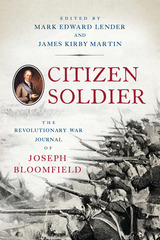 Citizen Soldier: The Revolutionary War Journal of Joseph Bloomfield
Mark Edward Lender and James K. Martin
Westholme Publishing, 2017 A New Edition of the Eyewitness Account that Introduced Readers to the Experience of the Continental Army
“About sunset we made a stand, when I was wounded, having a Ball with the Wad shot through my left forearm & the fuse set my coat and shirt on fire.” So wrote Major Joseph Bloomfield in his journal on September 11, 1777, describing his experiences during the hard-fought battle of Brandywine. Bloomfield was an officer in the 3rd New Jersey Regiment from 1776 to 1779. His service took him from Fort Stanwix to Fort Ticonderoga in New York, to the battle of Brandywine in Pennsylvania, and to the battle of Monmouth in his native state. He later served as governor of New Jersey from 1801 to 1812. A compassionate officer admired by his men, Bloomfield carefully recounted the hardships of military campaigns—the swings of morale, the shortage of supplies, the ever-present illnesses—and the intensity of combat. Of special interest are Bloomfield’s important notes on the culture and behavior of the Iroquois tribes known collectively as the Six Nations, which played a crucial role in revolutionary New York.
Unpublished and all but unknown when the first edition—skillfully edited by historians Mark Edward Lender and Joseph Kirby Martin—appeared, Bloomfield’s wartime journal was praised for providing both scholars and general readers with new information on the Continental soldier; the revolution’s impact on society; warfare in New York, New Jersey, and Pennsylvania; and the motives and actions of the revolutionary generation. Soldiers and civilians, Patriots and Tories, come alive in this fascinating eyewitness narrative. This new edition of Citizen Soldier: The Revolutionary War Journal of Joseph Bloomfield—the first in thirty-five years—includes a new introduction and bibliographic essay by the editors.
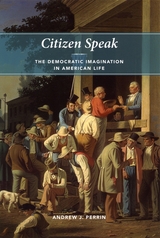 Citizen Speak: The Democratic Imagination in American Life
Andrew J. Perrin
University of Chicago Press, 2006 When we think about what constitutes being a good citizen, routine activities like voting, letter writing, and paying attention to the news spring to mind. But in Citizen Speak, Andrew J. Perrin argues that these activities are only a small part of democratic citizenship—a standard of citizenship that requires creative thinking, talking, and acting. For Citizen Speak, Perrin met with labor, church, business, and sports organizations and proposed to them four fictive scenarios: what if your senator is involved in a scandal, or your police department is engaged in racial profiling, or a local factory violates pollution laws, or your nearby airport is slated for expansion? The conversations these challenges inspire, Perrin shows, require imagination. And what people can imagine doing in response to those scenarios depends on what’s possible, what’s important, what’s right, and what’s feasible. By talking with one another, an engaged citizenry draws from a repertoire of personal and institutional resources to understand and reimagine responses to situations as they arise. Building on such political discussions, Citizen Speak shows how a rich culture of association and democratic discourse provides the infrastructure for a healthy democracy.
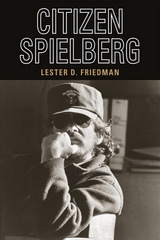 Citizen Spielberg
Lester D. Friedman
University of Illinois Press, 2010 Steven Spielberg is the director or producer of over one third of the thirty highest grossing films of all time, yet most film scholars dismiss him as little more than a modern P. T. Barnum--a technically gifted and intellectually shallow showman who substitutes spectacle for substance. To date, no book has attempted to analyze the components of his worldview, the issues which animate his most significant works, the roots of his immense acceptance, and the influence his vast spectrum of imaginative products exerts on the public consciousness.
In Citizen Spielberg, Lester D. Friedman fills that void with a systematic analysis of the various genres in which the director has worked, including science fiction (E.T.), adventure (Raiders trilogy), race films (The Color Purple, Amistad), and war films (Saving Private Ryan, Schindler’s List). Friedman concludes that Spielberg’s films present a sustained artistic vision combined with a technical flair matched by few other filmmakers, and makes a compelling case for Spielberg to be considered as a major film artist.
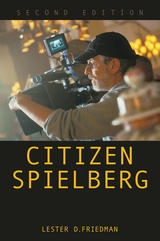 Citizen Spielberg
Lester D. Friedman
University of Illinois Press, 2022 Steven Spielberg's extraordinary career redefined Hollywood, but his achievement goes far beyond shattered box office records. Rejecting the view of Spielberg as a Barnumesque purveyor of spectacle, Lester D. Friedman presents the filmmaker as a major artist who pairs an ongoing willingness to challenge himself with a widely recognized technical mastery. This new edition of Citizen Spielberg expands Friedman’s original analysis to include films of the 2010s like Lincoln and Ready Player One. Breaking down the works by genre, Friedman looks at essential aspects of Spielberg’s art, from his storytelling concerns and worldview to the uncanny connection with audiences that has powered his longtime influence as a cultural force. Friedman's examination reveals a sustained artistic vision--a vision that shows no sign of exhausting itself or audiences after Spielberg's nearly fifty years as a high-profile filmmaker. Incisive and discerning, Citizen Spielberg offers a career-spanning appraisal of a moviemaking icon.
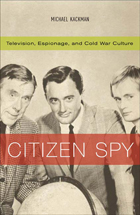 Citizen Spy: Television, Espionage, and Cold War Culture
Michael Kackman
University of Minnesota Press, 2005 In Citizen Spy, Michael Kackman investigates how media depictions of the slick, smart, and resolute spy have been embedded in the American imagination. Looking at secret agents on television and the relationships among networks, producers, government bureaus, and the viewing public in the 1950s and 1960s, Kackman explores how Americans see themselves in times of political and cultural crisis.
During the first decade of the Cold War, Hollywood developed such shows as I Led 3 Lives and Behind Closed Doors with the approval of federal intelligence agencies, even basing episodes on actual case files. These “documentary melodramas” were, Kackman argues, vehicles for the fledgling television industry to proclaim its loyalty to the government, and they came stocked with appeals to patriotism and anti-Communist vigilance.
As the rigid cultural logic of the Red Scare began to collapse, spy shows became more playful, self-referential, and even critical of the ideals professed in their own scripts. From parodies such as The Man from U.N.C.L.E. and Get Smart to the more complicated global and political situations of I Spy and Mission: Impossible, Kackman situates espionage television within the tumultuous culture of the civil rights and women’s movements and the war in Vietnam. Yet, even as spy shows introduced African-American and female characters, they continued to reinforce racial and sexual stereotypes.
Bringing these concerns to the political and cultural landscape of the twenty-first century, Kackman asserts that the roles of race and gender in national identity have become acutely contentious. Increasingly exclusive definitions of legitimate citizenship, heroism, and dissent have been evident through popular accounts of the Iraq war. Moving beyond a snapshot of television history, Citizen Spy provides a contemporary lens to analyze the nature—and implications—of American nationalism in practice.
Michael Kackman is assistant professor in Radio-Television-Film at the University of Texas, Austin.
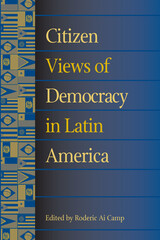 Citizen Views of Democracy in Latin America
Roderic Ai Camp
University of Pittsburgh Press, 2001 When Americans and Latin Americans talk about democracy, are they imagining the same thing? For years, researchers have suspected that fundamental differences exist between how North Americans view and appraise the concept of democracy and how Latin Americans view the same term. These differences directly affect the evolution of democratization and political liberalization in the countries of the region, and understanding them has tremendous consequences for U.S.–Latin American relations. But until now there has been no hard data to make “the definition of democracy” visible, and thus able to be interpreted. This book, the culmination of a monumental survey project, is the first attempt to do so.
Camp headed a research team that in 1998 surveyed 1,200 citizens in three countries—three distinct cases of democratic transition. Costa Rica is alleged to be the most democratic in Latin America; Mexico is a country in transition toward democracy; Chile is returning to democracy after decades of severe repression. The survey was
carefully designed to show how the average citizen in each of these nations understands democracy.
In Citizen Views of Democracy in Latin America, ten leading scholars of the region analyze and interpret the results. Written with scholar and undergraduate in mind, the essays explore the countries individually, showing how the meaning of democracy varies among them. A key theme emerges: there is no uniform “Latin American” understanding of democracy, though the nations share important patterns. Other essays trace issues across boundaries, such as the role of ethnicity on perceptions of democracy. Several of the contributors also compare democratic norms in Latin America with those outside the region, including the United States. Concluding essays analyze the institutional and policy consequences of the data, including how attitudes toward private versus public ownership are linked to democratization.
Every essay in the collection is based on the same data set, included on a CD-ROM packaged within each book, resulting in an organically cohesive work ideally suited for use in courses introducing Latin American and Third World politics, comparative politics, democratic transition, and research methods. Scholars and students may use the software and data set on the CD-ROM for comparative research projects linked to the essays in the volume.
Citizen Voices: Performing Public Participation in Science and Environment Communication
Edited by Louise Phillips, Anabela Carvalho, and Julie Doyle
Intellect Books, 2012 This volume explores the ways in which citizen voices on science and environmental issues are articulated, heard, marginalized, and silenced in mass media, policymaking, and other public venues. In a range of case studies from countries across Europe and North America, contributors offer empirical insights about the articulation of citizen voices, as well as citizens’ scope for action in different national, cultural, and institutional contexts. Drawing on science and technology, environmental studies, and media and communication studies, they also present methods for foregrounding the role of communication in scientific and environmental governance.
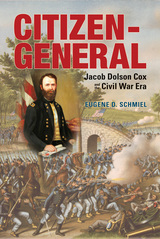 Citizen-General: Jacob Dolson Cox and the Civil War Era
Eugene D. Schmiel
Ohio University Press, 2014 A History Book Club Reading Selection
The wrenching events of the Civil War transformed not only the United States but also the men unexpectedly called on to lead their fellow citizens in this first modern example of total war. Jacob Dolson Cox, a former divinity student with no formal military training, was among those who rose to the challenge. In a conflict in which “political generals” often proved less than competent, Cox, the consummate citizen general, emerged as one of the best commanders in the Union army.
During his school days at Oberlin College, no one could have predicted that the intellectual, reserved, and bookish Cox possessed what he called in his writings the “military aptitude” to lead men effectively in war. His military career included helping secure West Virginia for the Union; jointly commanding the left wing of the Union army at the critical Battle of Antietam; breaking the Confederate supply line and thereby precipitating the fall of Atlanta; and holding the defensive line at the Battle of Franklin, a Union victory that effectively ended the Confederate threat in the West.
At a time when there were few professional schools other than West Point, the self-made man was the standard for success; true to that mode, Cox fashioned himself into a Renaissance man. In each of his vocations and avocations—general, governor, cabinet secretary, university president, law school dean, railroad president, historian, and scientist—he was recognized as a leader. Cox’s greatest fame, however, came to him as the foremost participant historian of the Civil War. His accounts of the conflict are to this day cited by serious scholars and serve as a foundation for the interpretation of many aspects of the war.
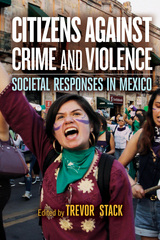 Citizens against Crime and Violence: Societal Responses in Mexico
Trevor Stack
Rutgers University Press, 2022 Mexico has become notorious for crime-related violence, and the efforts of governments and national and international NGOs to counter this violence have proven largely futile. Citizens against Crime and Violence studies societal responses to crime and violence within one of Mexico’s most affected regions, the state of Michoacán. Based on comparative ethnography conducted over twelve months by a team of anthropologists and sociologists across six localities of Michoacán, ranging from the most rural to the most urban, the contributors consider five varieties of societal responses: local citizen security councils that define security and attempt to influence its policing, including by self-defense groups; cultural activists looking to create safe 'cultural' fields from which to transform their social environment; organizations in the state capital that combine legal and political strategies against less visible violence (forced disappearance, gender violence, anti-LGBT); church-linked initiatives bringing to bear the church’s institutionality, including to denounce 'state capture'; and women’s organizations creating 'safe' networks allowing to influence violence prevention.
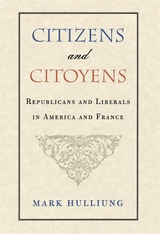 Citizens and Citoyens: Republicans and Liberals in America and France
Mark Hulliung
Harvard University Press, 2002 In a tour de force of comparative intellectual history, Mark Hulliung sharply challenges conventional wisdom about the political nature of the "sister republics," America and France.
Hulliung argues that the standard American account of a continuous Jacobin republican tradition--"illiberal to the core"--is fatally misleading. In reality it was the nineteenth-century French liberals who undermined the cause of liberalism, and it was French republicans who eventually saved liberal ideals. And comparison with France provides compelling evidence that the American republic was from the beginning both liberal and republican; Americans have been engaged in the "right debate, wrong country." Antiliberal intellectuals--New Leftists, neoconservatives, and communitarians alike--have disfigured much of the "republican" scholarship by falsely conjuring up a history of the United States wherein rooted and moral republicans once held sway where today we encounter uprooted and amoral liberals.
Lively, stimulating, and sure to be controversial, Citizens and Citoyens is a valuable contribution to the political culture debate.
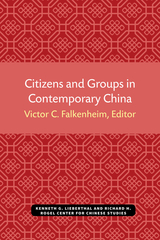 Citizens and Groups in Contemporary China
Victor C. Falkenheim, Editor
University of Michigan Press, 1987 Citizens and Groups in Contemporary China began with two symposia held in 1977 and 1978. The first, a workshop on “The Pursuit of Interest in China,” was held in August 1977 at the University of Michigan, and was organized by Michel Oksenberg and Richard Baum. It was supported by a grant from the Joint Committee on Contemporary China of the Social Science Research Council and the American Council of Learned Societies, using funds provided by the Andrew Mellon Foundation. Its principal goal was to use detailed case studies to explore the relevance of interest group approaches to the study of Chinese politics. The second, a panel organized by the editor for the 1978 Chicago meeting of the Association of Asian Studies, sought to apply participatory approaches to the role of social groups in the Chinese political process. The striking degree of overlap in the focus, methodology, and participants in both meetings suggested to a number of the paper writers that there was a need for a more eclectic approach which would focus simultaneously on individual and group actors. The recognition that a volume based on such an approach might serve the needs of students and scholars seeking to examine the dynamics of informal influence and power in China was the stimulus for publishing the studies presented here in book form. [ix]
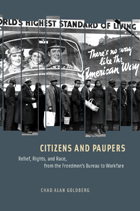 Citizens and Paupers: Relief, Rights, and Race, from the Freedmen's Bureau to Workfare
Chad Alan Goldberg
University of Chicago Press, 2008 There was a time when America’s poor faced a stark choice between access to social welfare and full civil rights—a predicament that forced them to forfeit their citizenship in exchange for economic relief. Over time, however, our welfare system improved dramatically. But as Chad Alan Goldberg here demonstrates, its legacy of disenfranchisement persisted. Indeed, from Reconstruction onward, welfare policies have remained a flashpoint for recurring struggles over the boundaries of citizenship.
Citizens and Paupers explores this contentious history by analyzing and comparing three major programs: the Freedmen’s Bureau, the Works Progress Administration, and the present-day system of workfare that arose in the 1990s. Each of these overhauls of the welfare state created new groups of clients, new policies for aiding them, and new disputes over citizenship—conflicts that were entangled in racial politics and of urgent concern for social activists.
This combustible mix of racial tension and social reform continues to influence how we think about welfare, and Citizens and Paupers is an invaluable analysis of the roots of the debate.
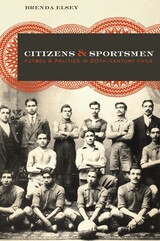 Citizens and Sportsmen: Fútbol and Politics in Twentieth-Century Chile
By Brenda Elsey
University of Texas Press, 2011 Fútbol, or soccer as it is called in the United States, is the most popular sport in the world. Millions of people schedule their lives and build identities around it. The World Cup tournament, played every four years, draws an audience of more than a billion people and provides a global platform for displays of athletic prowess, nationalist rhetoric, and commercial advertising. Fútbol is ubiquitous in Latin America, yet few academic histories of the sport exist, and even fewer focus on its relevance to politics in the region. To fill that gap, this book uses amateur fútbol clubs in Chile to understand the history of civic associations, popular culture, and politics. In Citizens and Sportsmen, Brenda Elsey argues that fútbol clubs integrated working-class men into urban politics, connected them to parties, and served as venues of political critique. In this way, they contributed to the democratization of the public sphere. Elsey shows how club members debated ideas about class, ethnic, and gender identities, and also how their belief in the uniquely democratic nature of Chile energized state institutions even as it led members to criticize those very institutions. Furthermore, she reveals how fútbol clubs created rituals, narratives, and symbols that legitimated workers' claims to political subjectivity. Her case study demonstrates that the relationship between formal and informal politics is essential to fostering civic engagement and supporting democratic practices.
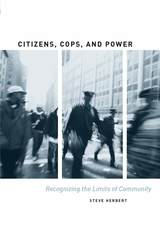 Citizens, Cops, and Power: Recognizing the Limits of Community
Steve Herbert
University of Chicago Press, 2006 Politicians, citizens, and police agencies have long embraced community policing, hoping to reduce crime and disorder by strengthening the ties between urban residents and the officers entrusted with their protection.
That strategy seems to make sense, but in Citizens, Cops, and Power, Steve Herbert reveals the reasons why it rarely, if ever, works. Drawing on data he collected in diverse Seattle neighborhoods from interviews with residents, observation of police officers, and attendance at community-police meetings, Herbert identifies the many obstacles that make effective collaboration between city dwellers and the police so unlikely to succeed. At the same time, he shows that residents’ pragmatic ideas about the role of community differ dramatically from those held by social theorists.
Surprising and provocative, Citizens, Cops, and Power provides a critical perspective not only on the future of community policing, but on the nature of state-society relations as well.
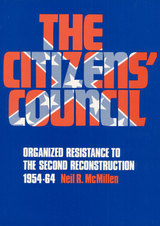 The Citizens' Council: Organized Resistance to the Second Reconstruction, 1954-64
Neil R. McMillen
University of Illinois Press, 1971 This in-depth account of the rise
and decline of the Citizens' Councils of America details the organization's
role in the massive resistance to school desegregation in the South following
the 1954 Brown vs. Board of Education decision. Included are a new preface and
updated bibliography.
"A tour de force of research and
narration. . . in highly readable style. [McMillen] . . . seems to have read
everything the historical record has to offer on the subject and to have known
exactly what to make of it. . . Himself squarely on the side of the future,
he is sensitive to the anguish that prompted the hysteria of the misguided racist. . . .
By any test, a masterful study." -- Journal of Southern History
"Takes seriously the people who
made the movement, when ridicule and caricature would have been an easier analytical
technique. Solidly researched and well written. . . an intriguing story." --
Augustus M. Burns, Social Studies
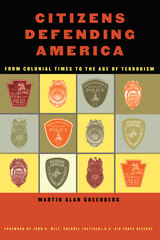 Citizens Defending America: From Colonial Times to the Age of Terrorism
Martin Alan Greenberg
University of Pittsburgh Press, 2005
Today, concerns over homeland security have led thousands of Americans to volunteer for various citizen emergency response groups, such as the Civil Air Patrol, U.S. Coast Guard Auxiliary, Community Emergency Response Teams, fire units, etc. In Citizens Defending America, Martin Greenberg focuses new attention on the subject of citizen volunteerism by chronicling the nature and purpose of volunteer police units—authorized organizations of a public or private nature that work at deterring crime and/or preventing terrorism for little or no monetary compensation—in America since 1620. A number of these historical groups responsible for maintaining the civil order of the day—slave patrols, frontier posses, vice suppression societies, the American Protective League, for example—now seem controversial when viewed through a contemporary lens. Greenberg uses the history of such groups to reflect upon the nation’s past and to consider the possibilities for a safe and secure future. He also emphasizes the role of young people in the fields of security and safety, and stresses the need for more qualified, trained volunteers to help cope with man-made and natural disasters.
 Citizens Divided: Campaign Finance Reform and the Constitution
Robert C. Post
Harvard University Press, 2014 The Supreme Court’s 5–4 decision in Citizens United v. Federal Election Commission, which struck down a federal prohibition on independent corporate campaign expenditures, is one of the most controversial opinions in recent memory. Defenders of the First Amendment greeted the ruling with enthusiasm, while advocates of electoral reform recoiled in disbelief. Robert C. Post offers a new constitutional theory that seeks to reconcile these sharply divided camps.
Post interprets constitutional conflict over campaign finance reform as an argument between those who believe self-government requires democratic participation in the formation of public opinion and those who believe that self-government requires a functioning system of representation. The former emphasize the value of free speech, while the latter emphasize the integrity of the electoral process. Each position has deep roots in American constitutional history. Post argues that both positions aim to nurture self-government, which in contemporary life can flourish only if elections are structured to create public confidence that elected officials are attentive to public opinion. Post spells out the many implications of this simple but profound insight. Critiquing the First Amendment reasoning of the Court in Citizens United, he also shows that the Court did not clearly grasp the constitutional dimensions of corporate speech.
Blending history, constitutional law, and political theory, Citizens Divided explains how a Supreme Court case of far-reaching consequence might have been decided differently, in a manner that would have preserved both First Amendment rights and electoral integrity.
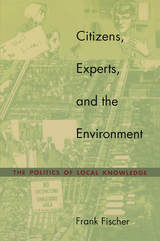 Citizens, Experts, and the Environment: The Politics of Local Knowledge
Frank Fischer
Duke University Press, 2000 The tension between professional expertise and democratic governance has become increasingly significant in Western politics. Environmental politics in particular is a hotbed for citizens who actively challenge the imposition of expert theories that ignore forms of local knowledge that can help to relate technical facts to social values.
Where information ideologues see the modern increase in information as capable of making everyone smarter, others see the emergence of a society divided between those with and those without knowledge. Suggesting realistic strategies to bridge this divide, Fischer calls for meaningful nonexpert involvement in policymaking and shows how the deliberations of ordinary citizens can help solve complex social and environmental problems by contributing local contextual knowledge to the professionals’ expertise. While incorporating theoretical critiques of positivism and methodology, he also offers hard evidence to demonstrate that the ordinary citizen is capable of a great deal more participation than is generally recognized. Popular epidemiology in the United States, the Danish consensus conference, and participatory resource mapping in India serve as examples of the type of inquiry he proposes, showing how the local knowledge of citizens is invaluable to policy formation. In his conclusion Fischer examines the implications of the approach for participatory democracy and the democratization of contemporary deliberative structures.
This study will interest political scientists, public policy practitioners, sociologists, scientists, environmentalists, political activists, urban planners, and public administrators along with those interested in understanding the relationship between democracy and science in a modern technological society.
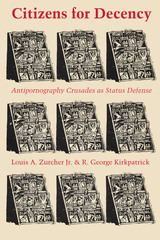 Citizens for Decency: Antipornography Crusades as Status Defense
By Louis A. Zurcher, Jr. and R. George Kirkpatrick
University of Texas Press, 1976 Throughout the United States, groups of individuals have been confronting the issues surrounding sexually explicit materials. Many have concurred in their perceptions of what is pornographic, have assessed pornography to be a problem our society must deal with, and have made organized efforts within their communities to stop or restrict the commercial availability of such materials. Citizens for Decency is an examination of two antipornography crusades, one in the Midwest and the other in the Southwest. It examines the evolution and impact of such crusades, the satisfaction derived from participating, and the relevant characteristics of the participants and their opponents. It is the first systematic, comprehensive, and theory-oriented study of antipornography crusades and one of the few studies that analyze movements to resist change. The book begins with the assumption that the term pornography is a value judgment and that the labeling of sexually explicit materials as “pornographic” can be adequately understood only in the wider context of sociological and psychological structures and processes. In approaching the antipornography crusades, Louis A. Zurcher and R. George Kirkpatrick gathered data by observation and document search and by interviews with persons well informed about and central to the crusades. Their examination of the organizations that directed the two movements is particularly extensive, and their comparative analysis of the two organizations allows them to determine which features are the most important, how these characteristics interact, and what their relationship is to the symbolic crusade. Among their important findings, the authors show that antipornography crusaders are people discontent with their status who have mobilized to protect the dominance and prestige of their traditional life styles. The participants in the crusades are shown to differ from their opponents in a number of significant ways. In the final chapters, the authors analyze their findings with reference to social movement theory and offer predictions concerning future symbolic crusades.
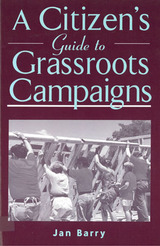 A Citizen's Guide to Grassroots Campaigns
Barry, Jan
Rutgers University Press, 2000 Civic movements are essential to Americans’ freedom and quality of life. Active citizens have led the way from the American Revolution to urban renewal. But fiery emotions and good intentions without skillful organization can lead to frustrated civic involvement. How can individual concerns be transformed into effective community action? Jan Barry provides a pragmatic, common-sense handbook to civic action. Using case studies from his home state of New Jersey, Barry has crafted what he calls a “guidebook for creative improvement on the American dream.” He dissects civic actions such as environmental campaigns, mutual-help groups, neighborhood improvement projects, and a grassroots peace mission to Russia. Looking for patterns to explain successes and failures, Barry includes his own experiences as a Vietnam veteran peace activist to inspire and coach fledgling activists. The result is a wealth of practical, non-partisan information on membership recruitment, organizational skills, public speaking, lobbying, publicity, conflict resolution, and more. Rising above any particular political, social, or religious beliefs, Barry shows would-be activists how to confront one enduring truth —“Democracy is a lot harder to do than it is to talk about or fight over.”
Citizens in the Present: Youth Civic Engagement in the Americas
Maria de los Angeles Torres, Irene Rizzini, and Norma Del Rio
University of Illinois Press, 2013 Although media coverage often portrays young people in urban areas as politically apathetic or disruptive, this book provides an antidote to such views through narratives of dedicated youth civic engagement and leadership in Chicago, Mexico City, and Rio de Janeiro. This innovative comparative study provides nuanced accounts of the personal experiences of young people who care deeply about their communities and are actively engaged in a variety of public issues. Drawing from extensive interviews and personal narratives from the young activists themselves, Citizens in the Present presents a vibrant portrait of a new, politically involved generation.
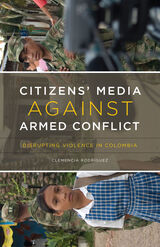 Citizens’ Media against Armed Conflict: Disrupting Violence in Colombia
Clemencia Rodríguez
University of Minnesota Press, 2011 For two years, Clemencia Rodríguez did fieldwork in regions of Colombia where leftist guerillas, right-wing paramilitary groups, the army, and drug traffickers made their presence felt in the lives of unarmed civilians. Here, Rodríguez tells the story of the ways in which people living in the shadow of these armed intruders use community radio, television, video, digital photography, and the Internet to shield their communities from armed violence’s negative impacts. Citizens’ media are most effective, Rodríguez posits, when they understand communication as performance rather than simply as persuasion or the transmission of information. Grassroots media that are deeply embedded in the communities they serve and responsive to local needs strengthen the ability of community members to productively react to violent incursions. Rodríguez demonstrates how citizens’ media privilege aspects of community life not hijacked by violence, providing people with the tools and the platform to forge lives for themselves and their families that are not entirely colonized by armed conflict and its effects. Ultimately, Rodríguez shows that unarmed civilian communities that have been cornered by armed conflict can use community media to repair torn social fabrics, reconstruct eroded bonds, reclaim public spaces, resolve conflict, and sow the seeds of peace and stability.
Citizens of Beauty: Poems of Jean Sénac
Jean Sénac
Michigan State University Press, 2016 Now available in English for the first time, translated by the poet Jack Hirschman, this beautiful collection of poems by the Algerian poet Jean Sénac (1926–1973) was originally published when he was forty-one. Sénac represented the hope of the new generation of Algerians who were celebrating their independence from France after 130 years of colonialism, and in the tradition of René Char and the early Albert Camus, he portrayed an Algeria whose land and people would finally sing with their own voice. Sénac celebrates revolution, love, and the body, beginning with the resonant verses: “And now we’ll sing love / for there’s no Revolution without love.” He sang, as well, of beauty: “No morning without smiling. / Beauty on our lips is one continuous fruit.”
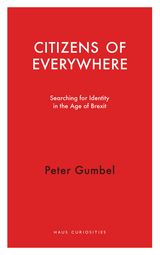 Citizens of Everywhere: Searching for Identity in the Age of Brexit
Peter Gumbel
Haus Publishing, 2020 In 1939, as war loomed, Peter Gumbel’s Jewish-born grandparents fled Nazi Germany for England. But within a matter of decades, their grandson, appalled by the Brexit referendum, had become a citizen of the country they fled eighty years ago. How had it come to this?
Drawing on one family’s migration stories, Citizens of Everywhere explores the nature of belonging amid cycles of pluralism and nationalism. In an increasingly global world, nativist and diasporic impulses pull many people in contradictory directions that can be difficult to even understand. In Citizens of Everywhere, Gumbel grapples with this complexity through his own family history, revealing the personal costs of Britain’s recent isolationist retreat. Along the way, he laments the decline of British pluralism at the worst possible moment—as it rejects the European project and engages in an ill-fated struggle against an ever more interconnected world.
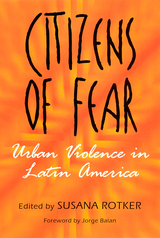 Citizens of Fear: Urban Violence in Latin America
Rotker, Susana
Rutgers University Press, 2004 Citizens in Latin American cities live in constant fear, amidst some of the most dangerous conditions on earth. In that vast region, 140 thousand people die violently each year, and one out of three citizens have been directly or indirectly victimized by violence. In Venezuela, adults are on average targets of crime seventeen crimes in their lifetimes, four of which are violent. In Mexico, 97 percent of all reported crimes go unpunished. Crime, in effect, is an undeclared war. Citizens of Fear, in part, assembles survey results of social scientists who document the pervasiveness of violence. But the numbers tell only part of the story. Other contributors present moving testimonials by the victimized and by journalists covering the scene. A third group of essayists explores the implications of the resulting fear for both thought and behavior. As Susana Rotker writes, "The city has been transformed into a space of vulnerability and danger...What I am interested in narrating here is...the generalized sensation of insecurity that taints the Latin American capitals, the sensation that has changed the ways people relate to urban space, to other human beings, to the state, and to the very concept of citizenship. "
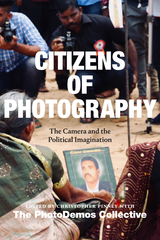 Citizens of Photography: The Camera and the Political Imagination
Edited by Christopher Pinney with the PhotoDemos Collective (Naluwembe Binaisa, Vindhya Buthpitiya, Konstantinos Kalantzis, Christopher Pinney, Ileana L. Selejan, and Sokphea Young)
Duke University Press, 2023 Citizens of Photography explores how photography offers access to forms of citizenship beyond those available through ordinary politics. Through contemporary ethnographic investigations of photographic practice in Nicaragua, Nigeria, Greece, India, Nepal, Sri Lanka, Bangladesh, and Cambodia, the PhotoDemos Collective traces the resonances between political representation and photographic representation. The authors emphasize photography as lived practice and how photography’s performative, transformative, and transgressive possibilities facilitate the articulation of new identities. They analyze photography ranging from family albums and social media to state and public archives, showing how it points to new destinations in the context of social movements, the aftermath of atrocity and civil war, and the legacies of past injustices. By foregrounding photography’s open-ended and contingent nature and its ability to subvert and reconfigure conventional political identifications, this volume demonstrates that as much as photography looks to the past, it points to the future, acting in advance of social reality.
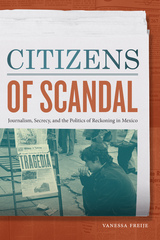 Citizens of Scandal: Journalism, Secrecy, and the Politics of Reckoning in Mexico
Vanessa Freije
Duke University Press, 2020 In Citizens of Scandal, Vanessa Freije explores the causes and consequences of political scandals in Mexico from the 1960s through the 1980s. Tracing the process by which Mexico City reporters denounced official wrongdoing, she shows that by the 1980s political scandals were a common feature of the national media diet. News stories of state embezzlement, torture, police violence, and electoral fraud provided collective opportunities to voice dissent and offered an important, though unpredictable and inequitable, mechanism for political representation. The publicity of wrongdoing also disrupted top-down attempts by the ruling Partido Revolucionario Institucional to manage public discourse, exposing divisions within the party and forcing government officials to grapple with popular discontent. While critical reporters denounced corruption, they also withheld many secrets from public discussion, sometimes out of concern for their safety. Freije highlights the tensions—between free speech and censorship, representation and exclusion, and transparency and secrecy—that defined the Mexican public sphere in the late twentieth century.
 Citizens of Worlds: Open-Air Toolkits for Environmental Struggle
Jennifer Gabrys
University of Minnesota Press, 2022 An unparalleled how-to guide to citizen-sensing practices that monitor air pollution
Modern environments are awash with pollutants churning through the air, from toxic gases and intensifying carbon to carcinogenic particles and novel viruses. The effects on our bodies and our planet are perilous. Citizens of Worlds is the first thorough study of the increasingly widespread use of digital technologies to monitor and respond to air pollution. It presents practice-based research on working with communities and making sensor toolkits to detect pollution while examining the political subjects, relations, and worlds these technologies generate. Drawing on data from the Citizen Sense research group, which worked with communities in the United States and the United Kingdom to develop digital-sensor toolkits, Jennifer Gabrys argues that citizen-oriented technologies promise positive change but then collide with entrenched and inequitable power structures. She asks: Who or what constitutes a “citizen” in citizen sensing? How do digital sensing technologies enable or constrain environmental citizenship? Spanning three project areas, this study describes collaborations to monitor air pollution from fracking infrastructure, to document emissions in urban environments, and to create air-quality gardens. As these projects show, how people respond to, care for, and struggle to transform environmental conditions informs the political subjects and collectives they become as they strive for more breathable worlds.
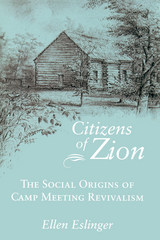 Citizens of Zion: The Social Origins of Camp Meeting Revivalism
Ellen Eslinger
University of Tennessee Press, 1999 One of America's most enduring forms of public worship, the camp meeting had its beginnings at the dawn of the nineteenth century during the “Great Revival” that swept the newly settled regions of the young republic. Camping out at religious gatherings brought people from diverse backgrounds into close and sustained contact, creating a small society governed by religious harmony. The culmination of this phenonenon came in 1801 at Cane Ridge Presbyterian meetinghouse in Kentucky, where more than ten thousand people gathered for a week of worship and fellowship.
To trace the origins of the camp meeting, Ellen Eslinger follows Kentucky's development from its initial settlement in 1775 to the eve of the Great Revival. She describes how a region first characterized by border warfare during the Revolution quickly cast off its frontier beginnings. Even so, she demonstrates, settlers found it difficult to cope with challenges posed by economic competition, political partisanship, and cultural conflict. In this time of uncertainty, camp meetings brought a restored sense of community attachment, merging Christian and republican ideals to create a new model of American society.
Citizens of Zion does more than explain a particular instance of religious revivalism; it explores the creation of a new form of worship that enabled people to relate more comfortably to a changing society through an intense collective experience. It explains how early camp meeting revivalism—as exemplified by the Cane Ridge gathering—differed significantly from both earlier evangelical forms and later manifestations. Camp meeting revivalism, Eslinger shows, eventually came to reflect the emerging liberal culture, but its early years reveal it as an important mechanism for reintegration into a rapidly transforming world.
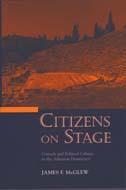 Citizens on Stage: Comedy and Political Culture in the Athenian Democracy
James F. McGlew
University of Michigan Press, 2002 In Citizens on Stage, James F. McGlew studies the political constructions of Athenian public and private life in the late fifth and early fourth centuries B.C.E., a period in which democracy underwent several important changes. It saw the emergence of new ideas of political participation--some supportive of democracy, others hostile--that were particularly significant in reshaping images of citizenship.
Old Comedy gives Citizens on Stage its chronological backbone; the beginning and end of Aristophanes' career roughly define the period on which the book concentrates. Reading and interpreting comedy provides a model for reading Athenian politics itself. McGlew argues that the plays of Old Comedy, with their fantastic stories of common individuals triumphing over the various social and political dilemmas of democratic Athens, interpreted the relationship of private life and political activity for an Athenian audience, dramatically reaffirming the ties between citizens' personal desires and the will of the collective body. In particular, McGlew argues that comedy transforms private fantasies of personal power and pleasures--what seem most to keep the individual audience members apart--into a collective possession and touchstone of democratic citizen identity.
Citizens on Stage focuses primarily on the democratic citizen and on contemporary representations of him as a decision maker. McGlew shows that the democratic individual, sometimes idealized, sometimes despised, was a dominant concern of the literature and politics of late fifth- and early fourth-century Athens. This book will appeal to students of ancient theater and drama, Athenian politics and democracy, and the relationships between theater and politics. Social historians will also find it an invaluable resource.
James F. McGlew is Assistant Professor of Foreign Languages and Literatures and Classical Studies, Iowa State University.
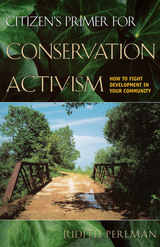 Citizen's Primer for Conservation Activism: How to Fight Development in Your Community
By Judith Perlman
University of Texas Press, 2004 Is there anything you can do when development threatens your local forest, beach, prairie, or wetland? Yes, there is. Across America, citizen activists are fighting and winning battles against unwanted development in their own communities. To help you resist the urban sprawl and absentee landowners that can wreck small towns and cities alike, this book is a practical, hands-on guide for building a grassroots campaign to defeat undesirable development. Written by a successful activist, Citizen's Primer for Conservation Activism takes you through all the steps necessary to stop unplanned development in your community: - Identifying the issues at stake
- Getting involved and developing leadership
- Devising a strategy
- Hiring and working with legal counsel
- Building coalitions and partnerships
- Influencing local government
- Conducting a media campaign
- Raising money
- Countering developer tactics
- Managing the whole process
With the proven strategies in this easy-to-access book, you can quickly gear up to challenge unwanted development and preserve the character of your local community.
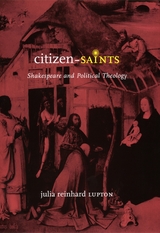 Citizen-Saints: Shakespeare and Political Theology
Julia Reinhard Lupton
University of Chicago Press, 2005 Turning to the potent idea of political theology to recover the strange mix of political and religious thinking during the Renaissance, this bracing study reveals in the works of Shakespeare and his sources the figure of the citizen-saint, who represents at once divine messenger and civil servant, both norm and exception. Embodied by such diverse personages as Antigone, Paul, Barabbas, Shylock, Othello, Caliban, Isabella, and Samson, the citizen-saint is a sacrificial figure: a model of moral and aesthetic extremity who inspires new regimes of citizenship with his or her death and martyrdom.
Among the many questions Julia Reinhard Lupton attempts to answer under the rubric of the citizen-saint are: how did states of emergency, acts of sovereign exception, and Messianic anticipations lead to new forms of religious and political law? What styles of universality were implied by the abject state of the pure creature, at sea in a creation abandoned by its creator? And how did circumcision operate as both a marker of ethnicity and a means of conversion and civic naturalization?
Written with clarity and grace, Citizen-Saints will be of enormous interest to students of English literature, religion, and early modern culture.
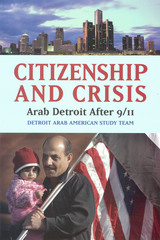 Citizenship and Crisis: Arab Detroit After 9/11
Detroit Arab American Study Group
Russell Sage Foundation, 2009 Is citizenship simply a legal status or does it describe a sense of belonging to a national community? For Arab Americans, these questions took on new urgency after 9/11, as the cultural prejudices that have often marginalized their community came to a head. Citizenship and Crisis reveals that, despite an ever-shifting definition of citizenship and the ease with which it can be questioned in times of national crisis, the Arab communities of metropolitan Detroit continue to thrive. A groundbreaking study of social life, religious practice, cultural values, and political views among Detroit Arabs after 9/11, Citizenship and Crisis argues that contemporary Arab American citizenship and identity have been shaped by the chronic tension between social inclusion and exclusion that has been central to this population's experience in America. According to the landmark Detroit Arab American Study, which surveyed more than 1,000 Arab Americans and is the focus of this book, Arabs express pride in being American at rates higher than the general population. In nine wide-ranging essays, the authors of Citizenship and Crisis argue that the 9/11 backlash did not substantially transform the Arab community in Detroit, nor did it alter the identities that prevail there. The city's Arabs are now receiving more mainstream institutional, educational, and political support than ever before, but they remain a constituency defined as essentially foreign. The authors explore the role of religion in cultural integration and identity formation, showing that Arab Muslims feel more alienated from the mainstream than Arab Christians do. Arab Americans adhere more strongly to traditional values than do other Detroit residents, regardless of religion. Active participants in the religious and cultural life of the Arab American community attain higher levels of education and income, yet assimilation to the American mainstream remains important for achieving enduring social and political gains. The contradictions and dangers of being Arab and American are keenly felt in Detroit, but even when Arab Americans oppose U.S. policies, they express more confidence in U.S. institutions than do non-Arabs in the general population. The Arabs of greater Detroit, whether native-born, naturalized, or permanent residents, are part of a political and historical landscape that limits how, when, and to what extent they can call themselves American. When analyzed against this complex backdrop, the results of The Detroit Arab American Study demonstrate that the pervasive notion in American society that Arabs are not like "us" is simply inaccurate. Citizenship and Crisis makes a rigorous and impassioned argument for putting to rest this exhausted cultural and political stereotype.
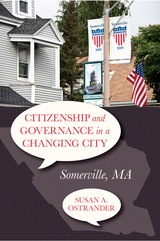 Citizenship and Governance in a Changing City: Somerville, MA
Susan Ostrander
Temple University Press, 2013 Overcoming a past of deteriorating homes, empty storefronts, and corrupt city administrations, Somerville, Massachusetts, just outside of Boston, today proudly defines itself as a longtime immigrant city, a historically blue collar town, and a hip new urban center with a progressive city government.
In Citizenship and Governance in a Changing City, Susan Ostrander shows how beneath current high levels of engagement by Somerville residents lies a struggle about who should be the city's elected leaders and how they should conduct the city's affairs. It is a struggle waged between diverse residents--relatively new immigrants and a new middle class-trying to gain a foothold in democratic participation, and the city's political "old guard."
Citizenship and Governance in a Changing City informs current debates about the place of immigrants in civic and political life, and the role of voluntary associations in local politics and government. In the process, Ostrander provides useful lessons for many midsize urban communities.
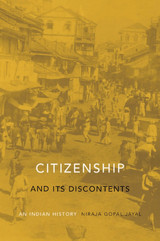 Citizenship and Its Discontents: An Indian History
Niraja Gopal Jayal
Harvard University Press, 2013 Breaking new ground in scholarship, Niraja Jayal writes the first history of citizenship in the largest democracy in the world—India. Unlike the mature democracies of the west, India began as a true republic of equals with a complex architecture of citizenship rights that was sensitive to the many hierarchies of Indian society. In this provocative biography of the defining aspiration of modern India, Jayal shows how the progressive civic ideals embodied in the constitution have been challenged by exclusions based on social and economic inequality, and sometimes also, paradoxically, undermined by its own policies of inclusion.
Citizenship and Its Discontents explores a century of contestations over citizenship from the colonial period to the present, analyzing evolving conceptions of citizenship as legal status, as rights, and as identity. The early optimism that a new India could be fashioned out of an unequal and diverse society led to a formally inclusive legal membership, an impulse to social and economic rights, and group-differentiated citizenship. Today, these policies to create a civic community of equals are losing support in a climate of social intolerance and weak solidarity. Once seen by Western political scientists as an anomaly, India today is a site where every major theoretical debate about citizenship is being enacted in practice, and one that no global discussion of the subject can afford to ignore.
Citizenship and Nationhood in France and Germany
Rogers Brubaker
Harvard University Press, 1992 The difference between French and German definitions of citizenship is instructive—and, for millions of immigrants from North Africa, Turkey, and Eastern Europe, decisive. Rogers Brubaker shows how this difference—between the territorial basis of the French citizenry and the German emphasis on blood descent—was shaped and sustained by sharply differing understandings of nationhood, rooted in distinctive French and German paths to nation-statehood.
Citizenship and Those Who Leave: The Politics of Emigration and Expatriation
Edited by Nancy L. Green and Fran‡ois Weil
University of Illinois Press, 2006 Exit, like entry, has helped define citizenship over the last two centuries, yet little attention has been given to the politics of emigration. How have countries impeded or facilitated people leaving? How have they perceived and regulated those who leave? What relations do they seek to maintain with their citizens abroad and why? Citizenship and Those Who Leave reverses the immigration perspective to examine how nations define themselves not just through entry but through exit as well.
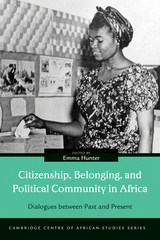 Citizenship, Belonging, and Political Community in Africa: Dialogues between Past and Present
Emma Hunter
Ohio University Press, 2016 Africa, it is often said, is suffering from a crisis of citizenship. At the heart of the contemporary debates this apparent crisis has provoked lie dynamic relations between the present and the past, between political theory and political practice, and between legal categories and lived experience. Yet studies of citizenship in Africa have often tended to foreshorten historical time and privilege the present at the expense of the deeper past. Citizenship, Belonging, and Political Community in Africa provides a critical reflection on citizenship in Africa by bringing together scholars working with very different case studies and with very different understandings of what is meant by citizenship. By bringing historians and social scientists into dialogue within the same volume, it argues that a revised reading of the past can offer powerful new perspectives on the present, in ways that might also indicate new paths for the future. The project collects the works of up-and-coming and established scholars from around the globe. Presenting case studies from such wide-ranging countries as Sudan, Mauritius, South Africa, Côte d’Ivoire, and Ethiopia, the essays delve into the many facets of citizenship and agency as they have been expressed in the colonial and postcolonial eras. In so doing, they engage in exciting ways with the watershed book in the field, Mahmood Mamdani’s Citizen and Subject. Contributors: Samantha Balaton-Chrimes, Frederick Cooper, Solomon M. Gofie, V. Adefemi Isumonah, Cherry Leonardi, John Lonsdale, Eghosa E.Osaghae, Ramola Ramtohul, Aidan Russell, Nicole Ulrich, Chris Vaughan, and Henri-Michel Yéré.
Citizenship, Democracy and Belonging in Suburban Britain: Making the Local
David Jeevendrampillai
University College London, 2021 Examines how suburbanites form community in the face of neoliberal isolation.
An activist group in outer London’s Surbiton suburb, the Seething Villagers commemorate a fictional local history through tongue-in-cheek community festivals. These admittedly “stupid” gatherings celebrate a mythical village of Seething and its many adventures, including a run-in with a mountain-crushing giant. Citizenship, Democracy and Belonging in Suburban Britain explores how the Seething Villagers and other suburbanite fantasies fashion community in the face of neoliberal isolation. By taking the artists’ playfulness seriously, David Jeevendrampillai demonstrates how suburbanites develop fellow-feeling without access to traditional community centers.
Citizenship, Faith, and Feminism: Jewish and Muslim Women Reclaim Their Rights
Jan Feldman
Brandeis University Press, 2011 Religious women in liberal democracies are “dual citizens” because of their contrasting status as members of both a civic community (in which their gender has no impact on their constitutional guarantee of equal rights) and a traditional religious community (which distributes roles and power based on gender). This book shows how these “dual citizens”—Orthodox Jewish women in Israel, Muslim women in Kuwait, and women of both those faiths in the U.S.—have increasingly deployed their civic citizenship rights in attempts to reform and not destroy their religions. For them, neither “exit” nor acquiescence to traditional religious gender norms is an option. Instead, they use the narrative of civic citizenship combined with a more authentic, if alternative reading of their faith tradition to improve their status.
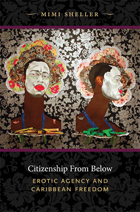 Citizenship from Below: Erotic Agency and Caribbean Freedom
Mimi Sheller
Duke University Press, 2012 Citizenship from Below boldly revises the history of the struggles for freedom by emancipated peoples in post-slavery Jamaica, post-independence Haiti, and the wider Caribbean by focusing on the interplay between the state, the body, race, and sexuality. Mimi Sheller offers a new theory of "citizenship from below" to describe the contest between "proper" spaces of legitimate high politics and the disavowed politics of lived embodiment. While acknowledging the internal contradictions and damaging exclusions of subaltern self-empowerment, Sheller roots out from beneath the historical archive traces of a deeper freedom, one expressed through bodily performances, familial relationships, cultivation of the land, and sacred worship. Attending to the hidden linkages among intimate realms and the public sphere, Sheller explores specific struggles for freedom, including women's political activism in Jamaica; the role of discourses of "manhood" in the making of free subjects, soldiers, and citizens; the fiercely ethnonationalist discourses that excluded South Asian and African indentured workers; the sexual politics of the low-bass beats and "bottoms up" moves in the dancehall; and the struggle for reproductive and LGBT rights and against homophobia in the contemporary Caribbean. Through her creative use of archival sources and emphasis on the connections between intimacy, violence, and citizenship, Sheller enriches critical theories of embodied freedom, sexual citizenship, and erotic agency in all post-slavery societies.
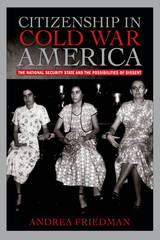 Citizenship in Cold War America: The National Security State and the Possibilities of Dissent
Andrea Friedman
University of Massachusetts Press, 2014 In the wake of 9/11, many Americans have deplored the dangers to liberty posed by a growing surveillance state. In this book, Andrea Friedman moves beyond the standard security/liberty dichotomy, weaving together often forgotten episodes of early Cold War history to reveal how the obsession with national security enabled dissent and fostered new imaginings of democracy.
The stories told here capture a wide-ranging debate about the workings of the national security state and the meaning of American citizenship. Some of the participants in this debate—women like war bride Ellen Knauff and Pentagon employee Annie Lee Moss—were able to make their own experiences compelling examples of the threats posed by the national security regime. Others, such as Ruth Reynolds and Lolita Lebrón, who advocated an end to American empire in Puerto Rico, or the psychiatrist Fredric Wertham, who sought to change the very definition of national security, were less successful. Together, however, they exposed the gap between democratic ideals and government policies.
Friedman traverses immigration law and loyalty boards, popular culture and theoretical treatises, U.S. court-rooms and Puerto Rican jails, to demonstrate how Cold War repression made visible in new ways the unevenness and limitations of American citizenship. Highlighting the ways that race and gender shaped critiques and defenses of the national security regime, she offers new insight into the contradictions of Cold War political culture.
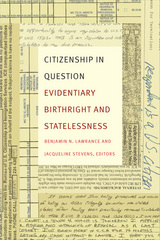 Citizenship in Question: Evidentiary Birthright and Statelessness
Benjamin N. Lawrance and Jacqueline Stevens, editors
Duke University Press, 2017 Citizenship is often assumed to be a clear-cut issue—either one has it or one does not. However, as the contributors to Citizenship in Question demonstrate, citizenship is not self-evident; it emerges from often obscure written records and is interpreted through ambiguous and dynamic laws. In case studies that analyze the legal barriers to citizenship rights in over twenty countries, the contributors explore how states use evidentiary requirements to create and police citizenship, often based on fictions of racial, ethnic, class, and religious differences. Whether examining the United States’ deportation of its own citizens, the selective use of DNA tests and secret results in Thailand, or laws that have stripped entire populations of citizenship, the contributors emphasize the political, psychological, and personal impact of citizenship policies. Citizenship in Question incites scholars to revisit long-standing political theories and debates about nationality, free movement, and immigration premised on the assumption of clear demarcations between citizens and noncitizens.
Contributors. Alfred Babo, Jacqueline Bhabha, Jacqueline Field, Amanda Flaim, Sara L. Friedman, Daniel Kanstroom, Benjamin N. Lawrance, Beatrice McKenzie, Polly J. Price, Rachel E. Rosenbloom, Kim Rubenstein, Kamal Sadiq, Jacqueline Stevens, Margaret D. Stock
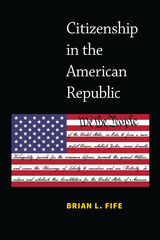 Citizenship in the American Republic
Brian L. Fife
University of Michigan Press, 2021 The Constitution has governed the United States since 1789, but many Americans are not aware of the structural rules that govern the oldest democracy in the world. Important public policy challenges require a knowledgeable, interested citizenry able to address the issues that represent the rich pageantry of American society. Issues such as climate change, national debt, poverty, pandemics, income inequality, and more can be addressed sufficiently if citizens play an active role in their own republic. Collectively, citizens are vulnerable to exploitation and manipulation if we place limits on our individual political knowledge. A more informed, engaged citizenry can best rise to the great policy challenges of contemporary society and beyond.
Brian L. Fife provides readers with essential information on all aspects of American politics, showing them how to use political knowledge to shape the future of the republic. Activist citizens are the key to making the United States a more vibrant democracy. Fife equips citizens and would-be citizens with the tools and understanding they need to engage fully in the political process. At the end of each chapter, he analyzes why citizenship matters and how citizens can use that chapter’s material in their own lives. Fife also provides readers with a citizen homework section that presents web links to further explore issues raised in each chapter.
Citizenship Policies in the New Europe: Expanded and Updated Edition
Edited by Rainer Bauböck, Bernhard Perchinig, and Wiebke Sievers
Amsterdam University Press, 2009
The two most recent expansions to the EU, in May 2004 and January 2007, have had a significant impact on contemporary conceptions of statehood, nation-building, and citizenship within the Union. This volume outlines the citizenship laws in each of the twelve new countries as well as in the accession states of Croatia and Turkey.
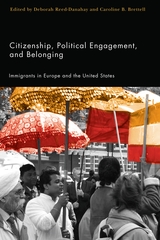 Citizenship, Political Engagement, and Belonging: Immigrants in Europe and the United States
Reed-Danahay, Deborah
Rutgers University Press, 2008 Immigration is continuously and rapidly changing the face of Western countries. While newcomers are harbingers of change, host nations also participate in how new populations are incorporated into their social and political fabric.
Bringing together a transcontinental group of anthropologists, this book provides an in-depth look at the current processes of immigration, political behavior, and citizenship in both the United States and Europe. Essays draw on issues of race, national identity, religion, and more, while addressing questions, including: How should citizenship be defined? In what ways do immigrants use the political process to achieve group aims? And, how do adults and youth learn to become active participants in the public sphere?
Among numerous case studies, examples include instances of racialized citizenship in “Algerian France,” Ireland’s new citizenship laws in response to asylum-seeking mothers, the role of Evangelical Christianity in creating a space for the construction of an identity that transcends state borders, and the Internet as one of the new public spheres for the expression of citizenship, be it local, national, or global.
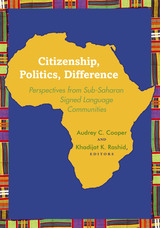 Citizenship, Politics, Difference: Perspectives from Sub-Saharan Signed Language Communities
Audrey C. Cooper
Gallaudet University Press, 2015 Sub-Saharan Africa is one of the most linguistically, culturally, and geographically diverse regions of the world, home to more than 2,000 languages. As in the rest of the world, Deaf people live throughout the widely varying sub-Saharan communities, equally rich in their signed languages. An emergent body of scholarly research on sub-Saharan signed languages (SSSL) and related Deaf community organizing has created the opportunity to gather together the informed perspectives presented in this revolutionary collection. Drawing examples from all regions of sub-Saharan Africa—Western, Eastern, Central, and Southern—16 contributors join the volume editors in illuminating the circumstances pertaining to cross-border, cross-regional, and global engagements in sub-Saharan Deaf communities.
This collection centers upon two interrelated purposes: to examine sub-Saharan African deaf people’s perspectives on citizenship, politics, and difference in relation to SSSL practices, and to analyze SSSL practices in relation to sociopolitical histories and social change interests (including addressing aspects of culture, gender, language usage, race, ethnicity, sexuality, and ability). The editors have organized these themes under three main sections, Sub-Saharan Signed Languages and Deaf Communities, The Politics of Mobilizing Difference, and Citizenship. Such wide-ranging subjects as the ethics of studying Kenyan signed language, sign language and Deaf communities in Eritrea, and overcoming cultural and linguistic barriers to HIV/AIDS education drive home the importance of the unique and varied research in this collection.
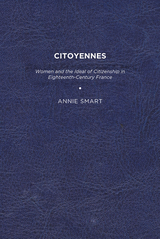 Citoyennes: Women and the Ideal of Citizenship in Eighteenth-Century France
Annie K. Smart
University of Delaware Press, 2012 Did women have a civic identity in eighteenth-century France? In Citoyennes: Women and the Ideal of Citizenship in Eighteenth-Century France, Annie Smart contends that they did. While previous scholarship has emphasized the ideal of domestic motherhood or the image of the republican mother, Smart argues persuasively that many pre-revolutionary and revolutionary texts created another ideal for women–the ideal of civic motherhood. Smart asserts that women were portrayed as possessing civic virtue, and as promoting the values and ideals of the public sphere. Contemporary critics have theorized that the eighteenth-century ideal of the Republic intentionally excluded women from the public sphere. According to this perspective, a discourse of “Rousseauean” domestic motherhood stripped women of an active civic identity, and limited their role to breastfeeding and childcare. Eighteenth-century France marked thus the division between a male public sphere of political action and a female private sphere of the home. Citoyennes challenges this position and offers an alternative model of female identity. This interdisciplinary study brings together a variety of genres to demonstrate convincingly that women were portrayed as civic individuals. Using foundational texts such as Jean-Jacques Rousseau’s Emile, or on Education (1762), revolutionary gouaches of Lesueur, and vaudeville plays of Year II of the Republic (1793/1794), this study brilliantly shows that in text and image, women were represented as devoted to both the public good and their families. In addition, Citoyennes offers an innovative interpretation of the home. Through re-examining sphere theory, this study challenges the tendency to equate the home with private concerns, and shows that the home can function as a site for both private life and civic identity. Citoyennes breaks new ground, for it both rectifies the ideal of domestic Rousseauean motherhood, and brings a fuller understanding to how female civic identity operated in important French texts and images. Published by University of Delaware Press. Distributed worldwide by Rutgers University Press.
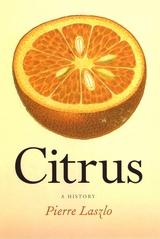 Citrus: A History
Pierre Laszlo
University of Chicago Press, 2007 Walk into your local grocery store and down the produce aisle, and you’ll find a dazzling array of citrus, from navel oranges and clementines to grapefruit and key limes—and sometimes even more exotic fare like the Japanese yuzu or the baboon lemon. Nearly 100 million tons of citrus are produced globally every year, but where did these fruits first come from? How did they find their way into the Western world? And how did they become both a culinary and cultural phenomenon?
Pierre Laszlo here traces the spectacular rise and spread of citrus across the globe: from Southeast Asia in 4000 BC through North Africa and the Roman Empire to early modern Spain and Portugal, whose explorers introduced the fruits to the Americas during the 1500s. Blending scientific rigor with personal curiosity, Citrus ransacks over two millennia of world history, exploring the numerous roles that citrus has played in agriculture, horticulture, cooking, nutrition, religion, and art—from the Jewish feast of the Tabernacles through the gardens and courts of Versailles to the canvasses of Vincent van Gogh to the orange groves of southern California and the juicing industry of today.
“Laszlo . . . has approached the lore of citrus fruit with the élan of a master chef (the man is French, after all), mixing history, economics, biology and chemistry to produce a book that will bring a smile to readers of every taste.”—Natural History
“Altogether charming, eccentric, erudite, and definitely worth the price.”—Times Higher Education Supplement
“Stimulating. . . . Laszlo shows that the citrus fruit ‘is a treasure trove of chemicals that are highly useful to humankind’—which also happens to taste wonderful.”—Sunday Times (UK)
“A short but brilliant account of 6,000 years of citrus fruits that should be devoured with fervor.”—Financial Times
“Did you know there are a billion citrus trees under cultivation, or that grapefruit juice may potentiate the effects of Viagra? Citrus mines over two millennia of history to explore the spread of these fruits out of Asia, their commercialization in the United States, and enduring symbolism the world over.”—New Scientist
The City
Robert E. Park and Ernest W. Burgess
University of Chicago Press, 1984 The City, first published in 1925 and reprinted here in its entirety, is a cross-section of concerns of the Chicago urban school during the period of its most intense activity. Park and Burgess realized that ecological and economic factors were converted into a social organization by the traditions and aspirations of city dwellers. In their efforts to achieve objectivity, these sociologists never lost sight of the values that propel human beings.
"It is a classic which remains relevant largely because it poses questions still unresolved."—Choice
The City
Robert E. Park and Ernest W. Burgess
University of Chicago Press, 2019 First published in 1925, The City is a trailblazing text in urban history, urban sociology, and urban studies. Its innovative combination of ethnographic observation and social science theory epitomized the Chicago school of sociology. Robert E. Park, Ernest W. Burgess, and their collaborators were among the first to document the interplay between urban individuals and larger social structures and institutions, seeking patterns within the city’s riot of people, events, and influences. As sociologist Robert J. Sampson notes in his new foreword, though much has changed since The City was first published, we can still benefit from its charge to explain where and why individuals and social groups live as they do.
The City
Valerian Pidmohylnyi
Harvard University Press, 2024 Valerian Pidmohylnyi’s The City was a landmark event in the history of Ukrainian literature. Written by a master craftsman in full control of the texture, rhythm, and tone of the text, the novel tells the story of Stepan, a young man from the provinces who moves to the capital of Ukraine, Kyiv, and achieves success as a writer through a succession of romantic encounters with women.
At its core, the novel is a philosophical search for harmony in a world where our intellectual side expects rational order, whereas the instinctive natural world follows its own principles. The resulting alienation and disorientation reflect the basic principles of existential philosophy, in which Pidmohylnyi is close to his European counterparts of the day.
The City
Robert E. Park and Ernest W. Burgess
University of Chicago Press, 2019 This is an auto-narrated audiobook version of this book.
First published in 1925, The City is a trailblazing text in urban history, urban sociology, and urban studies. Its innovative combination of ethnographic observation and social science theory epitomized the Chicago school of sociology. Robert E. Park, Ernest W. Burgess, and their collaborators were among the first to document the interplay between urban individuals and larger social structures and institutions, seeking patterns within the city’s riot of people, events, and influences. As sociologist Robert J. Sampson notes in his new foreword, though much has changed since The City was first published, we can still benefit from its charge to explain where and why individuals and social groups live as they do.
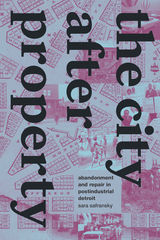 The City after Property: Abandonment and Repair in Postindustrial Detroit
Sara Safransky
Duke University Press, 2023 In The City after Property, Sara Safransky examines how postindustrial decline generates new forms of urban land politics. In the 2010s, Detroit government officials classified a staggering 150,000 lots—more than a third of the city—as “vacant” or “abandoned.” Analyzing subsequent efforts to shrink the Motor City’s footprint and budget, Safransky presents a new way of conceptualizing urban abandonment. She challenges popular myths that cast Detroit as empty along with narratives that reduce its historical decline to capital and white flight. In connecting contemporary debates over neoliberal urbanism to Cold War histories and the lasting political legacies of global movements for decolonization and Black liberation, she foregrounds how the making of—and challenges to—modern property regimes have shaped urban policy and politics. Drawing on critical geographical theory and community-based ethnography, Safransky shows how private property functions as a racialized construct, an ideology, and a moral force that shapes selves and worlds. By thinking the city “after property,” Safransky illuminates alternative ways of imagining and organizing urban life.
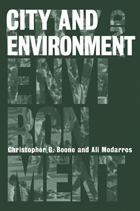 City and Environment
Christopher G. Boone and Ali Modarres
Temple University Press, 2006 For the first time in history, more than half the people of the world live in cities. Comprehending the impact of this widespread urbanization requires an awareness of the complex relationships between cities and natural ecosystems. This innovative book moves beyond the anti-urban lamentations that often dominate today's academic discourse to examine the evolution of cities and to illuminate the roles that humans play in shaping their environments, both natural and constructed. Christopher G. Boone and Ali Modarres argue that understanding the multiple forces of urbanization requires a holistic approach to the interactions of social, cultural, economic, political, and environmental factors. Without casting judgments, City and Environment seeks to engage readers in an exploration of cities from a truly global perspective. Throughout, it illuminates the social-ecological systems of cities not as an academic exercise—although informing academic audiences is one of its goals—but ultimately to help transform cities into livable and ecologically sustainable environments.
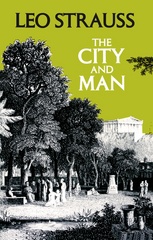 The City and Man
Leo Strauss
University of Chicago Press, 1978 The City and Man consists of provocative essays by the late Leo Strauss on Aristotle's Politics, Plato's Republic, and Thucydides' Peloponnesian Wars. Together, the essays constitute a brilliant attempt to use classical political philosophy as a means of liberating modern political philosophy from the stranglehold of ideology. The essays are based on a long and intimate familiarity with the works, but the essay on Aristotle is especially important as one of Strauss's few writings on the philosopher who largely shaped Strauss's conception of antiquity. The essay on Plato is a full-scale discussion of Platonic political philosophy, wide in scope yet compact in execution. When discussing Thucydides, Strauss succeeds not only in presenting the historian as a moral thinker of high rank, but in drawing his thought into the orbit of philosophy, and thus indicating a relation of history and philosophy that does not presuppose the absorption of philosophy by history.
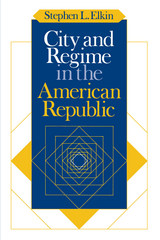 City and Regime in the American Republic
Stephen L. Elkin
University of Chicago Press, 1987 Stephen L. Elkin deftly combines the empirical and normative strands of political science to make a powerfully original statement about what cities are, can, and should be. Rejecting the idea that two goals of city politics—equality and efficiency—are opposed to one another, Elkin argues that a commercial republic could achieve both. He then takes the unusual step of addressing how the political institutions of the city can help to form the kind of citizenry such a republic needs.
The present workings of American urban political institutions are, Elkin maintains, characterized by a close relationship between politicians and businessmen, a relationship that promotes neither political equality nor effective social problem-solving. Elkin pays particular attention to the issue of land-use in his analysis of these failures of popular control in traditional city politics. Urban political institutions, however, are not just instruments for the dispensing of valued outcomes or devices for social problem-solving—they help to form the citizenry. Our present institutions largely define citizens as interest group adversaries and do little to encourage them to focus on the commercial public interest of the city. Elkin concludes by proposing new institutional arrangements that would be better able to harness the self-interested behavior of individuals for the common good of a commercial republic.
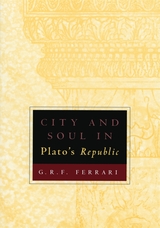 City and Soul in Plato's Republic
G. R. F. Ferrari
University of Chicago Press, 2005 Tracing a central theme of Plato's Republic, G. R. F. Ferrari reconsiders in this study the nature and purpose of the comparison between the structure of society and that of the individual soul. In four chapters, Ferrari examines the personalities and social status of the brothers Glaucon and Adeimantus, Plato's notion of justice, coherence in Plato's description of the decline of states, and the tyrant and the philosopher king—a pair who, in their different ways, break with the terms of the city-soul analogy.
In addition to acknowledging familiar themes in the interpretation of the Republic—the sincerity of its utopianism, the justice of the philosopher's return to the Cave—Ferrari provocatively engages secondary literature by Leo Strauss, Bernard Williams, and Jonathan Lear. With admirable clarity and insight, Ferrari conveys the relation between the city and the soul and the choice between tyranny and philosophy. City and Soul in Plato's Republic will be of value to students of classics, philosophy, and political theory alike.
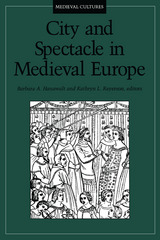 City and Spectacle in Medieval Europe
Barbara Hanawalt
University of Minnesota Press, 1994 Medieval Europe is known for its sense of ceremony and drama. Knightings, tournaments, coronations, religious processions, and even private celebrations such as baptisms, weddings, and funerals were occasions for ritual, feasting, and public display. This volume is the first to take a comprehensive look at the many types of city spectacles that entertained the masses and confirmed various messages of power in late medieval Europe. Bringing together leading scholars in history, art history, and literature, this interdisciplinary collection sets new standards for the study of medieval popular culture. Drawing examples from Spain, England, France, Italy, and the Netherlands, most of them in the fifteenth century, the authors explore the uses of ceremony as statements of political power, as pleas for divine intercession, and as expressions of popular culture. Their essays show us spectacles meant to confirm events such as victories, the signing of a city charter, or the coronation of a king. In other circumstances, the spectacle acts as a battleground where a struggle for the control of the metaphors of power is played out between factions within cities or between cities and kings. Still other ceremonies called upon divine spiritual powers in the hope that their intervention might save the urban inhabitants. We see here a public cognizant of the power of symbols to express its goals and achievements, a society reaching the height of sophistication in its manipulation of popular and elite culture for grand shows.
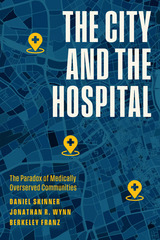 The City and the Hospital: The Paradox of Medically Overserved Communities
Daniel Skinner, Jonathan R. Wynn, and Berkeley Franz
University of Chicago Press, 2023 A surprising look at how hospitals affect and are affected by their surrounding communities.
An enduring paradox of urban public health is that many communities around hospitals are economically distressed and, counterintuitively, medically underserved. In The City and the Hospital two sociologists, Jonathan R. Wynn and Berkeley Franz, and a political scientist, Daniel Skinner, track the multiple causes of this problem and offer policy solutions.
Focusing on three urban hospitals—Connecticut’s Hartford Hospital, the flagship of the Hartford Healthcare system; the Cleveland Clinic, which coordinates with other providers for routine care while its main campus provides specialty care; and the University of Colorado Hospital, a rare example of an urban institution that relocated to a new community—the authors analyze the complicated relationship between a hospital and its neighborhoods. On the one hand, hospitals anchor the communities that surround them, often staying in a neighborhood for decades. Hospitals also craft strategies to engage with the surrounding community, many of those focused on buying locally and hiring staff from their surrounding area. On the other hand, hospitals will often only provide care to the neighboring community through emergency departments, reserving advanced medical care and long-term treatment for those who can pay a premium for it. In addition, the authors show, hospitals frequently buy neighborhood real estate and advocate for development programs that drive gentrification and displacement.
To understand how urban healthcare institutions work with their communities, the authors address power, history, race, and urbanity as much as the workings of the medical industry. These varied initiatives and effects mean that understanding urban hospitals requires seeing them in a new light—not only as medical centers but as complicated urban forces.
|
|
